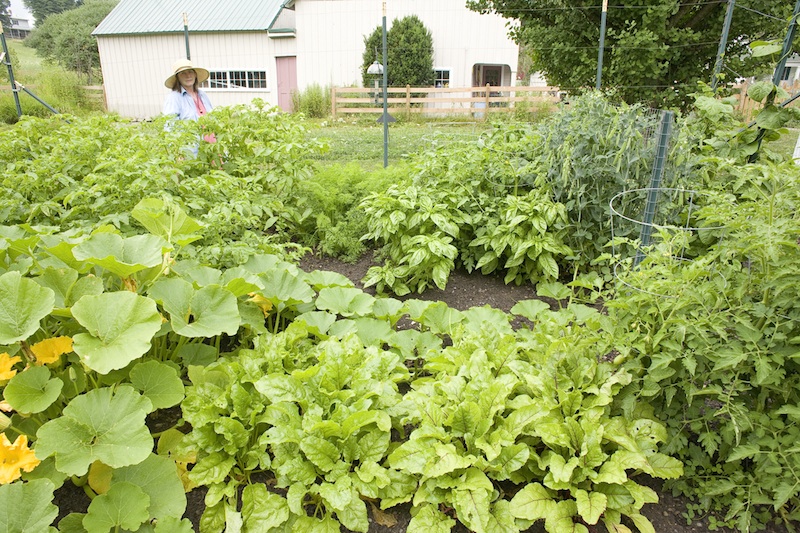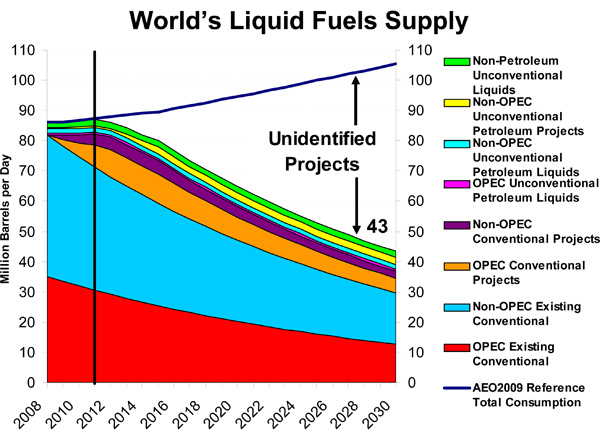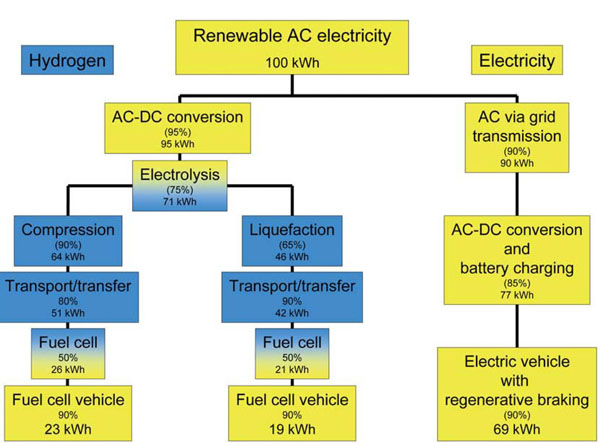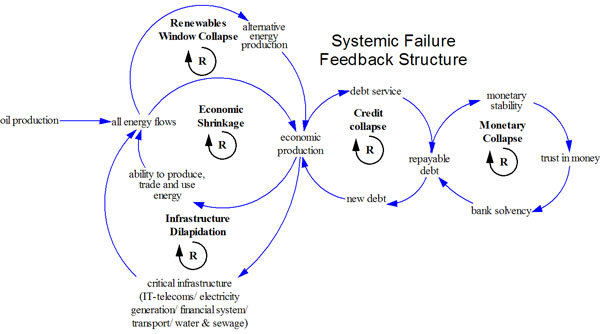GDPR compliance
This site does not track you. I have removed all analytics, and what remains is a log file that rolls over every three days.
The site has become a flat set of HTML files. Some of those files contain comments with personally identifiable information. If you want those comments removed, contact me and I'll make the necessary edits.
By Karl North
Interest in passive solar design, once limited to a few engineers and tinkerers, expanded in the live-lightly-on-the-land movement of the 1970s and even spawned a literature on the subject. Since then, interest has waned to the point where most activity is not getting the public visibility that it deserves.
This trend is unfortunate because as the energy descent from the oil era deepens, the conventional sources of heat in residences will become too expensive. The greater part of residential energy use, at least in cool climates, is for heating for various uses — space heat, hot water, cooking and drying, and cold season growing. Heat from the sun supplemented with wood heat can fulfill all these functions. To do so, housing will need passive solar initial design or makeovers.
The need for these changes is not yet well understood. Human consumption of planetary resources is now coming up against hard physical resource limits, with the following implications for home heating:
All fossil fuels will gradually become too scarce to be affordable for heating[1]
As human society returns to reliance on biomass energy for many purposes, wood and other forms of biomass will become scarcer as well
Unlike direct heat from the sun or biomass burning, other sources including “alternatives” like wind or solar electric heating require technologies that are expensive and energy conversions that waste energy, which makes them too costly for most people
As fossil energy becomes more scarce, economies that currently can produce resource-intensive alternatives will no longer have the industrial capacity to provide these technologies at the necessary scale. The only answer is to use lower cost technologies.
The heroes of the old era were builders of the technologies with the most power, regardless of how much of the earth’s finite resources they consumed. The heroes of the new era will be rebels against resource depletion, people who build and share technologies that serve basic human needs of food and shelter with the least consumption of the earth’s scarce resources.
The time is therefore right for renewed pursuit of passive solar design, a low-technology heat source for the new era. Seeking a relatively low-technology existence, in the last four decades I have constructed or rebuilt three farmhouses using passive solar designs, each adapted to different environments, available materials, and my pursuit of low-input farming. This is an attempt to share my design experiences in a way that helps people to find passive solar solutions that fit their circumstances. By covering three projects that span forty years of personal history, this saga exposes a learning process that may help the general public think about how to make their heating costs more affordable. While not intended to be a how-to manual, it hopefully will persuade non-professionals that they can work out their own energy solutions.
My account differs from many in several respects. First, it emphasizes relatively inexpensive solutions, many of which are accessible to amateur owner-builders. The first two projects were achieved with little cash outlay. They are examples of models that are increasingly valuable as the end of the era of cheap energy imposes a search for simpler solutions to such basic necessities as food and shelter. The fact that I have no training or experience as a professional builder or architect may give encouragement to others who consider this kind of building project. Second, other accounts, often written by engineers, demand extensive mathematical calculation. In the end their calculations still fail to capture the many considerations that are specific to each building project. In my experience, beyond a small number of critical dimensions and proportions that I cite in the tables and text, a good understanding of the principles of passive solar design and of the environmental conditions of the building site are sufficient to guide design within the constraints of what the owner can afford. Finally, this account reflects the potential, in a world where everything is connected, to solve problems like home energy use by designing elements to serve multiple functions as part of an integrated whole. Thus the total effect of the essential elements of passive solar design listed below will be limited by its weakest one. For example, extra investment in high quality windows is justified only if all other elements are built to the same standard.
A Review of Design Essentials
Here is a reminder of the main elements of effective passive solar design to help the reader evaluate the relative success of each of the construction projects to be described. A glossary at the end of this account provides brief definitions of words underlined in the text but does assume that the reader has an introductory knowledge of the concepts of passive solar design. I will cover details of the principles involved as they apply differently to each house. The essentials are:
A landscape that shelters the house from prevailing winds.
A compact house plan whose south side is roughly twice the area of the east or west sides.
A high percentage of south-facing glass that combines insulating value (R value) with high solar heat gain (e.g., double-paned uncoated thermopane).
Heavy insulation everywhere that heat could escape to the outdoors.
Movable insulation on windows to limit heat escape in sunless times.
Sufficient thermal mass to allow capture and storage of excess heat for use in sunless hours.
Overhangs to shade windows from the summer sun.
Air-tightness and related controls of ventilation.
A means of heat redistribution throughout the living space.
The most efficient and sustainable source of supplemental heat possible (usually local firewood).
Project 1: Canaveilles, Pyrénées Orientales, France
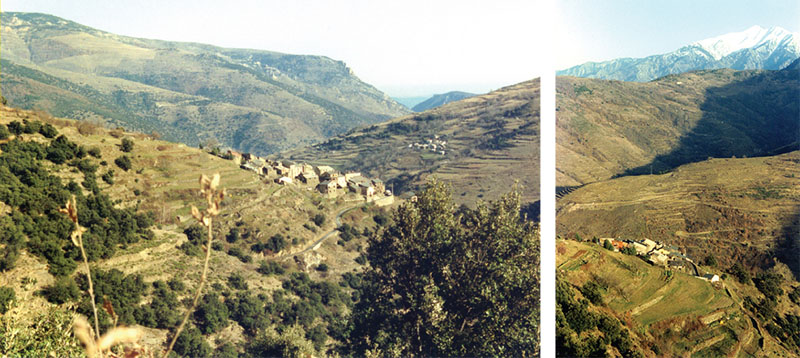
Figure 1. The Village of Canaveilles
In the attempt to flee responsibilities of citizenship in a country that had used weapons of mass destruction to commit genocide and horrific environmental damage in poor, Third World countries of Southeast Asia, in 1973 I left an academic career path and moved with my wife and children to begin an agrarian life in a small village in the mountains of French Catalonia. The houses of the region, with their thick stone and clay walls and heavy slate roofs, are a testament to a bygone age of heroic struggle and tenacity in an intensely sunlit but difficult terrain, using primarily the simple materials that the mountain offered in abundance. Nearly abandoned after centuries of peasant subsistence farming, the village of Canaveilles, located at an altitude of 3500 ft, offered one of these houses and a barn, all attached to other houses in the clustered style of villages of old Europe. We bought the house and barn next door and began to rebuild it as we learned to farm the narrow terraces of the steep Mediterranean mountainside.
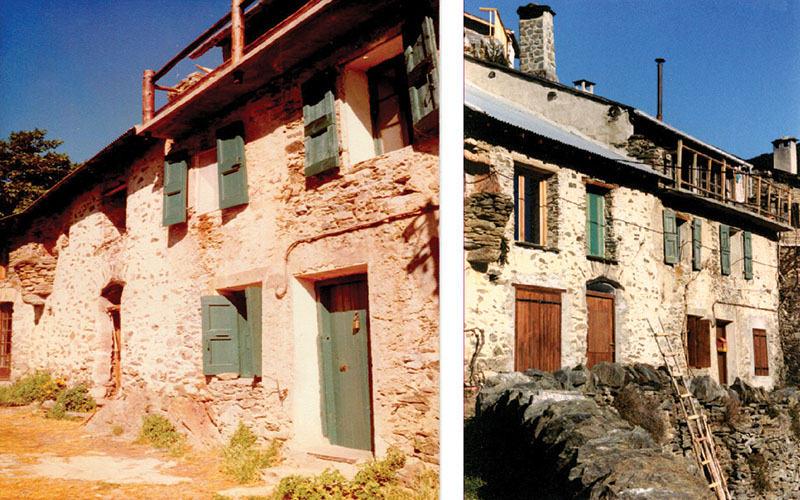
Figure 2. South face of farmhouse in Canaveilles with third storey reconstruction for passive solar heating
Insulation and Thermal Mass. The house offered some ideal requisites of passive solar design. The front wall had full southern exposure to the intense sun of the region, but being two feet thick, it kept out the both summer heat and the freezing temperatures of winter nights. The earth sheltered house has long been a favorite of energy efficient house designers. This house, in fact the whole street, was as if built to order. The north wall, chipped into the mountainside, provided the insulation equivalent of an endless earth berm. The side walls, shared with the neighbors, also supplied the high insulation values that are necessary to passive solar design. The mountainside behind the village sheltered it from the prevailing winds. All these elements in combination with the forgiving Mediterranean climate (shirtsleeve temperatures on cloudless winter days) reduced the solar heat requirement and made our first design project easier.
Compared to recommendations for thermal mass in the passive solar literature, the centuries-old, massive stone walls of this dwelling were overkill. The experience taught us that no amount of excess thermal mass hurts house performance. Our rule of thumb learned in practice has been to cover as much of the south side of a house with glass as we could afford, then build in enough heat storage to handle the solar capture capacity of the south glass area.
Solar Glazing. Traditional construction in the village had minimized window area, partly because the local subsistence farmers could not afford much glass, and partly because property was taxed according to window area. So our main task was to increase the glass area in the south face. Instead of the arduous task of tearing out thick stone walls, we chose to raise the roof (which needed replacing) on the third story garret and make that floor into our main living space, solarizing it with glass all across the front and adding a balcony.
Building the new living space was an exercise in the use of free and salvage materials, for our finances were no better than those of the remaining villagers. The river bank in the gorge below the village supplied free sand for the mortar to raise the walls. Wall stone came from ruins in the village. Rights as property owners gave us access to timber for beams and rafters in the village communal forest. Work parties of volunteers from around the region helped place the big beams, and helped with the heavy labor of removal of the old slate roof in exchange for room and board. In an abandoned commercial building in the region we found windows at salvage prices, but large enough to be used as French doors, and installed them as the south wall of the living space. I include these details because they illustrate a low-cost approach to building (and to life) that will become increasingly necessary in the post-petroleum era.

Figure 3. House reconstruction using trees from the communal forest and personal labor

Figure 4. Finished reconstruction of third storey as main living space
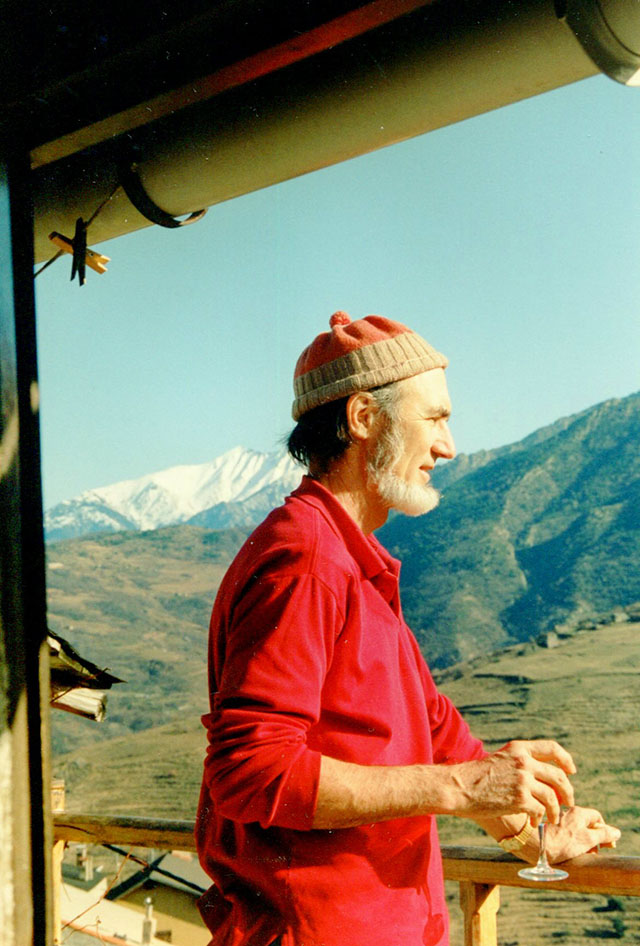
Figure 5. Author on balcony enjoying February sun
Heat Distribution. We used a method that is common in passive solar design for effective heat distribution — an open, partitionless plan of the living space to serve multiple functions: cooking, dining, sitting, and a loft as a guest sleeping area. Supplementary heat came from a small wood-fired kitchen range at one end of the space and a hooded fireplace in the local Catalan style at the other. The thick stone walls kept temperatures in the lower floors warm enough in winter and cool enough in summer for sleeping and storage with no need for solar or other heating.
The weakest part of the design was the roofing, which had to be cheap asphalt tiles, as we had not the consummate skill necessary to put back the slate roof. We could not afford a plywood deck, so we used cheap planks, which were not airtight, and no insulation. In a colder climate these would have been major defects. The main problem with the new roof in the climate of southern France was lack of protection from the summer heat.
The climate in the Eastern Pyrénées is mild enough that we could forego insulating glass and movable insulation on the glass front. Instead it needed drapes and a substantial roof overhang to protect the living space from the heat of the summer sun. Despite freezing winter temperatures at night and on cloudy days, the need for supplemental heating was low enough that firewood could be sawed and split by hand. The huge thermal mass of the house was more than sufficient to maintain warmth in winter and keep the house cool in summer, but would have worked better had we been able to insulate the roof, or reinstall the slate roof on a thick bed of clay, in the tradition of the region. The experience taught us not to take lightly centuries-old construction traditions.
Having been brought up in wooden houses, we found the experience of living within the permanence, security, and quiet of massive masonry walls unforgettable. Similarly, the feeling of being almost outdoors that the wall of French doors conveyed, in combination with the balcony just outside affording a spectacular panorama of a gorge rising to often snow-capped peaks, made living in the renovated house in Canaveilles a special experience. The French doors, the balcony, earth berms, and masonry walls were design elements that we would try, with varying success, to carry on to the next passive solar farmhouse project in upstate New York.
Project 2: Freetown Corners, New York
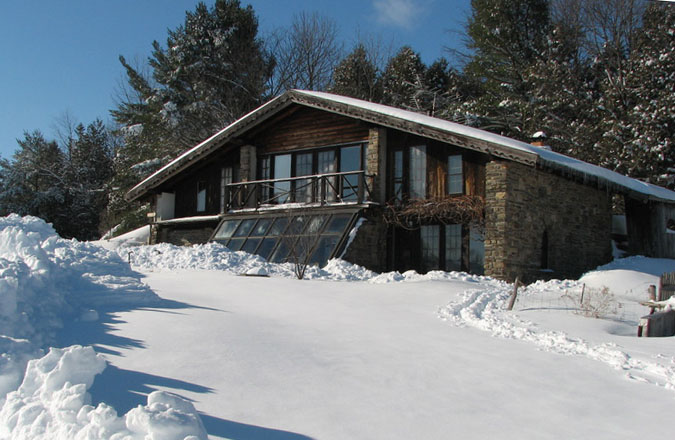
Figure 6. The farmhouse in Freetown Corners
In 1980 we moved from apprenticeship with low-input farming and building in France to commercial farming in the US. Purchase of empty, long-abandoned farmland gave us a clean slate with which to design and build. We were accustomed to the fairy-tale quality of old European villages and farms that nestled naturally into the countryside, a consequence of a long process of adaptation whereby human habitat finds its best “fit” both to the lay of the land and to the aesthetic needs of the inhabitants. The planner of a small farm has an opportunity that is unusual in our industrial age to design both an enterprise and a habitat that is satisfyingly human in scale. A farmhouse, barns, and farm-stead layout built to complement and celebrate the natural beauty of the spot rather than conquer it are a joy to live and work in, and this was our plan. We had enough capital from the sale of the house in France to cover construction of a farmhouse because we furnished most of the labor, contracted to thin state forest plantings for low-cost saw logs, collected local stone from old walls, and bought used windows, doors, and other fixtures at salvage prices.
The Landscape. The colder, almost continental climate of Central New York required the fullest implementation of passive solar design principles. A first energy efficiency design problem on our windswept hilltop land was to locate the farmhouse and buildings in a place sheltered from the prevailing winds. This we accomplished with some effort by building in the lee of a small evergreen woods a quarter of a mile back from the road and by planting a shelter belt of spruce and pine saplings in the adjoining hedgerow. Putting the center of operations out of the winter wind chill was well worth building the extra lane, for it made the house easier to heat and our winter farm work enjoyable.
Thermal Mass. Our intent was to build a mostly masonry residence, for its thermal mass and for the other qualities we had discovered in European architecture. We also incorporated the dug-in feature of the Canaveilles house, which in this site meant partially covering the back and one side wall with earth berms.
The masonry consists of an insulated stone floor on the ground level and a shell of concrete block on three sides, insulated heavily on the outside and covered with a second wall of stone where walls were not earth-sheltered. We left rafters and beams as whole logs for strength and to save sawmill costs. Another staple of European architecture that we managed to incorporate was arched openings. We built them the traditional way in the laid stone walls, and in the block walls we poured concrete into forms, using a piece of sheet metal in the bottom of the form, curved in the shape of an arch. At this point people said that the structure looked like a large bird spreading its wings either for take-off or to defend a brood.
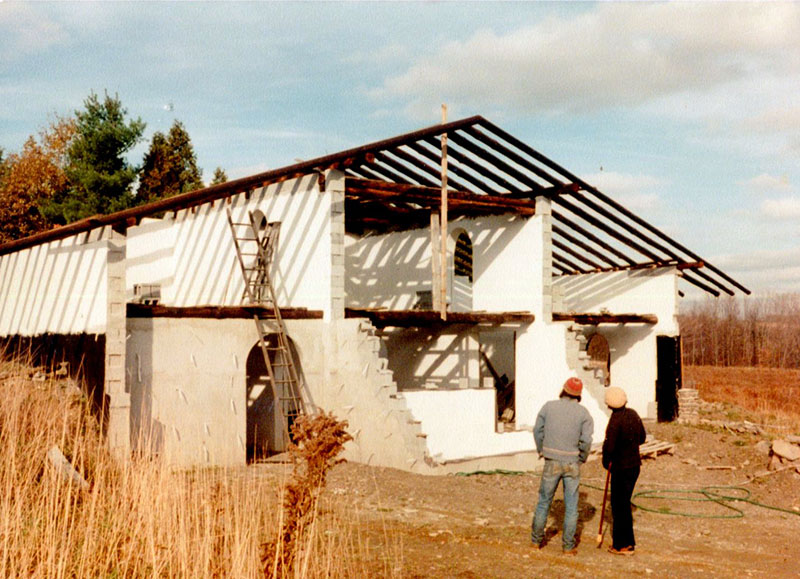
Figure 7. Dry-laid block and bonding cement make strong walls fast
Solar Glazing. An attached solar greenhouse was a major addition to our solar building experience. It merits careful treatment here because such a structure poses unique design challenges. Our passive solar plan was to cover most of the front, south-facing wall with glass. We are convinced that an attached greenhouse is an essential of passive solar design because of its multiple functions. Built to the same design standard for insulation and double glazing, a greenhouse can capture as much heat as other south windows, without overheating the main living space. Designed with slanted glass, it provides even more heat to the interior than vertical glass because for most of the year the sun hits it more directly. The extra sunlight from slanted glass is often too much in the living space of a house, but it improves three potential functions of a greenhouse — to indirectly heat the house, to grow food and flowers, and to provide solar heated water. Finally, provision for many plants in a house freshens inside air: plants and animals have a symbiotic respirational relationship; the stale exhale of each is the fresh air to inhale of the other.
We sank our greenhouse four feet below grade to serve several purposes. It creates a shaded space along the front for plants that require more indirect light. It allows taller plants and a stepped set of growing benches that makes better use of the space and light. And, like the earth berms on other house walls, it adds the insulation value of the ambient earth temperature and reduces insulation costs for the underground parts of the walls.
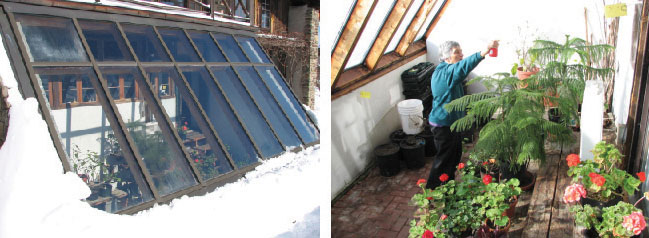
Figure 8. The professionally reglazed New York greenhouse
Although slanted glass lets in more heat than vertical glass, it has drawbacks that are an important design consideration. More exposed to the weather than vertical glass, it takes more construction skill and expense to make it weather tight. Our original construction of salvage glass on an entirely wood frame served the purpose well for 15 years. But leaks and rot in the frame took their toll, and when we could afford it, we replaced the front frame, roof, and glass with a professional job. It has lasted many years with virtually no deterioration but was much more expensive. The present version shown in the photos consists of:
High quality, relatively rot proof framing wood.
Thermopane double glazing.
Special hardware for the glass to ride on as it expands and contracts at a different rate from the frame in the typically wild swings of greenhouse temperatures.
A sheet metal external skin for further weather protection.
Movable insulation is also more of a challenge with slanted glass. Placed inside, it is harder to move and in many cases subject to soaking with window condensation. Placed outside, it needs to be weather proof and easily movable and cleanable of snow and ice. We chose not to insulate, but without it the greenhouse temperature drops to 40 °F at night and takes longer to reheat and to begin heating the house on sunny winter days. This makes the greenhouse less of a source of heat for the house than it would be with movable insulation. As nearly half the south-facing glass is in the greenhouse, we now see this as a major design flaw. There are of course technological solutions to these problems (motorized operation, specialized insulation materials and hardware), but not ones we could afford at the time.
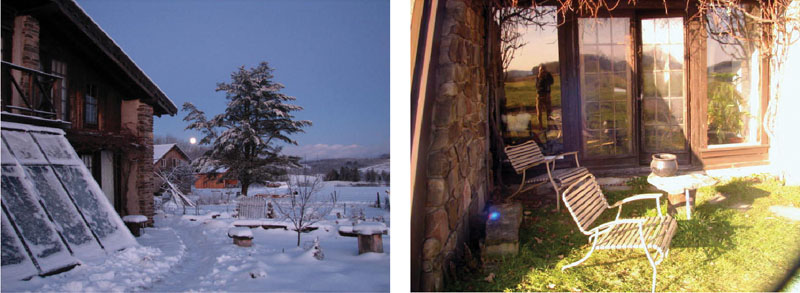
Figure 9. Sloped glass gathers snow (left); grapevine shades let light through in winter (right)
To alleviate the problem, we designed the common wall between the greenhouse and the main house to include openable windows to light the kitchen and to control transfer of heat between the two spaces. Like movable insulation, these openings must be managed almost daily but work well. Sloped glass collects snow but is easily swept with a long-handled push broom. It also needs a shade cloth cover against the summer heat.
Our building plan for the farmhouse called for 400 ft2 of glass, mostly placed on the south side. To stay within budget, we acquired used glass: standard 3’x6’ thermopanes whose seals had broken and let in dirt over years of use and several sets of used French doors obtained through a want ad. We separated the thermopanes into single panes to clean them and to have enough to single-glaze all fixed window space. To achieve the double glazing standard of passive solar design, we installed plastic sheeting on wood frames in all these windows. When later we were able to replace these windows with new thermopane, we were gratified to discover that our makeshift originals had kept heat in the house as well as the new ones.
The French doors were a different story. Although performing perfectly their romantic function, they were not built for exterior use, were single-paned, and could not seal well enough to meet the high standard of air-tightness required in energy-efficient design. Our solution to this problem was to close them permanently for the winter, apply weather stripping, and attach a permanent second pane of plexiglass on the exterior.
The house was still not designed to be sufficiently airtight, partly because we had been able to ignore the problem in the relatively mild French climate and did not take it seriously enough in cold New York. The main leaks were around the home-built main external door and in the all-important roof. Here again, there were easy solutions, but at the time they cost more than we thought we could afford. In retrospect I think building an airtight house is important enough to have warranted the extra expense.
Passive Hot Water. Next to heating the house, hot water production is often the largest residential energy consumer. A house designed to be heated by the sun supplemented by firewood can easily incorporate use of the same sources to heat water, so we designed the New York house to take full advantage of these on-site energy sources. The most effective source of winter hot water, common in many houses before the advent of cheap fossil energy, is a wood-fired kitchen range that also heats the house and cooks the food. The best of these are constructed of cast iron to retain heat and incorporate a water jacket in the firebox through which water is piped to heat it. The water jacket is connected by a convection loop to a tank placed above the stove. The fact that water rises when heated causes constant circulation of water in the loop and hot water accumulation in the tank, without an extra pump. As in conventional hot water systems, the tank delivers hot water to sinks and shower because it is part of the pressurized water system of the house.
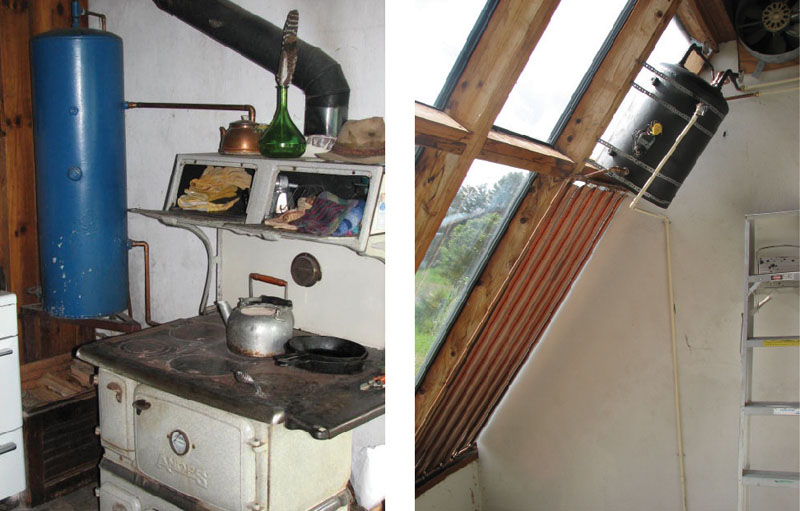
Figure 10. Winter and summer hot water systems (New York house)
The summer hot water system makes use of the slanted glass in this greenhouse and a location protected from heat loss (inside the greenhouse in this case), both of which are necessary to extract enough solar energy to sufficiently heat the water. A flat plate collector, which is an arrangement of pipes with fins to aid solar absorption, connects to a tank above it, and it uses the same convection loop principle as in the winter system to accumulate hot water in the tank. Like the winter system, it is part of the pressurized water system of the house. Most solar hot water collectors must be located outside the house to obtain the proper angle to the sun and need an insulated enclosure and special designs to prevent freezing. This system avoids those costly complications.
Supplemental Heat. Our wood-fired kitchen range built entirely of cast iron (see photo) is second only to a masonry heater in efficiency because of its long smoke path, which allows the cast iron to absorb heat and keep it in the house, then radiate it gradually. Sustainability is high because the stove doubles as a cooking fire for half the year in this climate.
Overhangs. In houses that contain so much sun-trapping glass, overhangs are essential to keep the house from overheating in the summer. The overhangs must extend far enough to shade the glass from the high summer sun, but not so much as to block the lower winter sun.
The size of the overhang depends in part on the latitude of the house location, which determines the angle of incidence of the sun. Tables of the angles of incidence at the summer and winter solstices at different latitudes should be basis for designing the amount of overhang. The other design factor is the distance of the overhang above the window, because a higher overhang will shade less. In fact, because the distance of our chalet roof above the second floor center windows varies, it failed to protect them despite a full 4 foot roof overhang, as one can see in the summer photo of the house.
Since an overhang is impractical on slanted glass, we dropped a shade cloth on the greenhouse in the summer. Above the other first floor windows, rather than a roof we built a frame and trained grape vine to cover it with leaves. The winter photo (Figure 9) shows the leafless vine letting in the sun.
Air Control and Heat Distribution. Management of air flow is important in passive solar design, both air entry into the house and its distribution throughout the rooms and through the thermal mass to store heat effectively. Two techniques that we tried did not work well for various reasons, although they are proven concepts. I will describe them briefly because they will play an important role in the third house in this saga.
Our first idea was to provide air to the house through 100 ft of underground 4 inch pipe to locations near the kitchen range and a Rumford fireplace. The long underground passage warms the air to the earth temperature of 45 °F instead of direct entry at much colder average winter air temperatures. Chimney draft from the wood fires draws in the air, helped with a fan as necessary. In a more airtight house, this technique would have worked better. In this house, the fires could more easily draw in air from poorly sealed doors instead.
The other idea was to counteract the heat stratification that can occur in buildings of more than one story, so that upper floors tend to get more heat. This is a typical design problem of passive solar construction, where open floor plans allow warm air to move around the house from its sources, the south windows and wood stoves. Using small fans in two locations, we used the hollow block walls of the New York house as channels to bring the warm air that collected at the top of the house down through the walls and under the stone floor, storing some of it in the masonry on the way. This would have worked better if the air had not lost much of its heat to the walls before it reached the bottom of the house. Two alternative solutions, a building design that controlled air movement between floors, or placement of the heated living space on a higher floor as we did in France, were not possible in New York due to site constraints.
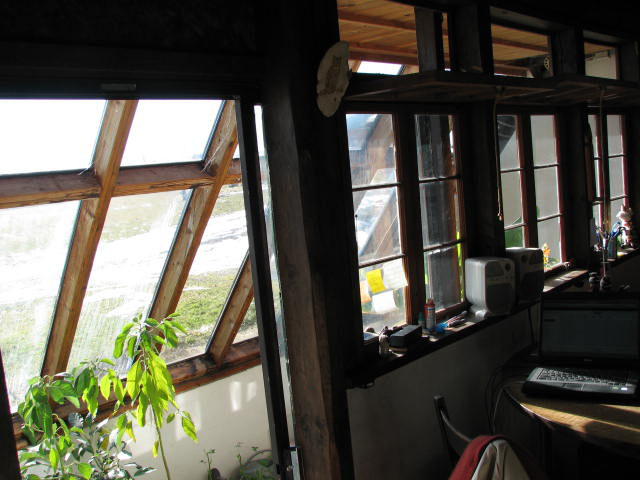
Figure 11. Heat distribution openings between greenhouse and kitchen (New York house)
Movable Insulation. Initially we built light wood frames filled with bubble pack and covered with colored cloth, which fit tightly into the vertical windows. These worked well for years. Eventually they wore out from constant moving, and a specialist in the trade made us insulating quilts that could be let down like Venetian Blinds and clamped on all sides. Because of the irregularities of our rustic construction techniques, none of these solutions were as airtight as we would like, but then the windows themselves were not completely airtight either.
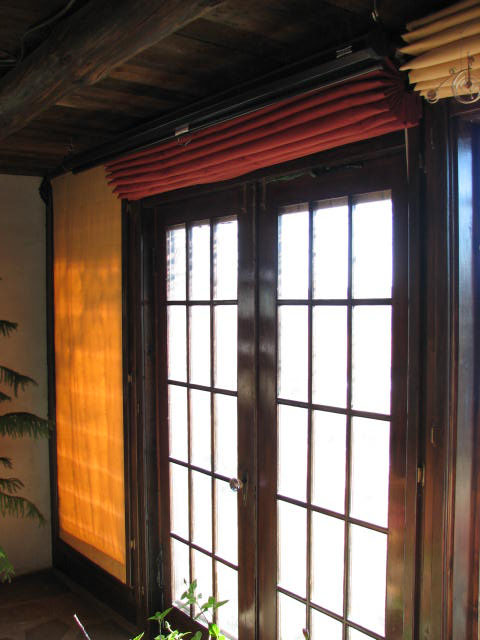
Figure 12. Movable insulation (New York house)
| Heated floor area | 1000 ft2 |
| Wall, foundation and underfloor insulation | R = 28 |
| Roof insulation | R = 35 |
| Thermal mass | Stone floor and 2500 concrete blocks in walls |
| South facing glass | 400 ft2 |
| Other glass (East window) | 10 ft2 |
Table 1. Specifics (New York House)
Despite its limitations, the house performed well enough to completely solar heat itself on sunny, frigid winter days, and used no more than two full cords of supplementary wood heat per year, mostly burned in a vintage, high quality cast iron kitchen range. We paid more attention to dimensions and proportions that are critical to passive solar design than we did in the Mediterranean climate. The table lists these for comparison with the third house that I will describe and with other designs in the literature.
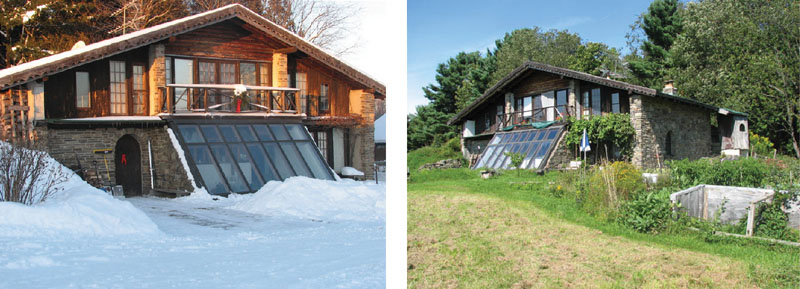
Figure 13. Seasonal views of the New York farmhouse
Most of the limitations of our passive solar plan for the New York farmhouse were deliberate choices to limit costs. In that regard, we succeeded in our goal to build without debt. The cash outlay to build the house, mostly for materials and a small amount of machine labor, was an affordable $15,000 in 1980 dollars. Today the concrete block alone would cost that much.
Project 3. A Professionally Built House in Far Downeast Maine
In 2011 we designed a house for a farmstead two miles from the sea and the Canadian border, and we acted as general contractor to oversee its construction. Although the location is farther north than the New York house, the moderating effect of the many surrounding bays and lakes makes for a similar climate. Like the New York house, its hilltop location is partly sheltered by forest from the prevailing winds.
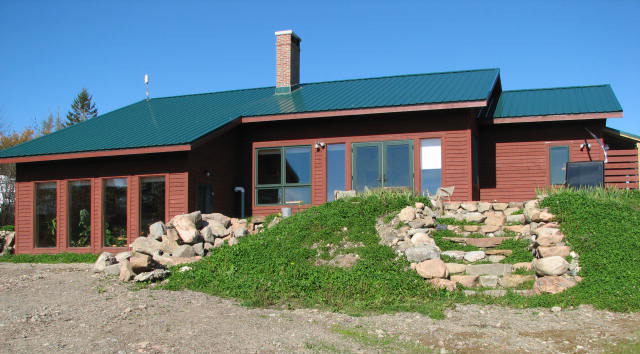
Figure 14. South face of the Maine farmhouse in mid-October
The design gains from all our previous experience and from improvements in passive solar design ideas, standards, and materials since we built in 1980. We were also able to invest in better quality and in passive solar elements of higher energy efficiency than we could in the previous houses. In particular, this farmhouse gains from the adoption of a unique way of integrating thermal mass devised by an engineer/builder, James Kachadorian. He successfully tested the design in a number of houses that he built in New England and wrote a book on the subject, which we used as a guide.[2]
The cost of this house, however, was far greater than the others in this study, because we had to pay professional builders and abide by building codes and professional standards of finished carpentry, which previously we had been able to avoid by doing our own work, using free and salvage materials and building to more rustic standards. So I do not pretend this house to be a model of inexpensive passive solar construction. Although new to passive solar design, the builders carried out our plans successfully so that the house performs as expected. I think the fact that this design uses mostly conventional materials and construction practices was critical to their success.
This house is a one-story stud frame building set on a concrete foundation. A thermal mass consisting of a concrete slab floor and subfloor concrete block area is insulated from the foundation. The frame is covered with a raised truss roof. All of these elements involve standard construction techniques but required some alterations to fit our design.

Figure 15. Double-walled frame (Maine house)
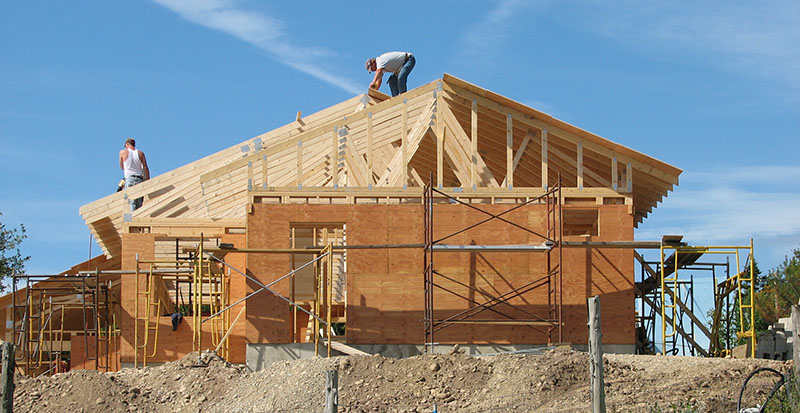
Figure 16. Raised truss design (Maine house)
Insulation. Current standards for energy efficient housing call for super-insulation. Wall insulation of R=40 and insulation of ceilings to R=80 are said to be worth the cost in energy savings. To come close to these levels with our choice of blown-in cellulose insulation, we had to build a double-walled frame 10 inches thick. The two wall frames are tied together with wide sills and top plates. We used different stud spacing for the inner and outer walls (see photo) to offset them and reduce heat loss through the studs. To provide enough space for insulation above the ceiling, we used a raised truss design that allowed for 20 inches of cellulose, especially in the critical area where the truss space narrows at the bottom of the roof where it meets the top of the wall. Dense-packed in with a blower, the cellulose flows around framing and fills all spaces. Although cellulose insulation is recycled paper goods and therefore promoted as “green,” it was not particularly cheap. As the photo shows, large quantities are needed to achieve the desired standard. However, an owner-builder could achieve a similar result by stuffing wall spaces with bags of dry leaves, quantities of which are available in town neighborhoods at no cost.
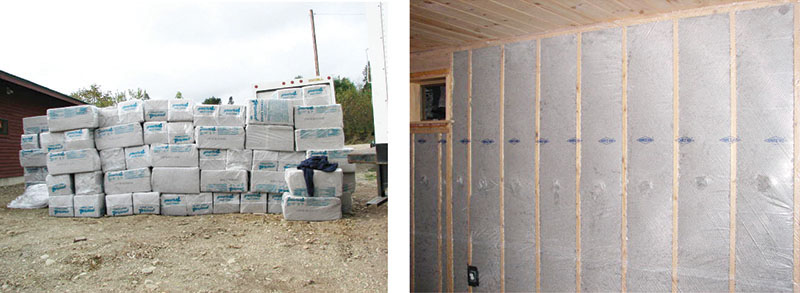
Figure 17. Cellulose insulation, as delivered (left) and packed in a wall behind a vapor barrier (right)
Thermal Mass and Heat Distribution. In its original concept, the Kachadorian design uses the convection loop created by air heated by sun coming through the bank of south windows. The heated air rises, pulling air through concrete blocks laid in channels under a poured concrete floor and storing heat from the room air in this mass of masonry. Registers along the north and south edges of the house floor allow air to enter the thermal mass at the north edge and exit below the south windows. Because air in convection loops follows the path of least resistance, we suspected that in the Kachadorian design most of the air would flow across the top of the floor to replace the rising air, following the normal path of least resistance of the convection loop in a house and rendering the block channel storage mass ineffective.
To make sure that air flows through the block channels, we altered the design as shown in the sketch. We placed a plenum across the middle of the subfloor system from east to west. This is a central duct (metal in the photo) that feeds the channels in the block. In the center of the house we built a vertical duct containing a quiet, variable speed fan that takes the warm air from the ceiling and pushes it down through the plenum, through the block, and out the registers at the edges of the floor. This design performs the double function of moving the warmest air into the thermal mass and allowing us to close registers in different rooms of the house to distribute stored heat differently to the floor in each room.
As shown in Figure 18, rigid foam completely insulates the block and poured floor from the foundation and the earth, which allows the masonry to retain heat that is absorbed from the airflow and also from the sun directly hitting the concrete floor. The floor is permanently stained a dark color to maximize absorption of the sun’s radiant heat. Over time, the transfer of heat by these two routes brings the thermal mass up to room temperature and stabilizes the house temperature by releasing heat and keeping the temperature from dropping far when there is no sun or artificial heat.
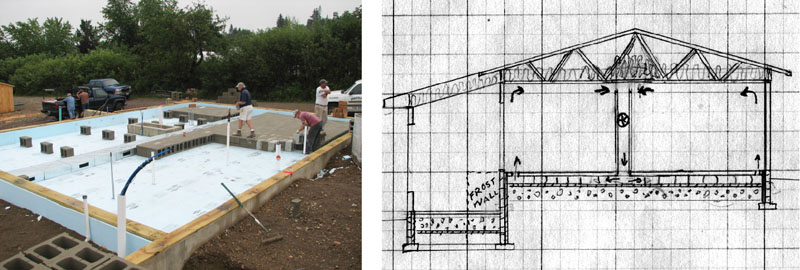
Figure 18. Thermal mass in the Maine house: laying the block (left), cross-sectional sketch (right)
The Kachadorian design calls for calculating the slab floor thickness so that the heat storage capacity of the floor and block mass matches the solar heat production capacity of the south window glass. The intent is to avoid excessive solar heating. This is an example of the calculation overkill that we think is common in the passive solar literature. We built almost the maximum glass area possible into the south wall and poured a standard four inch thick concrete floor. We see excess solar heat in the winter as a minor problem that can be solved by cracking open a window. In the summer, the roof overhangs and the movable insulation keep out direct sun. The night air flow from open windows cools the thermal mass, which holds down the temperature inside during the day.
Movable Insulation. Available capital and the predictable geometry of frame construction allowed us to use a combination of commercial and custom built solutions that insulated windows and doors to the high energy efficiency standard of the other passive solar elements in the design. Wherever there was sufficient wall space, the carpenters built hinged shutters that seal tightly when closed and open back against the wall. The wood frames and faces of the shutters enclose rigid foam insulation board an inch thick. On the larger windows on the south side there was no wall space for shutters, so we used commercially available movable insulation in the form of quilts that are stored on rollers above the windows and slide down on tracks that provide a tight closure.
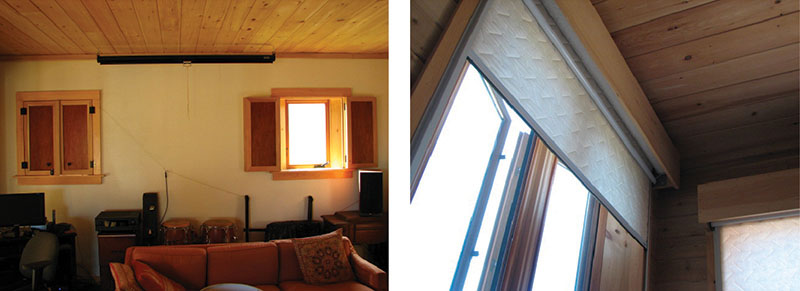
Figure 19. Movable insulation in the Maine house: shutters and quilts on rollers
Air Control. Because we were able to afford windows and doors that seal well, it was worth making the rest of the house airtight as well. In addition to the plastic sheeting on the inside surface of walls and ceiling that also served as the all-important vapor barrier, we caulked and taped liberally in critical places like joints between walls and ceiling and floor and around window and door frames. We used special electrical boxes made to be airtight and allow taping to seal them to the vapor barrier.
A house built this tightly often needs an air intake in the design. The wood fires that furnish supplemental heat and the breathing inhabitants both need fresh air. As in the New York house, outside air passes through an underground pipe that moderates its temperature and enters close to a centrally located chimney that serves a fireplace on one side and a wood-fired kitchen range on the other. This way the air that feeds the fires travels a short distance and creates little draft. The central chimney breaks the living space into two rooms while keeping the open plan that helps distribute heat around the house. This chimney location also adds to the thermal mass and keeps more of the heat from the chimney inside the house than a chimney on an outside wall. This chimney arrangement brings our cast iron, wood-fired kitchen range closer to the high energy efficiency of a masonry stove at a fraction of the price.

Figure 20. A central chimney partitions the open floor plan and services the kitchen range and fireplace, which provide all the wood heat in the Maine house
Overhangs. On the principle that overhanging roofs on all sides are good weather protection for the walls, windows, and doors of a house and sometimes for things stored outdoors, our policy has always been to design for them wherever possible. Because the raised truss in this house adds height to the roof at the eaves, we made the roof overhang nearly 3 feet in the attempt to shade the southern windows from the summer sun. The photo of the whole house that begins this section, taken in October, shows that despite the long overhang it permits the cold season sun to shine on the whole south window area. Some summer sun does penetrate the interior despite the overhang, but it can be stopped by lowering the insulated window covers.
Performance Comparisons
Hot water. The summer and winter hot water systems operate on the same principles as in the New York house, and the winter system uses the same stove and tank, brought from New York. Because we chose vertical glazing for the greenhouse (these are the windows on the left in the photo of the house in Figure 14), a solar collector for the summer system was placed outdoors where it can be angled properly. We located a standard insulated electric hot water tank (not electrified) inside the house, as close as possible to the solar collector to keep the convection loop short and maximize hot water accumulation. Because of the insulation and a larger tank, the Maine system stores more hot water longer than the bare tank in New York, enough for two days use after a half day of sunlight.
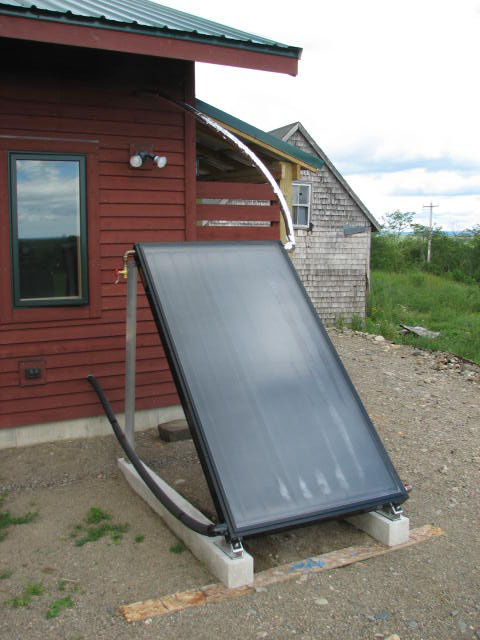
Figure 21. The flat plate collector for summer hot water at the Maine house is drained in winter
Attached greenhouse. We improved the solar functions of this greenhouse over the one in the New York house. We chose vertical glazing to permit the use of easily installed, commercially available movable insulation. Hence the large area of glass in this greenhouse can maximize the retention of the solar heat that it captures. Wide French doors between the greenhouse and the house living space allow us to better regulate airflow and create a temperature difference between them if so desired. The outside door that we put in this greenhouse greatly improves plant growing and summer ventilation. To provide easy external access, we put the greenhouse floor at ground level and also built the room partly into the hillside to preserve most of the earth-sheltered design of the greenhouse in New York, which has a sunken floor.
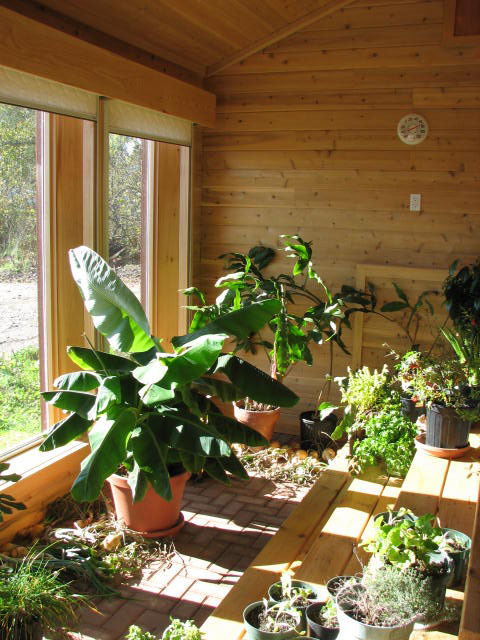
Figure 22. The Maine greenhouse in late fall
Critical components. Although the New York house has considerably more thermal mass and south glass, the Maine house outperforms it for several reasons. In a passive solar design, all the elements must work together; weak links in any system limit the performance of the whole. In the Maine house, all the elements are of sufficient quality to perform their functions equally well. It is better insulated and much more airtight. The thermal mass stores heat more effectively because the fan continually moves air through it. There is virtually no heat stratification: it is a one storey house, and stored heat radiates up from the floor while the fan moves rising warm air down from the ceiling through the thermal mass, which tends to equalize temperature everywhere. The movable insulation is designed to close more tightly as well. Finally, it has an improved attached greenhouse as described above. However, all these improvements are working against the colder winter (10 °F colder) and shorter winter days of the higher latitude in Maine (45° N).
| Heated floor area | 1250 ft2 |
| Wall insulation | R = 40 |
| Roof insulation | R = 60 |
| Foundation insulation | R = 20 |
| Thermal mass | 1300 12 inch concrete blocks under floor and 4 inch poured concrete floor |
| South-facing glass | 162 ft2 |
| Other glass | 78 ft2 |
Table 2. Specifics (Maine House)
| Extra Insulation and Wall Thickness | $10,000 |
| Window quality (thermopane and airtight) | $5,000 |
| Thermal Mass | $4,000 |
| Movable Insulation | $6,000 |
| Total | $25,000 |
| Percent of Total Construction Cost | 15% |
Table 3. Extra Construction Costs for Passive Solar (Maine House)
One test of a passive solar design is how well it holds heat overnight on cold winter nights without any supplemental heat (our practice in all the houses was to let the wood fires go out by 8 p.m.). By morning, the temperature in the NY house was dropping from 72 °F to as low as 55 °F as the winter wore on. By contrast, the Maine house stayed close to room temperature overnight until a December week of outside temperatures in the single digits. By the end of that week, the overnight drop was to 65 °F. As outside temperatures returned to normal in January, the overnight drop inside the house decreased, and the inside temperature on waking was around 69 °F.
How much more does passive solar design cost? That can vary with the way the design principles are applied and the materials a specific design requires. The extra costs in the Maine house reflect the expense of new materials and professional labor throughout the house, but the solar fraction of the total construction cost was still a low 15%.
Conclusion
The goal of this account was to demonstrate a number of ways that the same passive solar design principles can be applied to maximize residential energy savings with the least cost and technical difficulty. How will these ideas play in Tompkins County? Two Ithaca architects who reviewed my design for the Maine house said that apart from a small network of owner-builders that is applying a low-technology approach, there is not yet much passive solar construction or renovation in the county despite its overpopulation of intellectual heavyweights and its reputation for progressive politics. Current interest in “green design” tends to run to solar and wind electric technologies that replicate the push-button convenience that our society is used to but are very inefficient ways to heat a building. While this approach bestows a certain social status, it is so expensive that it is not a model likely to gain widespread adoption in an industrial economy now headed into long-term decline. Area developers sometimes promote “green materials” that may also confer status but rarely save as much of the planet as simple construction designs that dramatically reduce residential energy use.
Hence readers whom this saga encourages to “walk the talk” of sharply reduced residential energy use may be viewed as oddballs until resource depletion forces the rest of the community to see them more as heroic pioneers. Because their houses achieve so much with so little in the way of complicated equipment, a common reaction may be disbelief, and the community may not take seriously their overly “magical” accomplishment. Community interest in the houses described here, built over a forty-year period, has been low.
However, the tide may be turning. Our head carpenter on the Maine house monitored the condition of the unheated, unmanaged residence during the winter before we moved in. When he found that its temperature never dropped below 45 °F, he was so amazed that he reported his discovery widely. As the news percolates throughout this rural Maine community, habituated to burning through mountains of firewood or fossil fuel to get through New England winters, how will they see us, as tricksters or alchemists, or as models for the future? Meanwhile our carpenter, who knows, as builder of the house, that there is no magic involved, proudly announced that he has installed movable insulation on the windows of his own home.
Glossary
- Biomass burning
The most efficient use of biomass energy, as in heating directly by burning wood. Conversion of biomass to other forms like liquid fuels or electric or steam power involves a great waste of the energy in the biomass.
- Biomass energy
Energy from biological sources. Historically, wood has been the main source. This energy is renewable if harvested sustainably because it originates in the sun.
- Convection loop
The circuit that fluids like air or water make that transfers heat. When heated lower in the loop, the fluid becomes lighter and rises, moving the rest of the fluid around the loop. In the hot water systems described here, placement of a tank near the top of the loop allows continual accumulation of heated water in the tank by convection without an external source of energy to move the water.
- Earth-sheltered house, earth berm
An earth-sheltered house is a house partially surrounded by earth, either because it is built partly underground (e.g., into the side of a hill) or because one or more of its walls are backed by an earth berm, earth pushed up against a wall. In either case the earth adds insulation value, partly because the temperature underground is much higher than average winter air temperatures in the Northeast, typically 40-50 °F in a completely sunken basement
- Fossil fuels
Oil, gas, and coal, which are the fast-depleting nonrenewable energy sources on which industrial society is heavily dependent.
- Insulating glass, thermopane
Glazing with two or more layers of glass sealed together so that air or other gas held between the layers acts as insulation.
- Masonry heaters
The most efficient woodstoves because they allow hot, efficient burns and they retain most of the heat in the masonry, heat that is lost up the chimney in other woodstoves.
- Movable insulation
Designed to easily cover windows on the south side to prevent heat from escaping when the sun is not shining in, insulating covers also function to block excess sun in summer and to insulate windows on other sides of the house when daylight is not needed. Inside and outside cover designs are both used, but mine have all been inside. Unlike curtains, these essential components of passive solar design must seal to the window frame on all sides when closed to function properly as insulation.
- Passive solar
Building design that uses the sun to provide space and water heating with little or no external energy inputs or technologically expensive materials. For example, electrical components like converters, batteries, pumps, and fans are mostly unnecessary.
- Solar greenhouse
A greenhouse that incorporates as many of the elements of passive solar design as possible.
- Rumford fireplace
An energy-efficient design used in colonial times for cooking and heating.
- R values (e.g., R=28)
A universal measurement of insulation value of materials. For example, rigid urethane has a relatively high R value of R=8 per inch of thickness. I insulated the New York house entirely with rigid urethane, most of it discarded by a company that cuts up large buns of the stuff to order for clients. I got the discards for free.
- Thermal mass
A heat storage material that is an essential component of passive solar design. Water and metal store a lot of heat but stone, brick, or other masonry are the most common because they can function as structural elements of buildings and still store more heat than most building materials.
Notes
[1] Following the historical pattern of human exploitation of all finite resources, fossil energy extraction started with the sources easiest to tap and has progressed toward sources that are the most expensive, because they are lowest in quality and hardest to extract from the earth. Hydraulic fracturing is an example of an expensive extraction methodology that guarantees a higher cost of production over the long run. This increasing cost will make fossil fuel prohibitively expensive for more and more uses, eventually including residential heating.
[2] Kachadorian, James. The Passive Solar House: Using Solar Design to Heat and Cool Your Home. Chelsea Green, 1997.
By Karl North
The vulnerability of cities and suburbs in the post-petroleum era has been the object of much debate because their present organization makes their operation so energy-intensive. The debate heretofore has tended to swing between two extremes. One claims that these forms of social organization on the land are so unsustainable that their populations will be forced to abandon them gradually as the energy descent progresses.[1]
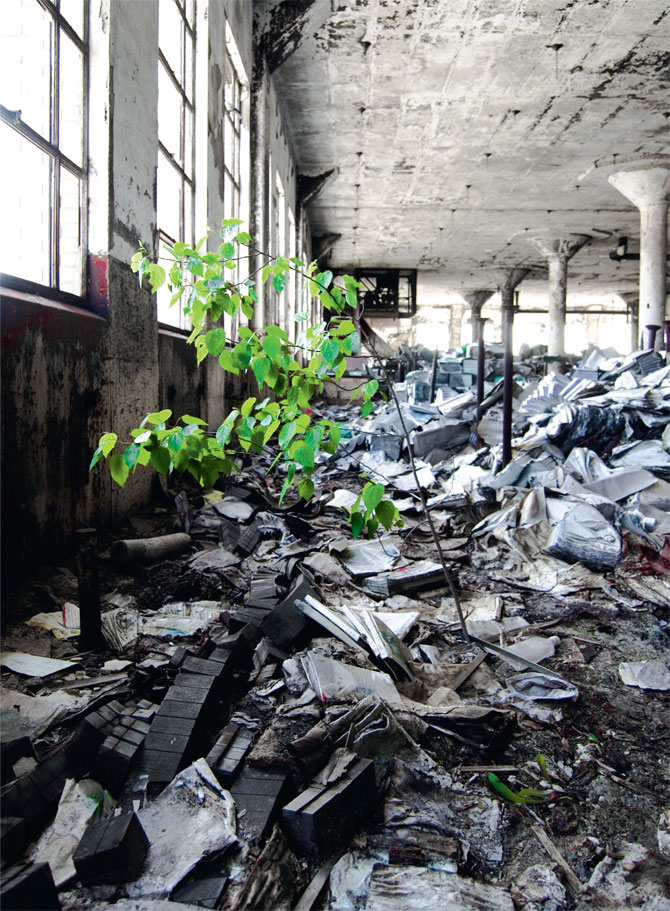
Figure 1. A tree grows in Detroit
(photo by James Griffioen, vice.com)
James Kunstler, a well-known critic of the kind of cities and suburbs that have emerged in recent decades, puts it bluntly:
The whole suburban project I think can be summarized pretty succinctly as the greatest misallocation of resources in the history of the world. America took all of its post-war wealth and invested it in a living arrangement that has no future.[2]
The other extreme entertains dreams of massive programs of public transportation to save suburbia. It also relies heavily on technologies like high-rise agriculture and on the efficiencies of population density to save cities. This is the vision of the eco-cities movement.
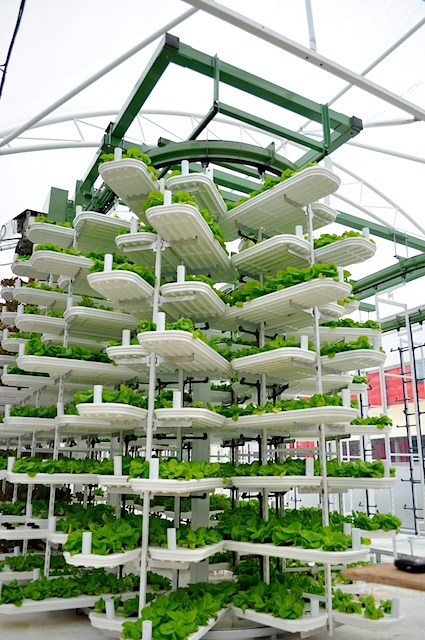
Figure 2. Techno-fantasy unchained
(Time magazine via City Farmer News)
Neither of these scenarios makes much sense. The abandonment thesis ignores the immense accumulated wealth of the built environment in metropolitan areas, which is not likely to be left to fall apart, but will more likely support a certain level of human population if salvaged for other uses than it was originally designed for.[3] It is conceivable that modern society will be reduced to energy inputs available in 1800, before much use of fossil fuels. But that would not mean a simple return to what life was like in those times, due in part to the bonanza of accessible raw materials that the present built environment represents (a good thing), and in part to two hundred years of accumulated damage to the planetary resource base (not so good) that was unimaginable in 1800.
On the other hand, the claim that technological improvement can keep cities and suburbs functioning in the current ways at current population levels fails for many reasons. First, it perpetuates the above-mentioned accumulation of damage to necessary ecosystemic functions, damage that is intrinsic to “technological improvements,” damage that is already causing exponential growth in the operating costs of metropoles. Then there are the two reasons that the technological savior argument always has failed: there is a limit to the efficiencies that can be delivered by technology, and every technological advance requires an increase in complexity in the socio-economic system, with a resulting increase in consumption of energy and other raw materials in an era of increasing resource scarcity.[4]
Moreover, as genres of social organization and human landscapes, modern cities and suburbs are among the most energy consumptive imaginable because their continued existence relies on a broader agro-industrial base. Most calculations of the energy budgets of metropolitan areas far underestimate because they fail to account for the energy embodied in their construction and maintenance, which includes the vast and often distant agricultural and industrial plant, transport, and communication systems necessary to keep them running. This diagram suggests the scope of the support system required just to keep a metropolitan population in food.
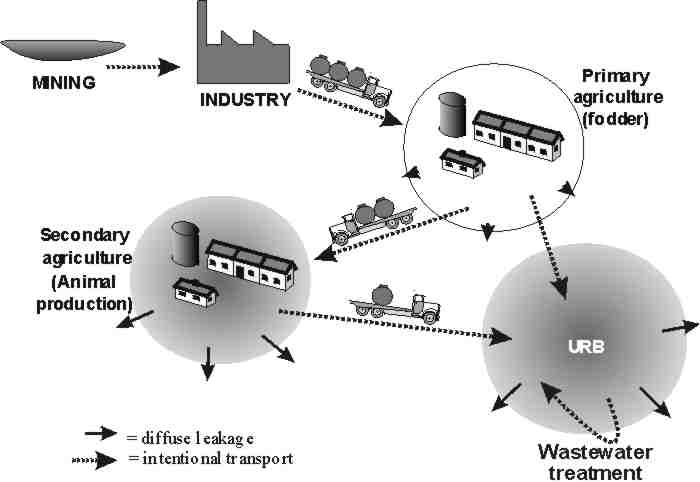
Figure 3. “The linear flow of minerals from mines to farms and then dense human settlements leads to depletion at one end and the concentration of wastes or dispersion into water at the other.” — Jason Bradford (http://www.theoildrum.com/node/5773), graphic by Folke Günther
Of course, cities have existed ever since the advent of agricultural systems capable of providing the surplus necessary for their growth. But after a period of expansion, often spanning centuries, they have usually destroyed enough of their resource base to cause them to decline. In the last two centuries, cities have grown markedly in size and consumption of resources. But this unprecedented level of urban expansion is entirely reliant on access to fossil energy and other nonrenewable resources that are now becoming permanently more scarce.
The main weakness of the eco-cities movement is its failure to squarely face the increasing scarcity in energy and other resources and seriously consider its implications in the energy descent. Green or new urbanists claim that cities like New York are sustainable because their population density allows a smaller per capita ecological footprint than suburbs.[5] The clustering of populations that the ecocities movement advocates does conserve energy in key areas like building heating and human transport. This clustering will be essential in the energy descent at every scale of human community if we hope to avoid not only the energy costs of most present building configurations and their reliance on a distance economy, but also their misuse of agriculturally valuable land.
But heating and human transport are only one part of the energy cost of operating cities. The green urbanist scenario that compares present cities favorably to present suburbs fails to consider the more comprehensive assessment of many energy descent analysts that no dominant configuration of land use and built environment in the US today, urban, suburban, or rural, is sustainable without fossil fuels. The embodied energy in cities in particular involves upstream energy and material flows along many long production chains, and it requires constant renewal due to entropy (depreciation). Hence embodied energy in cities is commonly three times as high as operational energies like heating and daily human transport.[6]
As a result, the eco-cities movement’s current urban redesigns are characteristically overly complex and overly expensive, and are therefore aimed, like much organically grown food and most present ecovillages, at a gentrified market that will not survive the energy descent. This is not meant to criticize these efforts, but simply to point out that they reflect the economic and cultural choices of a society that has enjoyed cheap energy.
In addition to narrow thinking about the massive inflows of energy and other natural resources that today sustain metropolitan areas, the ecocities movement rarely considers more fundamental questions about urban populations posed by energy descent. In a world where the energy from oil has permitted a tripling of the population and, in rich countries, an average per capita ecological footprint (a measure of resource consumption) so large that it could support 30 African peasants, what is the true carrying capacity? How is the disparity in footprint justified when it reduces the supportable global population? And what is the largest sustainable city when urban population densities are on the order of 67,000 people per square mile[7], and the transportation cost of provisioning such densities from ever-more-distant locations increases with city size beyond the declining energy capacity of the planet?
A More Likely Scenario
A third scenario that I will explore here as more likely than the two considered above envisions a major transformation of both urban and suburban land and resource use to make cities and suburbs habitable in the coming low energy era, although necessarily supporting a much lower population level than they do today. As in all ecosystems, the carrying capacity of these areas will contract to fit the available energy, which sooner or later will be mostly solar.
Carrying capacity (CC) is an essential concept for thinking in scenarios about a future in which access to key resources is declining. Carrying capacity is not just a population level. It is first the level of sustainable resource consumption (SRC) that a particular landscape or resource base can support, which in turn determines the mix of population level and per capita resource consumption or material standard of living. Thus the equation for sustainable resource consumption is
SRC = population × resource consumption per capitawhich makes clear that sustainable carrying capacity in terms of the actual number of people it will support depends on the level of individual consumption:
CC (sustainable population) = SRC ÷ resource consumption per capita
This understanding of carrying capacity raises a concern about present resource consumption. The modern industrial society that urban areas epitomize now relies 80-90% on nonrenewable resources. A society that must return to a resource use rate that rarely uses nonrenewables except as recycled salvage will need to rely mainly on low-input agriculture, aquaculture, and forestry for food and fiber, and similar low-input technologies using renewable and salvageable materials in other areas of production. Hence the inevitability of a return to a relatively low-technology solar energy economy is likely to reduce populations in large metropolitan areas to 10-20% of their current levels.[8] Dispersal from city centers to hinterlands will account for much of the decline. In the end this will be a salutary outcome because it will contribute manpower to the increasingly labor-intensive farming systems that will replace industrial agriculture.
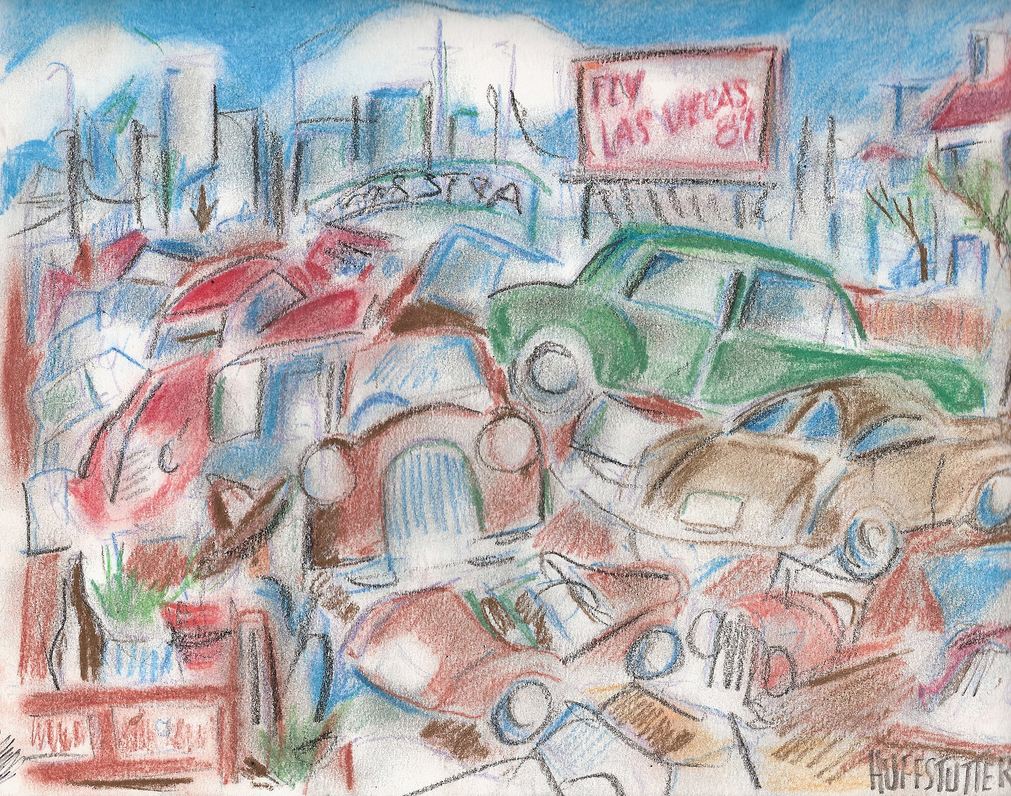
Figure 4. (Pastel by Robert Huffstutter)
How will employment and therefore population shrink in metropolitan areas? The relative concentration of wealth in metropolitan areas has spawned an urban economy that depends heavily on discretionary spending beyond essentials. This part of the economy will tend to shrink first as the energy to support the modern economy becomes scarce.
Also, many people who live in cities and their suburban bedroom communities work in an economy that is parasitic: instead of creating value it simply transfers wealth from one group to another. Much employment in the so-called FIRE sector (finance, insurance, real estate) falls into this category, which also includes much government, advertising, litigation, and lobbying activity — economic sectors that have arisen to exploit our society’s failure to find better ways to perform essential functions. Jobs in this parasitic economy can be expected to disappear early in the energy descent. Many urban clerks in cubicles, data gathering to feed the wealth transfer game, will need to convert to skills that provide life’s basic necessities — food, shelter, basic tools, and services — and for many that will mean leaving the city for farms.
In reality, much of the present urban population will be needed on farms. According to energy descent scientist Richard Heinberg, the de-industrialized agriculture that replaces the current energy-intensive form of food production in the US will require fifty million farmers instead of the present two million.[9] Indeed, there is a growing new farmer movement across the US, served by organizations like Groundswell here in Tompkins County.
The challenge of envisioning a plausible conversion of metropolitan corridors like Bos-Wash to landscapes that are livable sans fossil fuel is to think beyond current models of development or even redevelopment schemes requiring levels of capital investment that a post-petroleum economy cannot afford. The expensive visions of both the green urbanist movement and the nodal cluster suburbanists run aground on this obstacle. Awareness comes slowly because thinking about the upkeep of these structures in the energy descent is often counterintuitive:
Cities overburdened with skyscrapers will soon discover that these structures are liabilities, not assets. The skyscrapers deemed most “innovative” by today’s standards — the ones most dependent on high-tech materials and complex internal systems — will be the greatest failures. This includes many of the new “green buildings.”[10]
An additional hurdle is the current resistance of the denizens of these landscapes to using them differently, but eventually that resistance will melt away as necessity becomes the mother of adaptation.
Throughout their history, metropolitan areas have been centers that have concentrated wealth and power drawn from exploited peripheries. Early in the energy descent they can be expected to use this accumulated advantage to allocate resources disproportionately to themselves and thereby prolong consumption levels and material living standards even as they decline in society as a whole. The maintenance of centralized control that this requires may hinge on something as simple as the ability of security forces, police and military, to fuel their operations on renewables like biodiesel.
Later in the energy descent, however, much of the fuel-intensive economic activity and centralized, hierarchical organization that is the raison d’être of cities and their umbilically connected suburbs will become unaffordable, and the related employment and population will evaporate. The long term budgetary agony of central governing administrations, now well under way, is an early indicator of economic contraction to come. Then human activity will return to a focus on the basic necessities of food and shelter, and economies in these places as elsewhere will self-reorganize around the provision of farming, food systems, and housing that work with minimal fossil fuel. My aim here is to summarize how I think this is likely to happen. The key element in my scenario is the liberation of the built environment and its rearrangement for other uses, a change made possible by the contracting economy and population of metropolitan areas that I have described as inevitable over time in the energy descent. Finally, I will suggest how this scenario might play out in Ithaca, New York and its hinterland, and by extension, in other small cities and towns.
The Post-Petroleum Metropole
Cities located on waterways will remain centers of some distant trade as they have for centuries. On the downside, rising water levels could eventually reduce habitable areas in seaport cities. But for a while as cities and suburbs shrink and depopulate, urban activity will center on salvage of the built environment. As many parts of the built environment are abandoned, we can expect their materials and land to be reclaimed for structures and spaces for growing food and for makeovers of housing and other structures to the level of energy efficiency required by the new economy. Because the return to a solar energy economy will support only a limited population, most land and buildings will stand empty and provide a broad inventory of materials or, once cleared, space for gardens. It is hard to imagine conversion of places like the canyons of south Manhattan to either appropriate housing or food production, so some city zones may remain abandoned except for salvage activities. At the end of Apartheid in South Africa, for example, white businesses left the high-rise section of Johannesburg. The squatters who replaced them could not afford the energy needed to maintain the buildings, and they gradually fell apart.[11] As urban areas everywhere experience a similar drop in energy use, urbanites will abandon energy-intensive structures. Hence a degree of decentralization will occur as urban areas devolve into compact, semi-self-sufficient neighborhood communities separated by empty salvage-yard commons.
The same process will occur in the suburbs, where abandoned residential and commercial structures will serve as stores of materials for low-cost conversion of residential housing for the remaining population. Land to farm will be plentiful, but a main problem will be to end the inefficiencies of suburban sprawl and reconfigure this landscape into the kind of demographically dense agrarian villages that have proved sustainable for centuries. The affordable solution will be to move salvaged building materials or whole abandoned structures into clusters at these central locations. This will recreate at low energy cost the nodal demographic topography that historically has been chosen as the most efficient mode of spatial organization of rural communities the world over.[12] Thus in the long reach of history the extravagance we call suburbia will prove to be a temporary phenomenon.
Once the suburban topography is reformed into economically efficient agrarian communities, some of these villages have the potential to create a thriving trade in surplus food production with the nearest city nodes, which in turn have a surplus of salvage inventory for which they can exchange materials, and products handcrafted from them, and exchange seasonal labor as well. In other words, city and suburb will convert to symbiotic economies that bear some similarity to what they were before the oil age. In the New York metropolitan area, for example, New Jersey (the Garden State!), Long Island, coastal Connecticut, and the Hudson Valley — the city’s former breadbaskets — will regain that function. As the distance economy that cities once depended on becomes too costly, the ability of the near suburbs to convert from bedroom communities to beehives of food production may well determine the size of the population that can remain in the city.
Solarized Housing
In cool climates like the Northeast US, people will be forced to rebuild housing to maximize solar heat and minimize biomass burning, as biomass will regain its traditional role as the key strategic resource and will experience renewed demand for many uses. Here again the expensive models of residential energy efficiency popular today in the green building movement are impediments to visioning. For most of the population the only conversion option will be to use scavenged materials and hand labor, both of which will be plentiful, and in fact all that is necessary to build highly effective passive solar systems for heating both living spaces and water.
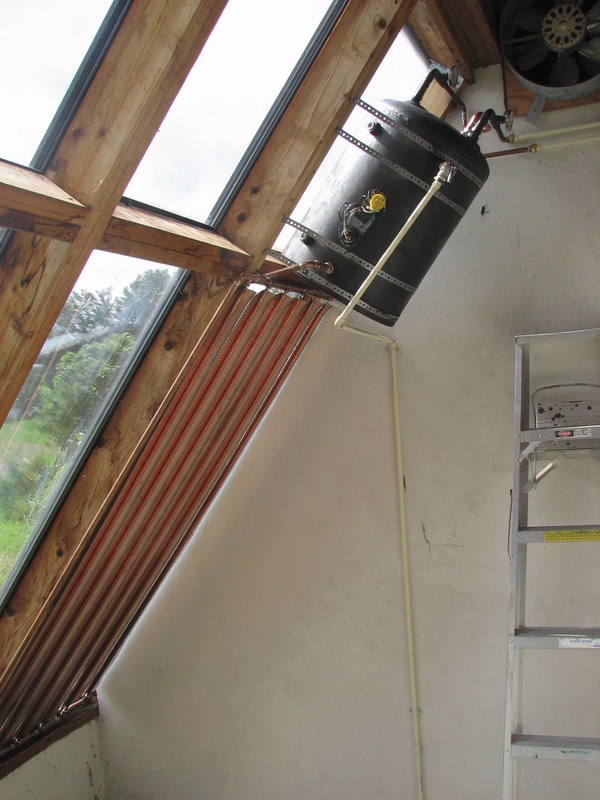
Figure 5. Solar hot water in attached solar greenhouse
To solarize a residence or other building that needs to be heated for all-season use, urbanites will raze city structures that block it from full southern exposure and will use their insulation, glass, masonry, and plumbing hardware to convert it to reliance mostly on the sun for heat and hot water. Widespread conversion will occur when the massive city and suburban built environment inventory becomes available for salvage, because this type of solarization requires no expensive technology or skills beyond elementary carpentry and plumbing. Enough business buildings to support the shrunken economy will be converted in the same way. Gradually buildings made of wood, with their short turnover time of a few decades, will give way to more durable masonry salvaged from unusable structures. The masonry will perform the added function of furnishing the thermal mass to store solar energy required by passive solar heating systems.
Food Production Systems
Like most current alternative architectural models, most organic agriculture grew in the age of cheap oil and takes for granted many of its luxuries. Food production everywhere will eventually adapt much more closely to farming in nature’s image. Like natural ecosystems, farms will have to be largely self-sufficient in inputs, including a lot of human and animal labor and relatively simple machines and tools.
City food production will reach limits, making city populations dependent on the development of farming in the hinterlands that had been suburbs. Once most empty urban spaces are used for farming, space will be a limiting factor on urban growing because demolition and removal of buildings in the energy descent will be very labor intensive. Another limiting factor will be lack of space to “grow” fertility either as green manure or manure from pastured livestock. This need for fertilizer could motivate a return to transport within the metropole using animals fed from fields outside cities, animals like those whose manure supported urban food production until well into the industrial era. In many metropolitan locations, efficient steel-on-steel rail transportation systems work as well with animal power as with energy derived from fossil fuels, just as they did for decades before and after the turn of the twentieth century. An effective policy would prioritize remaining fossil energy for the reconstruction of the rails and the rolling stock and run the latter on animal power.
A distinct advantage of farming in cities and suburbs will be the many existing structures that can be converted to solar greenhouses to furnish the heat to perform and enhance essential services in the new food system: intensive all-season growing, vermicomposting, food conservation by solar drying, and even solar cooking. Husbandry of small livestock like poultry and rabbits also will benefit from solar greenhousing. Like the solarized human housing described above, these structures will be low-cost conversions that require little skill beyond an understanding of passive solar concepts.
Implications for Tompkins County
Whatever its previous form of habitation and land use — city, suburb or rural — the most effective form of reorganization of communities everywhere will be small, dense, and mixed-use, to make the most of the traditional advantages of a convergence of many hands with diverse talents in a world made more by hand and constrained mostly to local self-reliance.
However, the size of an urban agglomeration will affect how easily the scenario that I have described will occur. Bamako, in 1962 a city of 100,000 in the heart of West Africa, seemed to manage well on relatively little fossil energy, as most of its population still cast a small carbon footprint. But Havana, with a population ten times that of Bamako, was suffering visibly despite massive compensatory government programs when I observed it during visits in the 1990s, six years into its peak oil experience (Cuba endured an 80% decline in energy and related inputs).
The larger the metropolitan area, the more population shrinkage it is likely to experience, and the greater the tendency for the city proper, like the suburbs, to break up and reorganize into compact, walkable, semi-self-sufficient communities. Cities as small as Ithaca will undergo much of the repurposing of land use and built environment described above, but the changes will be less extreme. Most of the downtown area is already walkable, and a low-input public transportation system is conceivable that would link neighborhood clusters to each other and to a rural periphery that is relatively nearby.
Like many cities on waterways, Ithaca will benefit from a potential lakeside trading area that low-input water transportation offers. The lake provides a link to a large swath of farmland that might support more of the current urban and suburban population in Ithaca than in landlocked cities. Hence waterfronts in the city and county will regain importance as points of departure in a revived system of waterborne commerce. In an era of scarce, depleted resources, this waterfront renaissance will need to occur mostly with salvaged or renewable materials.
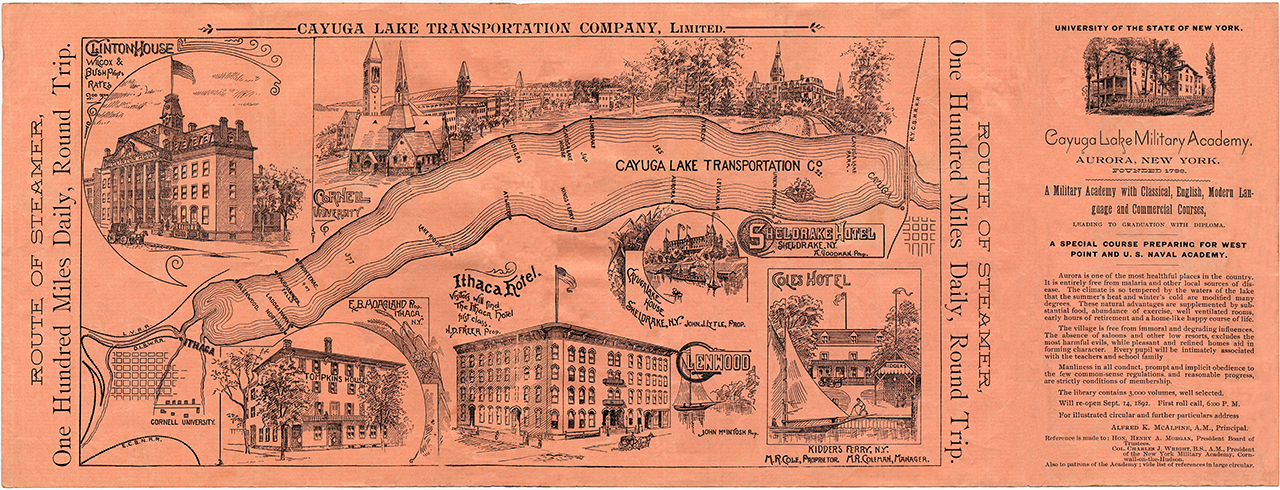
Figure 6. An advertisement for the Cayuga Lake Transportation Company, ca. 1892. The steamer served the same communities around Cayuga Lake that are served by state routes 34, 34B, 90, and 89 today. A high-resolution version of this figure can be downloaded from http://freepages.genealogy.rootsweb.ancestry.com/~springport/pictures75/7548cleaned2sharp.jpg (use “Save link as” to download before attempting to view)
The emergence of dense agrarian feeder hamlets along transportation lines mentioned in my Visioning County Food Production series[13] is more likely to proceed as I have argued here, by salvage of the existing built environment, than by expensive new development as in the present ecovillage model. However, the reorganization of the Tompkins County food production system, food economy, and resultant urban and suburban land use that I explored in that series is more conceivable in its urban and suburban population of 100,000 than in a larger metropolitan area, again for reasons that I have discussed here.
Conclusion
There is a fourth scenario for the nation’s metropoles that temporarily could partially avert the one I have described as most likely. Governments could proclaim a “wartime economy” and create a program of economic policies that redirects remaining fossil fuels and other nonrenewables to uses that adapt urban areas to a low energy future. If governments were to make appropriate major changes in economic priorities, for a while they could maintain urban populations and support levels of urban activity and consumption that are higher than what I have described. Perhaps Departments of Descent would emerge and begin setting economic policy, at least locally.
This would amount to converting the “free-market” economy to a mixed command economy, which while common in many countries, generations here in the US have been taught to regard as evil. However, our sophisticated “public relations” industry has surmounted greater challenges in manipulating the collective consciousness, and may well show itself equal to the task of achieving a flip-flop in public thinking. Whatever the success of a period of legislated economic planning, its main positive function would be to delay the inevitable return to a solar energy economy long enough to help society prepare and adapt.
The present degree of external private control of local economies is backed by government policy at all levels and is a major obstacle to adaptation to the needs of the energy descent. Therefore, an even better scenario that goes beyond emergency economic planning at a national level might be a national program to gradually devolve centralized economic control over the production of necessities to local communities, which would even give them the potential to experience economic democracy if they are so inclined.
But these scenarios might be too much to expect from the vested interests that control much of state and federal policy making. Hence my thinking about scenarios here has taken the route of cautiousness; it assumes that because the notion of public planning of economic resource use in the public interest at any level of government has become alien to US cultural values, it is more likely that cities and suburbs will be left to self-reorganize more or less chaotically into forms that can support some level of human habitation in the energy descent.
Because of all the contingencies to consider, I believe it impossible to estimate with a useful degree of probability the pace at which the scenario that I have described will come to pass. At present, for example, debt at all levels of social organization is being used to put off the inevitable, although it will only make a later transition more difficult. However, the gradual failure of the energy-intensive metropolitan way of life is already making itself felt in declining living standards for the great majority who are caught up in it. Insolvency is increasing in municipalities, forcing them to start filing for bankruptcy. Sooner or later in coming years and decades, most of us will be forced to organize our lives differently. This attempt to picture the consequences of declining energy for urban and suburban areas hopefully will facilitate that transition.
Notes
[1] Kunstler, James Howard. The Geography of Nowhere: The Rise and Decline of America’s Manmade Landscape. Simon & Schuster, 1994.
[2] Kunstler, James Howard in The End of Suburbia, 2004. http://www.youtube.com/watch?v=Q3uvzcY2Xug
[3] Vail, Jeff. “Resilient Suburbia,” 2010. http://www.jeffvail.net/2010/01/resilient-suburbia-toc.html
[4] Tainter, Joseph. The Collapse of Complex Societies. Cambridge University Press, 1988.
[5] Owen, David. Green Metropolis: Why Living Smaller, Living Closer, and Driving Less Are the Keys to Sustainability. Riverhead Books, 2009.
[6] Fridley, David. “Embodied Energy: An Alternative Approach to Understanding Urban Energy Use.” The Oil Drum, August 12, 2010. http://www.theoildrum.com/node/6842
[7] Owen, David. Op. cit.
[8] Odum, Howard T. and Elizabeth C. Odum. A Prosperous Way Down: Principles and Policies (University Press of Colorado, 2001), p. 174. Written by pioneers in the application of systems ecology and energetics to problems of society.
[9] Heinberg, Richard. “Fifty Million Farmers.” Energy Bulletin, November 17, 2006. http://www.energybulletin.net/node/22584
[10] Kunstler, James Howard. “Back to the Future: A roadmap for tomorrow’s cities.” Orion, July/August 2011.
[11] Kunstler, James Howard. Too Much Magic: Wishful Thinking, Technology, and the Fate of the Nation. Atlantic Monthly Press, 2012.
[12] Vail, Jeff. “Envisioning a Hamlet Economy: Topology of Sustainability and Fulfilled Ontogeny,” 2009. http://www.jeffvail.net/2006/04/envisioning-hamlet-economy-topology-of.html
[13] The series was published here in six parts:
http://tclocal.org/2009/07/visioning_county_food_producti.html
http://tclocal.org/2009/09/visioning_county_food_2.html
http://tclocal.org/2010/02/visioning_county_food_prod_3.html
http://tclocal.org/2010/05/visioning_county_food_prod_4.html
http://tclocal.org/2010/06/visioning-county-food-prod-5.html
http://tclocal.org/2010/07/visioning_county_food_prod_6.html
Weather may seem like a local issue we can't control, but reality is more complicated than that. While we don't control the weather itself, we have drastically reduced its impact on us through forecasting and preparation. A Tompkins County resident of the 1800s would marvel at the existence of a plausible five-day forecast, never mind radar images on a cell phone that can help indicate whether a thunderstorm will pelt one valley or the next.
Our weather forecasting infrastructure, however, is expensive and in many cases getting creaky. It depends on technologies, notably aviation, rocketry, and helium balloons, that may face resource limits in the future, as well as a short-term set of challenges created by failed satellite launches and tighter budgets.
Local Weather
Tompkins County weather is rarely dull, with substantial variations in temperature and precipitation from week to week and year to year. While Tompkins County is not regularly blasted by hurricanes or tornadoes, local weather is a complex set of intersections, dominated by continental weather coming from the west that mixes with arctic weather coming from the north and Atlantic weather coming from the south and sometimes east.
Although Ithaca has seen extreme temperatures of 103°F (1936) and -35°F (1934), most of the acute challenges in local weather come from precipitation. Before the completion of the Flood Control Channel in Ithaca, the city faced regular floods, and even today it experiences occasional issues related to ice jams. A 1935 flood caused problems across the county, even in Trumansburg [1], where debris blocked a bridge and created flooding in a place where it seemed impossible. 1972's floods accelerated the demise of local railroad infrastructure, while 1981 devastated the Village of Dryden. 2011 saw damage in Caroline, though Tompkins County dodged many worse issues to the east.
Although Tompkins County isn't in New York State's heaviest snow areas, blizzards have shut down the county every few decades, stranding residents and cutting off power. Ice storms periodically disrupt transportation and electrical distribution, as well as damaging trees and buildings.
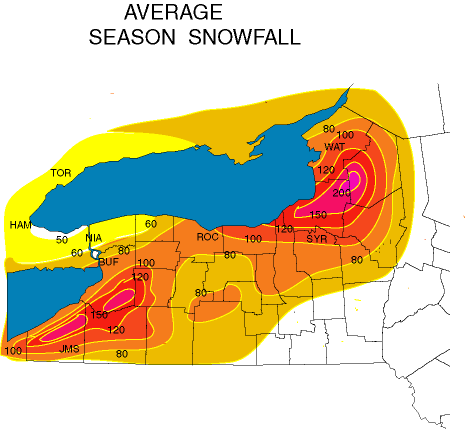
Average annual snowfall in inches, Upstate New York (from NOAA). Tompkins County is in the 60-80 inch band. [2]
Tornadoes and windstorms do happen occasionally, with the Village of Dryden seeing tornadoes downtown in 1983 and 1996, and the Jersey Hill area having one last year. While these have been relatively weak tornadoes, powerful tornadoes do occasionally occur in the northeast [3].
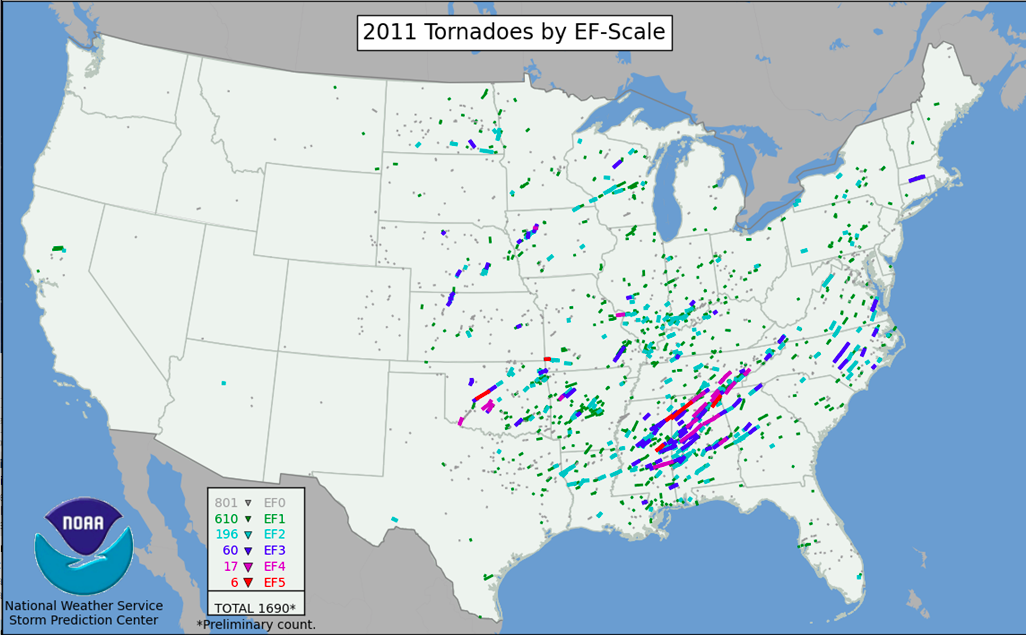
US tornadoes, 2011 (from NOAA) [4]
While the weather of spring 2012 may have seemed strange, odder and more damaging weather has happened in the past. May 23, 1925 saw 94 degrees in Buffalo, followed by ice and snow the next day, and harsh storms rolled across the northeast. Perhaps most troubling, however, was 1816's "Year without a Summer" when the massive volcanic eruption of Indonesia's Mount Tambora shrouded the planet in haze, and frosts were common throughout the summer, devastating crops.
Less dramatic circumstances can still cause problems for farmers, who depend on the weather for their livelihood. Crops need water, but too much water (or water at the wrong time) can create its own problems, both for plants and for the equipment used to manage them. Hailstorms can demolish crops and equipment, while late frosts in spring or early frosts in fall can wreak havoc on harvests.
Even relatively minor-seeming weather - fog, light rain, or a little bit of snow or ice - can have a major impact on travel safety, especially on local hills. Ithaca airport had to divert flights for a few weeks in March and April 2012 because a crystal needed for instrument navigation in cloudy or foggy weather was broken, but even simpler forms of transportation can become more complicated when weather is iffy.
The impact of climate change on day-to-day weather isn't clear yet, but added energy in the atmosphere can do more than warm it. More energy means more power for wind and storms, and it increases the possibility of events like that cold front of 1925. In the long term, diversions or droughts that cause changes in the water volumes of the Great Lakes could also change weather patterns here.
Forecasting: Collection, Communications, and Calculation
While we haven't learned to actually manage the weather, we have spent the last two hundred years taming our temperate climates by getting better at knowing what weather is coming when, preferably far enough in advance to take precautions if necessary. While it remains fairly difficult to precisely forecast how much precipitation will land where, or where in a possible storm tornadoes will form, meteorologists and their powerful tools have delivered better and better results over the last century or so.
Data collection is the first key to forecasting. The earliest "weather maps" were built using old observations, but the spread of reliable instruments and telegraph lines made daily station data collection possible by the time of the Civil War. Weather station reports today range from official Automated Surface Observing System (ASOS) installations, often at airports and National Weather Service (NWS) offices, to home stations that transmit their findings over the Internet.
Monitoring precipitation is important, but monitoring the impact of that precipitation on streams and rivers is also important for predicting flooding. In Tompkins County, the US Geological Survey maintains recording gauges on Six Mile Creek at Brooktondale and Bethel Grove, on Fall Creek in Forest Home, and on Cayuga Inlet at the lake.
Weather balloons add critical upper air observations. They are typically released twice a day from 900 stations around the world. Radiosondes [5] transmit data on pressure, temperature, and humidity for up to a few hours, and the path of the balloon indicates wind speed and direction. The balloons themselves are single use, rising until they pop. While about 20 percent of radiosondes are found and recovered, most disappear after a single use. At $100 for each radiosonde plus approximately $20 for the balloon and perhaps another $20 to fill it, individual balloons may seem relatively cheap, but they become expensive over time. Occasionally, as when Hurricane Irene was coming up the East Coast in 2011, the weather service uses them more than twice a day, but this is rare.
Weather satellites give meteorologists key overhead views of storms and normal weather. Typically satellites collect visual and infrared data, monitoring temperatures and water vapor. Satellites have made it possible to track hurricanes while they are still forming at sea, allowing for adequate warning. They also monitor solar weather, tracking changes in solar radiation and their impacts on earth's electromagnetic fields. For the United States, the key satellites are the geostationary GOES satellites. There are four functioning satellites in orbit at present, including one spare.
Airplanes both need weather information and generate weather information. While pilot reports have been important to forecasting since the early days of aviation, they were sporadic. The Aircraft Communications Addressing and Reporting System (ACARS) and temperature and wind sensosrs on planes send about 35,000 weather report messages per day in the United States, and about 130,000 per day world wide. These observations make a substantial difference in the quality of forecasting:
From September 11 to September 13 [2001], the FAA grounded aircraft across the United States. Without the benefit of the hourly aircraft observations, the 3-hour forecasts produced by NWS models became only as accurate as 12-hour forecasts normally are. [6]
A newer system, TAMDAR, pushes airplane-based automatic reporting systems further, with 425 aircraft providing approximately 5000 daily reports on temperature, pressure, winds, humidity, icing, and turbulence.
Ground-based radar serves a different purpose, tracking local storms in motion and providing detailed information on where they're going and the dangers they may pose. NEXRAD, the currently widespread weather radar, is deployed at National Weather Service sites around the US. In New York State, NEXRAD is deployed at Buffalo, Binghamton, Albany, and Montague. The NWS makes radar data available on the web and directly to private companies, which often assemble it into smooth maps that hide how it is built from multiple radar sources. NEXRAD has been especially critical in the Great Plains for tornado warnings, but it is also useful for monitoring all kinds of thunderstorm, snow, and wind events.
A wide variety of communications networks link these systems, including government networks as well as private and public commercial networks. Raw weather data from the government is freely available on the Internet, as is more-processed commercial data from vendors, often supported by advertising. A dedicated network of weather radio stations run by the National Oceanic and Atmospheric Administration (NOAA) makes reports and warnings available across the country, including in Ithaca, where station WXN59 broadcasts continuously.
Global data is also critical. Most nations share weather data freely, making it possible to build models of global weather that offer much greater long-term accuracy than models with sharp boundaries. While weather doesn't simply cross the Pacific from Siberia or China, weather data from those places can still enhance forecasting for the United States.
Processing this flood of data requires massive computing power, though perhaps compared with climate simulations or nuclear weapons simulations it isn't so massive. The National Weather Service maintains its own central models and distributes them to local offices, which issue their predictions (and warnings) based on the model and their understanding of local conditions. (The Binghamton NWS handles forecasting for Tompkins County.)
Fading Forecasting
The intricate networks of complex tools required for today's level of forecasting accuracy are difficult to maintain. Satellite launches and operations can cost millions of dollars and yet result in failure, and even the smaller components have their own difficulties. Some warnings today may point to further challenges to come in a more resource-constrained world.
Current Challenges
After decades of continuous weather forecasting improvements, American weather forecasting faces some difficult challenges today, even before considering issues of energy descent. These are often phrased competitively - "U.S. numerical weather prediction (NWP), and particularly our global prediction skill, lags between major international centers". [7] To some degree this is a question of priorities. As the article asks:
We spend this much money on a single jet fighter, but we can't invest this amount to greatly improve forecasts and public safety in the U.S.?
Weather forecasting in all of its growing complexity does not, however, seem to be an especially popular investment. Every decade or so reports emerge of resource shortages, cost overruns, and other complications. Weather Forecasting: Cost Growth and Delays in Billion-Dollar Weather Service is a typical example from 1991. Despite its more moderate-sounding title, the current Earth Science and Applications from Space: A Midterm Assessment of NASA's Implementation of the Decadal Survey [8] reports that:
the nation's Earth observing capability from space is beginning to wane as older missions fail and are not replaced with sufficient cadence to prevent an overall net decline. The committee found that the number of NASA and NOAA Earth observing instruments in space is likely to decline to as little as 25 percent of the current number by 2020...
as longrunning missions end and key new missions are delayed, lost, or canceled.
The projected loss of observing capability could have significant adverse consequences for science and society. The loss of observations of key Earth system components and processes will weaken the ability to understand and forecast changes arising from interactions and feedbacks within the Earth system and limit the data and information available to users and decision makers. Consequences are likely to include slowing or even reversal of the steady gains in weather forecast accuracy over many years and degradation of the ability to assess and respond to natural hazards and to measure and understand changes in Earth's climate and life support systems. The decrease in capability by 2020 will also have far-reaching consequences for the vigor and breadth of the nation's space-observing industrial and academic base... (page 2)
The challenges are basic, though the details are complicated:
a budget profile that is not sufficient to execute the decadal survey's recommended program. In addition, some of the survey-recommended missions have proved more challenging than anticipated, and others envisioned synergies that are not readily achieved via the suggested implementation. The ESD budget has been further strained as a result of mandates from Congress (e.g., the addition of the approximately $150 million TIRS [Thermal Infrared Sensor] to the Landsat Data Continuity Mission) and the interjection of administration priorities (e.g., the Climate Continuity missions) without the commensurate required funding. (page 4)
In particular:
Lack of reliable, affordable, and predictable access to space has become a key impediment to implementing NASA's Earth science program. Furthermore, the lack of a medium-class launch vehicle threatens programmatic robustness. (page 5)
Even on the ground, improving weather forecasting is no longer a strictly federal project. In Texas, better weather forecasting comes with a hefty local commitment [9]:
The near-ground radar system, which will supplement the current NEXRAD Doppler radar network, will provide faster scans, higher-resolution images and multiple overlapping views of storm cells, said Bill Bunting, chief meteorologist for the National Weather Service in Fort Worth....
CASA is footing the approximate $4 million cost of the initial eight radar systems.
Local entities are responsible for the first year's operating cost, $500,000; the cost is expected to decline in the second year.
$500,000 is still a small piece of a $40 million system, but localizing the cost of these services seems likely in an era where federal expenses of any kind are increasingly questioned.
Possible Future Challenges
Satellites are risky business under the best of circumstances, but resource constraints can wear on nearly every part of the weather forecasting system. Satellites themselves are an extremely visible component of our weather tracking systems, and their information may also have military value, so it is possible that those could continue while other pieces of the system break down.
Components of the technical network that produces today's weather forecasts face four major challenges:
Physical wear
Physical wear is a serious long-term challenge for weather station components but especially for things like stream gauges. Wear may not show itself as failure, but through diminished accuracy, requiring regular calibration.
Complex maintenance
Radar and communications systems are complex to build, but even when they're operational they need regular upkeep. In the case of satellites, "maintenance" often means "replacement".
Questions of distribution (and cost distribution)
The National Weather Service provides information to the public for free, but also provides data feeds to the many commercial weather providers. It's a complex and ever-changing relationship in which the NWS provides foundation information but "specialized services" are handled by industry. Current expectations of things like free radar maps that have been combined and reprocessed depend on the health of a variety of commercial models.
Changes in aviation
As airlines streamline operations, consolidating flights to reduce the number of empty seats and cutting service to airports that don't meet their profitability expectations, fewer flights will yield less weather data from fewer locations.
It is, of course, possible that Americans will demand better weather information and the federal government will make it a higher priority even if energy costs climb, but it is hard to forecast that. There are scenarios - More satellites! Bigger computers! More ground stations! - in which weather forecasting quality could improve, but given the kinds of constraints TCLocal tries to prepare for, this is unlikely.
Weather forecasts probably won't go away, of course. If parts of the system fade, the quality of the forecasts will decline, especially longer-term forecasts. Rough seasonal forecasts based on ocean currents (El Niño and similar) may continue to be useful, however, so long as the data continues to be collected. Some pieces are more at risk than others - for example, Doppler radar is constantly a matter of life and death on the Great Plains, where tornadoes are common, so it's not hard to imagine a resource-constrained NWS moving key resources where they're most needed. For radar, that isn't here.
Impacts and Alternatives
If weather forecast quality declines, the simplest general approach will be to prepare for more weather danger than may come to pass. Forecasts have in many ways tamed a climate that already can lurch from blazing hot to freezing cold by letting us figure out what's going to happen before it gets here. If that luxury becomes less reliable, residents will have to sacrifice efficient use of time and resources to avoid catastrophes.
Many of the changes suggested here also apply if climate change should produce weather more extreme and changeable than we already have. Weather forecasting is largely a tool we use to moderate the effects of weather, so declining weather forecast quality is in some ways produces impacts equivalent to increasing extremes in actual weather. Great weather forecasting can ease the impact of many aspects of extreme weather, while poor weather forecasting makes it harder to avoid even the impact of our usual weather.
Traveling on the Weather's Schedule
On January 24, 1945, schoolbuses left Dryden Central School early to try to get students home in the face of a blizzard. All but one couldn't get through, however, and 61 students returned to the school for three days. When they finally went home, it was in open horse-drawn sleighs, not the buses or even the plows that couldn't get through the snow.
Today, that experience is hard to imagine. A school superintendent who knew snow was coming but hoped to avoid an extra snow day could easily have changed plans earlier in the day. Although radar isn't great for identifying the rate at which snow falls, it certainly makes clear if a storm is moving more quickly than planned, and provides some extra margin to get students home. We can plan our activities around weather forecasts, and change them in real time based on constantly updating data.
Without that data, however, working or traveling outside is more complicated. Cars and trucks with wheels perform much better on smooth dry asphalt, especially on the hills of Tompkins County. People in charge of wheeled transportation - a highway superintendent trying to keep roads open, a superintendent of schools commanding a fleet of buses, or a trucking company carrying gravel - will have harder times developing plans of action. The odds of a mistake climb dramatically and caution becomes more prudent.
Similarly, people can choose to travel less. That could increase the value of local shops, which could be more convenient than a drive to a bigger, farther location when snow seems possible. Those who have the power to choose transportation network designs - school districts in particular, but also municipalities and some kinds of businesses - might opt for less centralization and shorter trips. By increasing the overall cost of travel, weather uncertainty reduces the advantages of centralization.
Another option, of course, is to choose modes of transport that are less risky. Pedestrians don't always enjoy ice and snow (or even rain), and shouldn't wander the countryside in a blizzard or throw aside their canes to dance on the icy sidewalk, but they have more options. Snowshoes, skis, and traction devices for shoes are all easier to apply and remove than chains on vehicle tires. Sleighs and snowmobiles provide another option, though not necessarily an option that works at large scale.
Concentrating and Protecting Fragility
While large-scale blizzards create problems across large areas, weather forecasting helps minimize the impact of many smaller problems. Hail and frost warnings may only affect a small area or a small set of projects, but defending against either is difficult on a large scale. A hail warning might, for example, tell individuals to park vehicles inside or protect key outdoor objects, while a frost warning might be a sign to protect seedlings or fruits with a cloche or similar wrap. Without those warnings, people will have to guess what might be coming based on a broader picture of the weather.
Instead of cursing warnings that weren't issued, a simpler approach concentrates fragile items and protects them. For vehicles, this is the classic garage or carport. For plants, it could be a greenhouse, but it could also be a much lighter high tunnel that can cover large areas at low cost. On a smaller scale, it could even be a row cover that protects smaller plants with metal frames and translucent covers. None of these are cheap, but all of them bring other advantages.
In some cases, changing the style of agriculture or gardening may also be appropriate. While most crops are grown in open fields to maximum sun exposure, some crops, notably currants and gooseberries, can thrive in light forests. Food forests and silvipasture approaches may be more resilient against unexpected or more severe weather than traditional approaches.
Concentrating tasks that need attention and connecting them to people who can help is another option. Medieval buildings that combined barn, stable and house for shared convenience (and warmth) might seem extreme, but such an arrangement can be practical. A simpler approach is placing housing near buildings, notably barns, that need regular human visitors. In many northern areas the connections between buildings are roofed or even turned into hallways, protected from the risks of wind, rain, and snowdrifts.
Large-scale Protection
Past flooding drove the construction of two major public works meant to reduce the dangers inherent in Tompkins County's system of streams. The Flood Control Channel in Ithaca was built to reduce the impact of regular flooding in downtown Ithaca, and the Crispell Dam on Virgil Creek in southeast Dryden does the same for the Villages of Dryden and Freeville and for Fall Creek generally. Around the county, many stream stabilization projects direct water away from places it would cause trouble.
These massive projects have had substantial effects. The Crispell Dam slowed the rate of flow in Fall Creek at a critical moment in September 2011, and the Flood Control Channel has, with some minor exceptions, kept dry even areas that used to regularly flood. The Flood Control Channel has even made development in formerly wet areas like Southwest Park and the current Ithaca High School seem more plausible.
While these public works can substantially reduce the uncertainty created by declining forecasts or more severe weather, they also cost a lot to build and maintain. The Flood Control Channel in particular just received $13 million for dredging, a project that is already far behind an ideal schedule. The dam and stream projects also require regular maintenance as well, though the work is smaller and less specialized.
Other kinds of public works can also make a substantial difference. The floods in Trumansburg in 1935 and Dryden in 1981 shared a common culprit: bridges that filled with debris. While larger bridges with designs that are harder to plug are more expensive, they may be an ever more necessary part of shared infrastructure. (They also wash out less frequently.)
Applying Microclimates
Because of Tompkins County's varied terrain and water features, weather conditions can vary drastically over the course of a mile or even a few hundred feet. Some of those microclimates have much calmer weather than the rest of the county, but may not be especially useful because they're in the bottoms of mostly shady gorges. Elevation, exposure, and orientation all create different situations that produce significantly different weather.
Closer study of different areas could yield a map of places that are more and less prone to frost damage on cold nights, likely to receive more or less precipitation (and especially runoff), and which get more or less wind. On a broad scale, the 2011 version of the US Department of Agriculture's climate zone map shows areas along the lake and at the lake's elevation as Zone 6a, with a minimum winter temperature of -10°F, while the rest of the county is at Zone 5b, minimum winter temperature of -15°F.
Identifying different microclimates is sometimes possible through simple observation over time. People definitely talk about colder valleys and places where it's harder to grow fruit trees. More detailed mapping, however, might be a good project to start while the full set of weather tools is still available. Once identified, that knowledge would be a good complement to things like the Soil Type Maps when farmers need to decide what kinds of crops to plant where.
Local Data, Local Warnings
Today, weather warnings are issued by regional NWS offices. While those warnings can be extremely useful, they come with natural limits because of the limited information about extremely local conditions. Stream gauges, for example, are largely downstream of places where flooding might occur.
Local watches could become a regular part of government again. During the 1935 flooding, a local watch on the Dryden Lake dam reported concerns about a break. None occurred, and some people were unhappy about the false alarm, but that's information that the weather service can't really provide. Certain key points with aging infrastructure or a dangerous history may be especially worth watching and monitoring.
Recommended Reading
The Ultimate Guide to American Weather, by Jack Williams (2009), for an overview of current forecasting.
Warnings, by Mike Smith (2010) on how warnings and related technology evolved.
Air Apparent, by Mark Monmonier (1999), on how weather forecasting came to be.
Eric Sloane's Weather Almanac (reprint, 2005) for a look back at weather lore by a noted antiquarian who also happened to be a Navy meteorologist.
The 2012 Ithaca Weather Calendar, for local data. The 2013 version will likely include new records.
Basic Spotters' Field Guide, the National Weather Service introductory guide for local weather spotters.
Notes
[1] - "Home Movie of Trumansburg New York Flooding 1935." http://www.youtube.com/watch?v=Dt7mNDxj_5o
[2] - "Average Seasonal Snowfall Over the Eastern Great Lakes Region." http://www.erh.noaa.gov/er/buf/lakeffect/snowseason.html
[3] - "Tornado crosses NYS Thruway." http://www.youtube.com/watch?v=8pWkmTVbqcA
[4] - http://www.spc.noaa.gov/wcm/annualtornadomaps/.
[5] - "NWS Radiosonde Observations - Factsheet."http://www.erh.noaa.gov/gyx/weather_balloons.htm
[6] - Williams, Jack. The Ultimate Guide to America's Weather, 138.
[7] - Mass, Cliff. "Lack of Computer Power Undermines U.S. Numerical Weather Prediction (Revised)." http://cliffmass.blogspot.com/2012/04/us-has-fallen-behind-in-numerical.html
[8] - Earth Science and Applications from Space: A Midterm Assessment of NASA's Implementation of the Decadal Survey. https://download.nap.edu/catalog.php?record_id=13405
[9] - Campbell, Steve. "New weather radar better tracks violent storms." http://www.standard.net/stories/2012/03/19/new-weather-radar-better-tracks-violent-storms
By Karl North and Bethany Schroeder
The seventies counterculture generation embraced voluntary simplicity and its low levels of resource use because it enabled not only a lighter ecological footprint but also the chance to escape the stifling straitjacket of bourgeois institutions. Decades later the whole world faces a future of involuntary simplicity, or décroissance (degrowth), as its advocates call it in Europe. Invevitable degrowth? Really? How did that happen?
Introduction: Premises
Markets are the outward manifestation of the energy that motivates them. Especially during the past two centuries, the quest for greater and greater amounts of energy has driven the development of populations and their economies all over the world. Three important effects of this dynamic include environments degraded in an effort to access cheaply and quickly the sources of energy; the growth of populations out of proportion to the land’s ability to sustain them; and a focus on increased profits, regardless of the associated environmental, social, and spiritual costs.
An accounting of progress reveals that the effort to increase material wealth necessitates concomitant technologies of increasing complexity. In general, the more complex the solutions, the more energy they consume. Our global economy is one example of a complex solution. In an effort to keep up with the desire to realize increased material wealth from products, we have created complicated supply chains that span the globe; complicated enterprises to provide access to raw materials and the methods of transportation needed to support the supply chains; and many complicated interdependencies among people, information, and supplies to achieve the goals. The infrastructure required to ensure systems of production, whether manufacturing, agriculture, transportation, education—you name it—have become sufficiently complex as to defy easy review. The manufacture of products requiring more energy to build also creates more waste and pollution, both of which require resources, and therefore more energy, to ameliorate.[1]
History tells us that societies have generally moved toward increasing levels of complexity, doing so at their peril. In the past, the emphasis on material progress has collided with limits on raw materials, resulting in social instability and even societal collapse. Complicated, expensive, and wasteful as material production has become, many of us wonder whether our only choice is to continue in this direction until we can go no further.[2]
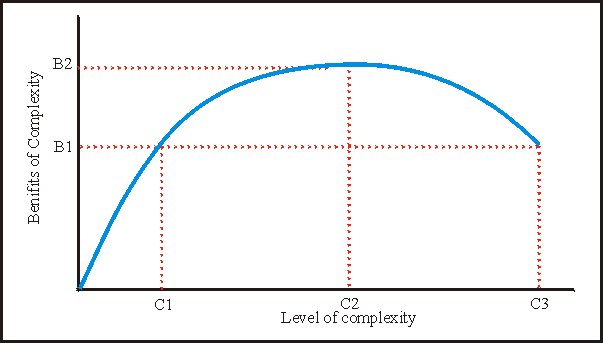
As Joseph Tainter has explained, building more complexity with more technology and energy yields diminishing returns to point C2, beyond which it starts destroying quality of life.[3]
Most readers can imagine the 1800s, prior to the pervasive use of fossil fuels. If we were to assess the availability of energy from the vantage point of the Western world in the 1880s, what would we find? Could we re-organize our social frame of reference in ways to improve our chances of living within the limits of our natural resources? How much of the knowledge acquired since the 1800s would help to improve quality of life over what we were able to achieve prior to the beginning of that period?
In recognizing that access to knowledge may not mean, at the same time, access to today’s technologies developed from that knowledge, we can begin to come to terms with the energy costs of every technology, every act of production. We can ask ourselves whether the exertion is worth the price, and we can make this assessment from informed and sensitive perspectives. Worth noting is that like energy itself, every technology has life-cycle energy costs. When we evaluate the energy required to create a product, also known as a product’s embedded energy, we make better decisions about whether we can afford the product in question.
One of the benefits of assessing the potential for future energy consumption today is that we are able to use the tools presently available to us. Such tools include the internet and associated information technologies; products that capture energy, such as wind and solar technologies; and technologies related to advances in medicine, the production and distribution of food, and the use of materials ranging from metals to silken mesh, just to name a few. In these and other similar examples, our use of relevant technologies has capitalized on fossil fuels. We can use the investment in knowledge as we learn to live with less energy. According to environmental scholars Odum and Odum, “Precedents from ecological systems suggest that the global society can turn down and descend prosperously, reducing assets, population, and unessential baggage while staying in balance with its environmental life support system. By retaining the information that is most important, a leaner society can reorganize itself and continue making progress.”[4]
Material Benefits of Energy Descent
Before the broad availability of fossil fuels, the ecological burden that human populations imposed on the environment, as measured in depletion of raw materials and rates of damage to ecosystems, was much lower than it is today. Although the environmental movement has tried to influence the use and protection of resources, diminishing access to cheap energy will offer solutions to many problems that we experience today, including overshoot, or over-population, and breaches of carrying capacity, otherwise defined as the inability of resources to sustain populations without degrading the environment. Simply by shrinking the industrial economy, which slows the rate of damage, we can expect the following effects on some main problem areas:
-
Slower depletion of non-renewable resources and slower depletion of things that are either slowly renewable or renewable at a high cost. Recycling will become a necessity, a “growth industry.”
-
Less chemical pollution of soil, air, and water, including greenhouse gas production.
-
Serious reductions in the human invasion of the ecological niches of other species, as well as reductions in the resulting mass extinction of species. When we cease to use resources at the increasingly higher levels of the last 200 years, and the earth returns to a carrying capacity that ecosystems had developed in the preceding millions of years of natural history, we can expect greater environmental and ecological balance.
-
Diminishing capacity for modern warfare, with its impersonal, long-distance carnage,[5] and diminishing capacity for the long-distance institutional violence of modern economic empires. For example, many have argued that the wars in Afghanistan and Iraq have been resource wars, undertaken in response to U.S. concerns about dwindling access to liquid fuels. Whatever the cause, the results have been devastating for all social groups involved, in part because of the high-tech capabilities on every side of the disagreement.
Social Benefits of Energy Descent
Arguably the most important benefits of lower energy use (which means functioning at a lower level of complexity) are its social implications for increased security, better social relations, economic restructuring, political decentralization, and healthier lifestyles.
Security
For most of us, the wealth and income that we achieve in our present economy offer little real security, because receiving them fails to confer direct power over them or their sources. As the dominant organization of economic life becomes more brittle and unreliable, its ability to provide economic security will decline, and a subsistence perspective will become more attractive to individuals and communities, because it will offer economic security through more resilient structures. Rather than a return to a particular historic model of a subsistence economy, a subsistence perspective may in fact offer something deeper: a view that seeks to regain the economic security and other benefits—mutualism, reciprocity, and production for use-value rather than market value—that characterized historic subsistence economies.[6]
Besides offering economic security, a subsistence perspective is a view of empowerment that gives priority to the ability to produce or obtain the necessities of life through control over the necessary resource base (land, plant, and animal seed stock and their genetic heritage, income from household work, etc.).[7] Hence, a subsistence perspective has the potential to empower people who can see, hold, and refer to the means of their production. For example, economic relocalization can increase economic security by achieving food sovereignty. On the other hand, in the present global economy, growing mangoes empowers few in Nicaragua if the control over the mango plantations and markets lies in the hands of transnational corporations in New York. In fact, Nicaragua suffers distinct disadvantages: the industrial agricultural practices of Transnational Corporations, also referred to as TNCs, destroy soil fertility and pollute the environment, the mangoes do not enter the local food economy because they bring a better price in New York, and the mango plantations displace local food production, weakening food security for Nicaraguans. This example describes a global pattern in the present system. Similarly, the advantage to local communities of producing milk in the favorable conditions of New York State’s dairy country is largely lost because corporate monopolies control milk markets, and much of the milk is shipped elsewhere.
When it becomes clear that long-term inflation or its equivalent has been baked into the U.S. financial cake, and that time spent making money that only shrinks in value is a veritable treadmill experience, people will discover the relative advantages of time spent producing the essentially inflation-free goods of subsistence, goods such as food, shelter, and clothing. Such items must be produced and maintained, but they have a salutary affect on one’s well-being and sense of achievement.
Social Relations
Societies will need to replace technological solutions with ones based more on human relations, which will in turn stimulate the rebuilding of the local community, including the revival of the collectively managed commons.[8] We can see an example of the good that accrues with this approach in the social and commercial successes of the Ithaca Farmers’ Market, as well as in similar enterprises in villages across Tompkins County.
As economies return to more local production, gender relations may improve. Compared to modern society, peasant societies demonstrate more balanced gender relations, since women are often in control of markets despite distinct gender roles in the division of labor.[9]
In human-scale economies, communities are more aware that economic health increases with equality and its broadened purchasing power. In some peasant communities, merchants vary prices according to a buyer’s ability to pay. For example, even in Bavarian villages of several decades ago, villagers could recall a time when general stores practiced a sliding price scale as well as indefinite credit accounts that acted as a kind of debt jubilee. These customs have been contrasted with the practice of maximizing profits, a practice that has come to dominate modern capitalist economies.[10]
The increasing strength of the informal economy at a human scale, including to some degree the gift economy,[11] carries its own potential benefits to the social health of the community. An example of the potential, at least, of the latter, might be time banking, which has been under consideration at intervals in Tompkins County. Time banking is just one way to jump-start a gift economy, and it has the advantage of avoiding a currency, along with the capacity to advance interest-free credit.
Economy
Much that is harmful in the present economy will become too costly to prolong, at least at present levels—the constant advertizing blitzkrieg; the “happy motoring” transportation economy with its traffic, road rage, commuting, and massive inefficiencies; the long-distance, “colonial” economy that enables centers of wealth and power based on exploitation of hinterlands.[12] In the U.S., we have cannibalized much of our environment, and we have now experienced more than half a century of developing strong interests in the lands of others. As the past ten years have demonstrated, the colonialization of distant places creates many problems, no matter the benefits. Simply put, the enterprise is costly.
As happened in the collapse of the Soviet system,[13] an informal food economy (theoretically illegal in the former USSR) can put a floor under economic collapse. In much of the world it already does; three quarters of the world’s economic activity operates as an informal labor economy.[14] The informal economy expanded rapidly in the U.S. during the Great Depression,[15] as was the case when farmers worked on others’ farms, in exchange for similar labor on their own farms.
Polity
As the cost of governing at state and national levels becomes unaffordable, the capacity for social control at those levels may weaken, creating a power vacuum and opening political space for more decentralized power structures, which in turn may allow people more participation in the decisions that affect their lives. In Tompkins County, our local system of government is such that residents frequently have the opportunity to participate on committees and boards during short- or long-term proceedings. The local approach to the recent development of Agricultural Plans in several Tompkins County towns is one such example.[16]
As in all periods of instability, the coming one presents an opportunity to break with a long historical period characterized by hierarchical structures of dominance and experiment with more horizontal structures of decision making.[17] European colonization of the New World offered such a break, occasioning much social experimentation.
Culture and Lifestyles
The more labor-intensive form of agriculture that industrial societies will be forced to adopt as available energy declines will put people into a healthier relation to the rest of nature, giving them a physically and mentally healthier lifestyle, geared to natural rhythms rather than the hyperactive patterns typical of urban life. We can also expect that increased exercise associated with less reliance on present modes of mechanical transportation and the ubiquitous use of labor- and energy-saving devices ranging from snow blowers to elevators will lead to improved health outcomes.
The increasing costs of discretionary consumption may force society toward more satisfying behaviors. Cross-cultural studies provide evidence of an inverse relationship between happiness and material prosperity.[18] As the market price of frenzied consumerism rises, so that the manufacture of desire via ads that pander to commercial wants is no longer enough to maintain the addiction, other values will have a chance to surface and eventually prevail. When the energy available can no longer support today’s commercialized spectator culture, people will return to more satisfying, participant forms of cultural activity. We can imagine relational activities, in which people share work and meals and stories in a community of effort toward shared goals.
Local diversity of all sorts—physical, biological, economic, cultural, etc.—will return to replace the uniformity imposed by global capitalism once localities again become free to display their distinctive characteristics. Such diversity represents the natural adaptations to local physical realities and is healthier than the tendency of the current system to fit everything on the planet into the same marketable industrial mold.
In Summary: Localization and Salvage
Benefits of the energy descent are not instantaneous; they appear gradually as we learn to use the opportunities of localization. A view from the Transition Movement may be apt:
All the research I’ve seen, all the thinking I’ve done, and all the people I’ve talked to suggests to me that localisation will do a better job of meeting people’s needs—people will be happier and will live in a more socially cohesive way and more sustainably.… They’ll find that their community is providing them with more opportunities to enact those needs and those intrinsic values. They’ll find that they’re experiencing fewer barriers to enacting the intrinsic values and satisfying their needs.[19]
If John Michael Greer, long-time energy observer and commentator, is right about his eco-successional theory of collapse,[20] breathing room will be available during the transition. As he sees it, in a first era of “scarcity industrialism,” as the limits to growth kick in, the industrial system will work, but less and less reliably, and will provide both time and incentives to evolve adaptive habits and structures of cooperation, localization, self-reliance, and voluntary simplicity. Greer argues that the accumulated wealth and power of a century of superpower status will give the U.S. adequate clout to provide temporary fixes while things fall apart. Even in the subsequent age Greer envisions of “salvage societies,” the immense accumulated built environment of the age of abundance in which the heavily industrialized nations have been living will serve as a store of useful raw materials, a bonanza unknown to earlier low-energy civilizations.
Notes
[1] Bardi, Ugo. “Peak Civilization: The Fall of the Roman Empire.” http://europe.theoildrum.com/node/5528
[2] Bardi, op. cit.
[3] Tainter, Joseph. 1996. “Complexity, Problem Solving and Sustainable Societies.” http://dieoff.org/page134.htm
[4] Odum, Howard T., and Odum, Elisabeth C. A Prosperous Way Down: Principles and Policies. University of Colorado Press, 2001.
[5] Klare, Michael T. “The Pentagon vs. Peak Oil.” http://www.energybulletin.net/node/31067
[6] Mies, Maria, and Bennholdt-Thomsen, Veronika. The Subsistence Perspective: Beyond the Globalized Economy. New York: Zed Books, 2000. Also a talk by Mies, http://republicart.net/disc/aeas/mies01_en.htm.
[7] Mies and Bennholdt-Thomsen, op. cit.
[8] Ostrom, ed. Governing The Commons: The Evolution of Institutions for Collective Action. Cambridge University Press, 1990. http://www.cooperationcommons.com/node/361
[9] Mies and Bennholdt-Thomsen, op. cit.
[10] Mies and Bennholdt-Thomsen, op. cit.
[11] Graeber, David. Toward an Anthropological Theory of Value: The False Coin of Our Dreams. Palgrave Macmillan, 2001.
[12] Berry, Wendell. The Unsettling of America. Sierra Club Books; Revised edition, 1996.
[13] Orlov, Dmitry. Reinventing Collapse: The Soviet Example and American Prospects. New Society Publishers, 2008. Also “Closing the Collapse Gap.” http://www.energybulletin.net/node/23259
[14] Astyk, S. “Elephants: Involuntary Simplicity.” http://www.energybulletin.net/node/47405
[15] Astyk, op. cit.
[16] See the TCLocal article “As Local As It Gets: The Town of Ithaca Agricultural Protection Plan.” http://tclocal.org/2012/01/as_local_as_it_gets_ag_plan.html
[17] Korten, David C. The Great Turning: From Empire to Earth Community. Kumarian Press, 2006. Also the interview “A Defining Moment in History.” http://www.youtube.com/watch?v=6n7prGOvyGU&feature=related
[18] Goldberg, Carey. “Materialism is bad for you, studies say.” www.nytimes.com/2006/02/08/health/08iht-snmat.html
[19] Hopkins, Rob. “Does Transition Build Happiness?” http://transitionculture.org/2011/10/21/does-transition-build-happiness-an-article-from-the-latest-resurgence-magazine/
[20] Greer, John Michael. The Ecotechnic Future: Envisioning a Post-Peak World. New Society Publishers, 2009. See also Greer’s blog entries “The Age of Scarcity Industrialism” (http://thearchdruidreport.blogspot.com/2007/10/age-of-scarcity-industrialism.html) and “The Age of Salvage Societies” (http://thearchdruidreport.blogspot.com/2007/10/age-of-salvage-societies.html).
By Jon Bosak
As regular TCLocal readers know, we are deeply concerned about our local ability to feed ourselves, and we have published a number of articles on the need to preserve local agricultural production.
There was some good news on the local food security front this fall. One recent critical success was the election of antifracking candidates in several Tompkins County towns, which for the moment at least has challenged the claimed right of area landowners to extract short-term profits at the expense of the long-term health and agricultural productivity of local farmland. The other development was the November 2011 approval of the Town of Ithaca Agricultural and Farmland Protection Plan (AFPP) by the Ithaca Town Board and the preparation of similar plans for the Towns of Lansing and Ulysses.
A copy of the Town of Ithaca AFPP can be found here:
http://www.town.ithaca.ny.us/draft-agricultural-and-farmland-protection-plan
Adoption of the AFPP is important not just to the twenty thousand residents of the Town of Ithaca but also to the thirty thousand residents of the City of Ithaca, because it puts the Town firmly on record in support of preserving the remaining agricultural land in Tompkins County situated closest to City residents; food produced in the Town is as local as it gets in Ithaca.
Even more importantly, the Town of Ithaca AFPP provides a preview of the plans currently in preparation in Ulysses and Lansing, which are aimed at preserving their much larger agricultural acreage and are being prepared by the same team of experts (Monika Roth and Debbie Teeter of Cornell Cooperative Extension with the assistance in each Town of municipal staff and volunteer ad-hoc committee members). These other AFPPs, funded like Ithaca’s by grants from NYS Agriculture and Markets, can be expected to share many of the same qualities that make the Ithaca plan such an important contribution to our local food movement, but on a larger scale.
The formal purpose of the AFPP is to identify precisely the agricultural lands in the Town most deserving of protection in order to lay the groundwork for future requests for funding, in particular funding for the purchase of development rights (PDR) to compensate landowners in return for an agreement to keep the land in production and out of development. Along the way, however, it also makes important contributions to agricultural policy and to our access to knowledge about the Town’s agricultural resources while laying the groundwork for improved relations with the Town’s farmers.
First and foremost, the Ithaca AFPP clearly enunciates a Town policy supportive of agriculture and the preservation of existing farmland:
The Town of Ithaca recognizes that agriculture is an integral part of the Town’s economy and environment, provides locally grown food and other agricultural products, and enhances the quality of life for Town residents. The Town proactively promotes a diversity of farm types, seeks the long-term preservation of the Town’s agricultural-land resources, supports the economic viability of the farming community and the profitability of each farm, values the local public agricultural research and educational resources, and encourages the general public to understand and support local agriculture.
This strong commitment to the preservation of agricultural land in the Town comes at a critical time in the process of preparing the long-awaited update to the Town of Ithaca’s Comprehensive Plan, the current version of which dates from 1993. As noted in the AFPP,
It is anticipated that the recommendations from this AFPP will be incorporated into the updated Comprehensive Plan and that the entire AFPP will be included as an appendix to the Comprehensive Plan.
Inclusion of the AFPP recommendations in the revised Comprehensive Plan should result in the assignment of higher priority to the preservation of active and potential farmland in the Town and less to residential development that would take land in the Town out of production. This is good news for everyone concerned with the distance food has to travel to come to consumers in the City of Ithaca, which for many reasons is already a more logical place to develop additional housing.
Beyond setting a general policy of protecting farmland in the Town, however, the Ithaca AFPP also puts the Town on record as adopting several specific goals of the Plan:
Promote the availability of locally grown foods and other agricultural products for all residents, including limited income families
Retain and encourage a diversity of economically viable farm types
Ensure long-term protection of agricultural-land resources for agriculture, open space, and scenic resources
Encourage public understanding and involvement
Promote wise land use and waste management on agricultural land
To accomplish these goals, the AFPP sets forth a number of concrete objectives, the job of implementing which will now fall to the Town Board and Town Planning Department.
Some key objectives are:
To revitalize the Town Agricultural Committee (the AFPP includes the draft of a new Ag Committee structure designed to help local farmers fit meetings into their schedules)
To designate a member of the Town staff as the “go-to” person for farmer interaction with the Town
To revise local zoning, building, and signage laws to decrease development pressure, reduce conflict between farms and non-farming neighbors, ease restrictions on farm construction projects, and promote income through farm stands on local roads
Specifically, the AFPP sets forth the following plan for implementation:
Strengthen the relationship between Town farmers and Town staff
Encourage farmer representation on the Town Board, Planning Board, Zoning Board of Appeals, and Conservation Board
Designate a Town staff person to be a farmer contact
Educate Town of Ithaca staff and decision makers regarding the needs, benefits, and operational aspects of agriculture and how these are affected by the Town’s permitting processes
Ensure that Town staff is respectful and courteous in dealing with the agricultural community
Support the implementation of the Town of Ithaca Agricultural and Farmland Protection Plan
Adopt the Town of Ithaca AFPP as part of the Town of Ithaca’s current Comprehensive Plan update
Encourage the Town’s Agricultural Committee to take an active role in the implementation of the AFPP
Actively seek State, Federal, private, or other sources of funding to assist in implementing the recommendations in this AFPP
Use the Implementation Chart below as a list of implementation activities and to establish time frames and expectations for implementation
A copy of the Implementation Plan (including the Implementation Chart referred to above, which assigns specific time horizons and responsible organizations for each element of the Plan) is linked from here:
http://ibiblio.org/tcrp/ag/TOI-AFPP-Implementation-Plan.pdf
The Plan includes some 50 recommended actions to be carried out by partnerships of one kind or another between the Town of Ithaca, the Town of Ithaca Agricultural Committee, Cornell Cooperative Extension of Tompkins County, New York State, the New York State Department of Conservation, the Soil and Water Conservation District, the Tompkins County Farmland Protection Board, and the Tompkins County Council of Governments, and it specifically identifies which of these players will need to be involved in implementing each recommendation. Among the steps to be taken are actions intended to moderate traffic around farms, encourage new smaller-scale farming, promote agritourism, improve retail sales (including sales from roadside stands), provide listings of land for lease, encourage shared infrastructure development, and make the Town government more farmer-friendly. There are also steps to encourage community gardening and educate the public regarding the rights of farmers.
The following actions are identified in the Plan as both “especially critical to supporting agriculture in the Town” and capable of being carried out by the Town acting alone, without depending on other organizations:
Revise Zoning and other Town Ordinances (e.g., Sign Law) to accommodate farm stands, year-round farm markets, greenhouses, value-added product operations, home food production, U-picks, Community Supported Agriculture (CSA), and agritourism sites
Review and revise regulations pertaining to structures to accommodate farm operations (e.g. Sprinkler Law, use of rough-cut timber, property-maintenance law)
Reactivate and support the Town of Ithaca’s Agricultural Committee
Enhance zoning as a tool to control non-agricultural development on or adjacent to agricultural land
Continue implementation of the Town’s current agricultural conservation easement acquisition (PDR) program for appropriate agricultural parcels that have been targeted in the Policies and Procedures Manual for the Agricultural Land Preservation Program
These steps are not only completely under the Town’s control; they are (with the exception of the PDR program) without significant financial impact, and given their importance, we can hope that the Town will soon begin work on them. But there are a number of other recommendations in the Plan that can also be carried out simply by changing existing Town regulations or by adopting certain policies (for example, changing the signage laws to allow better advertising of farms, or limiting extension of municipal sewer and water in agricultural areas to discourage residential development). Such reforms will have little or no budgetary effect, and there should therefore be no impediment to their implementation by the Town now that the AFPP has been adopted.
Beyond setting important new policy directions, the AFPP also provides a wealth of critical information about the Town’s agricultural resources that would otherwise be difficult to assemble. In addition to a historical and statistical overview of farming in the Town, the AFPP also includes a collection of maps showing the Town’s agricultural resources at a level of detail ordinarily available only to Town and County planning staffs. The maps of Zoning, Agricultural Soils, and Existing Land Use / Land Cover are particularly interesting. For convenience, we’ve packaged the AFPP maps into a single PDF file that can be downloaded from here:
http://ibiblio.org/tcrp/ag/TOI-AFPP-Maps.pdf
While our concern in TCLocal is with local food production, it should be noted that much of the public interest in preserving farmland in this area is based on quality-of-life considerations. In a survey of Town residents conducted in 2009 and included in the AFPP, 70 percent of the respondents rated the existence of farmland as “Important” or “Very Important” to their quality of life, with a similar combined rating (72 percent) for “Ability to buy locally produced farm products.” An even higher proportion (91 percent) gave this combined rating to “Scenic views,” which is relevant because farmland is essential to the existence of a number of the Town’s best views as identified in its scenic views inventory. In another part of the survey, 82 percent of Town residents said that they “Support” or “Strongly Support” spending Town money on “Protecting farmland from development.” Thus the preservation of farmland for relocalized food production in our region is building upon a general recognition of farming as an important component of the local character.
Whatever the current motivation, it is encouraging to see the adoption of land use policies that will help promote local food production. Everyone concerned with sustainability in Tompkins County should applaud the already adopted Town of Ithaca AFPP and the Lansing and Ulysses plans currently nearing completion.
By Simon St.Laurent
One of the most common complaints about the industrial age is its constant and seemingly ever-growing use of sweeteners. Whether it was cheap sugar (and rum) in the early 1800s, saccharin in the early 1900s, or high-fructose corn syrup in the late 20th century, sweeteners have had a bad—but tasty—reputation.
In a local context, however, sweeteners are extremely important. Many of the local fruits that contain Vitamin C, for instance, are difficult eating unless sweetened. Aronia Melanocarpa is called "chokeberry" for a reason. Black currants are difficult eating off the bush. The more familiar perennial rhubarb also becomes far more enjoyable with sweetening. Even in less extreme cases, sweeteners can certainly add enjoyment to foods otherwise too bitter or too bland to be attractive. Sugar is also very important in preserving food, where it creates a hostile environment for bacteria as well as a delicious treat.
Many different sweeteners are available today, though they may become more or less important in localization or energy descent situations. Some require industrial facilities and major energy inputs, and a few are dangerous, but many familiar sweeteners will likely remain available into even an uncertain future.
Sugar and Molasses
Sugar cane, a tropical plant, doesn't grow in Central New York. United States sugar producers are in Louisiana and Florida, though sugar refineries have been prominent features of port cities along the coasts. Modern sugar production relies on energy-intensive industrial processing and distribution. Cane sugar's long history, however, suggests that it and its by-product molasses can still be valuable with reduced processing, as extracting sugar is relatively simple and can be fueled with the cane that created it[1]. Sugar distribution and storage are similarly simple, as it is easily packed for safe storage.
Sugar produced from beets has many of the same issues as cane sugar, but unlike sugar cane, sugar beets can be grown in New York State. However, the quantity of sugar beets currently grown is small enough that the USDA National Agricultural Statistics Service[2] doesn't even offer sugar beets as a query option for New York. Today, sugar beets receive more industrial processing than does sugar cane, despite containing 17% sugar while cane contains 10%. Unlike cane, beets cannot easily be processed using their byproducts for fuel. (The byproducts are typically used as animal feed.) Sugar beets are also typically used as a crop in rotation, so the yield per acre is substantially lower than that of cane.[3] Sugar beets can be processed at home on a small scale by chopping, boiling, and evaporating, however.[4]
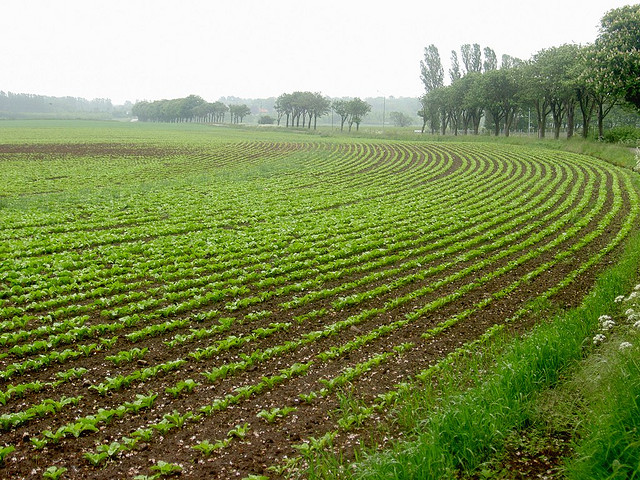
Figure 1. Sugar beet field, Sweden (original source, used under Creative Commons license from Dag Endresen.)
The primary questions about sugar in an energy descent situation revolve around price, distribution, and quality.
Though sugar in the United States is expensive relative to sugar in the rest of the world (roughly double the Canadian price because of American import quotas[5]) it remains a remarkably cheap commodity by historical measures. As the energy costs of sugar refining climb, those prices will likely climb. Diversion of sugarcane to ethanol production may also shrink the available supply of sugar substantially, also increasing the price.
If energy costs climb, the cost of distributing sugar, especially cane sugar coming from a distance, will climb. Sugar works well with slower and less energy-demanding forms of transport, but transitions to new distribution patterns may take time. Disruptions may also be more difficult because of the longer supply chain of cane sugar.
While less-refined sugar has become a high-end product recently, most people still expect their sugar to be a pure white with a relatively neutral taste and predictable cooking behavior. If the extra energy cost of refining to white sugar climbs, more people may need to get used to less-refined sugar.
It may be possible to create a substantial sugar beet industry in New York State—or it may make sense to count on sugar's relatively easy tradability to keep it available.
Corn sweeteners
Corn-based sweeteners thrive today because of a combination of the import quotas noted above and subsidies for corn production. Dent corn is converted into corn starch by a wet millling process and then treated with enzymes to produce corn (glucose) syrup. High-Fructose Corn Syrup (HFCS) is made by an additional enzyme process to convert much of that glucose to fructose.[6] This is a strictly industrial energy intensive process:
Corn wet milling is the most energy intensive industry within the food and kindred products group, using 15% of the energy in the entire food industry. After corn, energy is the second largest operating cost for corn wet millers in the United States. A typical corn wet milling plant in the United States spends approximately $20 to $30 million per year on energy.[7, page 3]
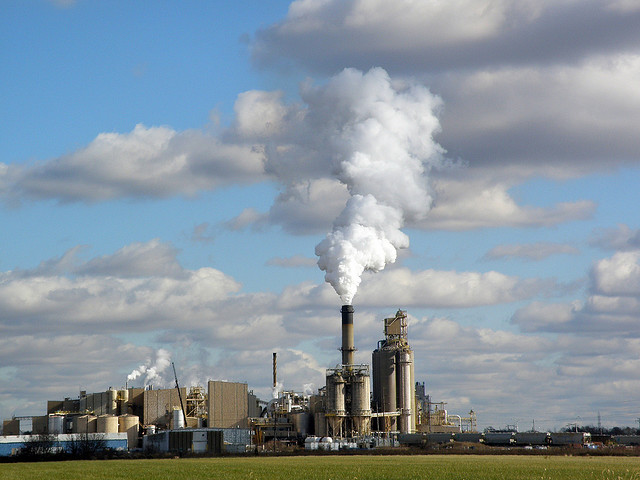
Figure 2. Wet corn mill (original source, used under Creative Commons license from Jim Hammer.)
While dent corn can be grown locally, the industrial scale and energy requirements of wet corn milling seem to put local corn syrup out of reach. There was a corn wet mill in Montezuma, New York, just up Cayuga Lake, but it closed in 1986.[7, page 73] Like sugar, corn syrup can be easily transported and stored.
Artificial sweeteners
If you count the extremely toxic "Sugar of Lead" (lead acetate), artificial sweeteners have been around for thousands of years, though the modern history usually begins with saccharin in 1879. While it is likely possible to create most of these sweeteners in the laboratory facilities available at Cornell, most of them are produced today in large volume at chemical plants.
As many artificial sweeteners (notably neotame, aspartame, saccharin, and sucralose) are sweeter by volume than sugar, and store reasonably well, they may be easier trade goods than sugar itself. Xylitol, mannitol, and sorbitol, the sweet alcohols, are roughly as sweet as sugar and are useful both to sweeten food for diabetics and potentially as a tooth decay preventative.
Lead acetate deserves special attention as a danger, as it is not difficult to synthesize from lead and has commonly been used as an adulterant in foods and drinks.
Honey
Honey is a commonly available sweetener that can be produced in large quantities in the Finger Lakes region. Beekeepers encourage hives to produce more honey than they need to survive the winter, then take the extra honey for human consumption.
Beekeeping is a complex art, though it scales down to the household level more easily than the production of many other sweeteners. Keeping hives alive has become more difficult in recent years with the spread of pests, notably varroa mites, but the infrastructure and learning investments required to become a successful beekeeper are still fairly small.
Until the mid-19th century, beekeepers used hollow logs or straw houses, called skeps, for their bees. While these worked, they didn't allow beekeepers to inspect the hive for disease, and the hive usually had to be destroyed to retrieve the honey. Because of disease issues, skeps are illegal in the US.
Most beekeepers use Langstroth hives, rectangular boxes filled with frames in which the bees make their home. So long as beekeepers maintain precise distances between equipment inside of the hive, the bees will avoid gluing everything together. This flexibility makes it simpler for beekeepers to inspect the hive, as well as to add and remove equipment to gather honey. Langstroth equipment does require a fairly substantial investment, and most beekeepers buy sturdy frames filled with wax or plastic foundation printed in a hex pattern. This gives bees a bit of a head start, and reinforcements in that foundation make it much easier to extract honey by spinning the frames mechanically.
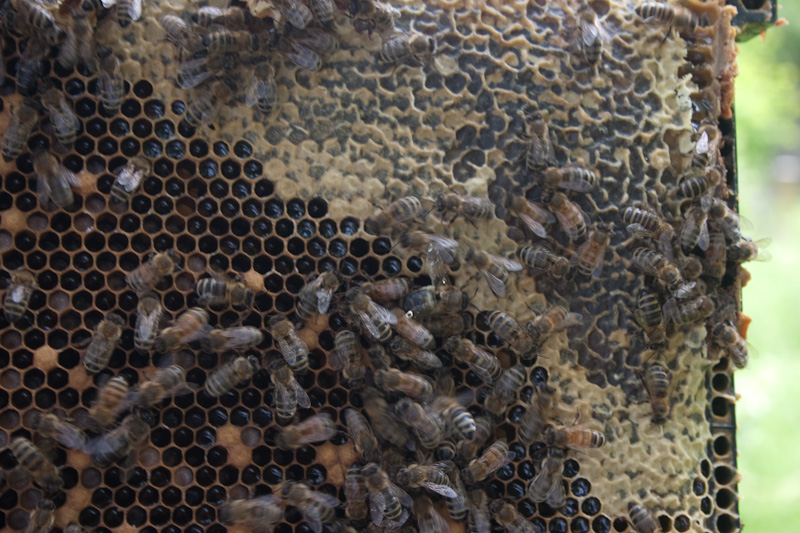
Figure 3. Bees on framed comb, honey top right, brood lower left. (Photo Simon St.Laurent.)
It is possible, though slow, to replace frames with bars with a simpler strip of wax on the bottom and have the bees build their comb on that, but the frames will be less regular and more difficult to use with an extractor. Taking that idea further, some beekeepers are using top bar hives. These hives fit into a single box organized horizontally rather than stacked vertically. The bees build their own comb, and beekeepers who want to collect the honey press or cut the comb instead of spinning it. This destroys the comb, requiring the bees to work harder to make new honey, but requires less dedicated equipment.
While much beekeeping equipment can be built from readily available wood and metal, two pieces of the beekeeping system are more difficult. The foundation is generally manufactured, though it can be created on a smaller scale using old equipment like some of that on display in the Dyce Lab at Cornell. The harder challenge is the supply of bees and queens. New bees and queens can be raised in the north, but at present most nurseries for bees are considerably farther south and rely on express delivery services. Local breeding has become more popular as a way to improve bees, so this may not remain an issue for very long.
Beekeepers are facing an ever-wider variety of diseases and parasites. While Colony Collapse Disorder (CCD) made headlines, most beekeepers are battling a variety of problems, most notably varroa mites. Chemical solutions can keep mites at bay, but mites seem likely to be a permanent feature of beekeeping at this point. Integrated Pest Management (IPM) mixes chemical and other approaches, focusing on keeping hives going. Inspection, now an optional event in New York State, may become especially important again if beekeepers have to rely on their own production of bees rather than importing new ones from the south.
While some beekeepers might find warmer weather convenient, changing weather patterns, especially if extreme weather becomes more common, could create difficulties. Rain and snow can keep bees in their hives and prevent their collecting food, while drought can delay or hinder plants from flowering. Bees also fly much less when temperatures are 90° F or higher, staying home to cool the hive. Bears moving north present another challenge.
Maple Syrup and Maple Sugar
Upstate New York has been producing maple syrup and maple sugar for centuries. Native Americans taught European settlers about collecting and concentrating sap, and Europeans gradually technologized and standardized the process. It was a key part of the development plan for early Cooperstown, though visions of maple fortunes faded quickly[8], and the energy and infrastructure challenges of making maple syrup have kept it from competing with cane or beet sugar. (Beet syrup starts at a concentration of 6 parts water to 1 part sugar, cane syrup starts at 10:1, and maple sap is at 40:1.)
While many modern maple syrup producers use plastic tubing to collect the sap, simple metal taps and buckets can provide a sustainable (if labor-intensive) collection system. Even a simple pot can work for boiling down sap, though large flat pans and especially more complex flue pans make it much easier to evaporate sap down to syrup. An indoor wood stove already used for heat can boil syrup at the household level, while a sugarhouse with vents is likely a better idea for a larger pan. A sugarhouse will need a dedicated supply of wood (or other fuel), but that is frequently available in the same areas as maple stands.[9]
While sugar maples (Acer saccharum) are the traditional tree for maple syrup production, red, black, and some silver maples can also be tapped, as can box elders and birches.
At any scale, however, maple faces some challenges. The flow of sap depends on the weather, particularly on the contrast between daytime and night time temperatures. Sap flows during the day, carrying sugar from the roots. A winter that turns too suddenly into spring can disrupt maple production, as can seasonal storms that make it difficult to collect and evaporate syrup. The short season and its unreliability make maple syrup a risky product. While it is not difficult to preserve maple syrup, its greater water content makes it more likely to spoil than honey or sugar. (Maple syrup can be made into maple sugar, at a large energy cost in additional refining.)
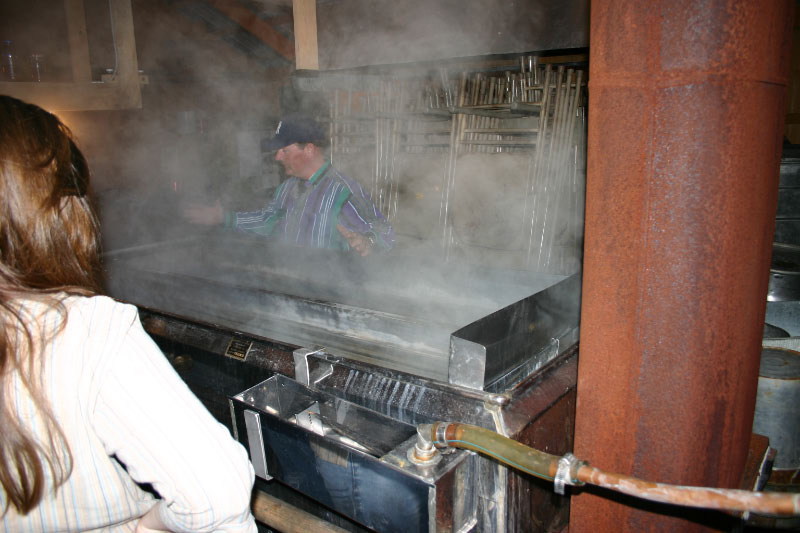
Figure 4. Evaporating syrup in Marathon, NY (photo Simon St.Laurent)
Maples also face environmental challenges. Climate change may shift the range northward, giving hickories and oaks an advantage while limiting maples. Long-term changes in spring weather patterns could also complicate or reduce the maple season further. The Asian Long-Horned Beetle, already present in New York City, attacks and weakens maple trees and a variety of other species. Larvae tunnel through the wood, weakening the tree.[10] These beetles may reduce the number of healthy maples and make it more difficult for new maples to survive.
Sorghum
Sweet sorghum, though traditionally grown further south, can produce a syrup similar to molasses, as well as silage or forage for animals. Some farmers are experimenting with it in Tompkins County as a cover crop and animal feed today, and it may be an appealing option if climate change extends the growing season.
Processing sorghum for syrup requires stripping the leaves and seed head off the cane, then squeezing the juice out of it and evaporating and skimming that juice. Crushing the cane is generally done with a simple mill, and the resulting juice yields about a gallon of syrup from ten gallons of juice.[11]

Figure 5. Sorghum mill (original source, used under Creative Commons license from g-s-h.)
Fruit Juices
Fruit juices and concentrates, and even applesauce, are classic sweeteners. While whole fruits are, of course, a delicious way to enjoy fruits, juicing and similar processes make it much easier for people to consume fruits that are bruised, damaged, or simply useful as a background sweetener rather than as the primary flavor. Commonly available apple and grape juices, both products of Upstate New York, are regularly used to provide bulk and sweetness to more expensive juices like cranberries, blackberries, blueberries, or (more recently) pomegranate.
Like fruits, fruit juices can be canned or frozen. They require more energy input to preserve than do sugar or honey, but are easier to create with ordinary pots or pans or with simple tools like steam juicers. They scale up to greater volumes easily as well.
Malt
Grains are another common source of sweetness. Malting grain is a fairly complex process involving drying, storing, adding water, partially germinating, and then processing and often mashing. Today most malting relies on industrial equipment and purpose-built malting floors, but the basic steps can be done with simple equipment on a wide variety of scales.
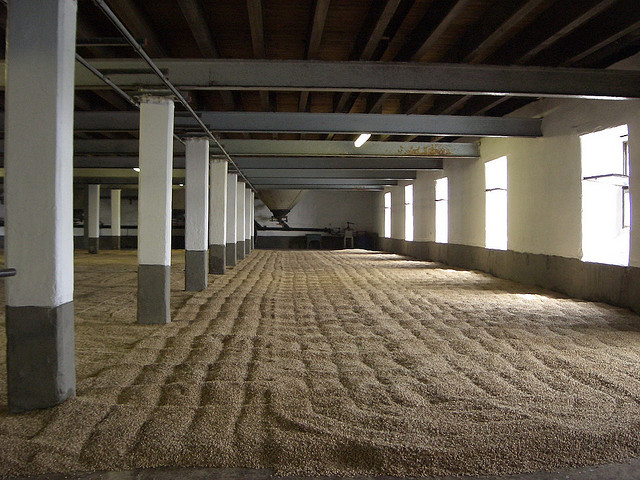
Figure 6. Malting floor (original source, used under Creative Commons license from Chris Sharp)
Malt is most commonly used as a fermentation base for beer and whiskey, but it is also a key component in malted milks, malt vinegar, and malt candies. Barley is the most common grain used for malting. Many grains are bred specifically to provide the enzymes needed for the malting process.
Stevia
Stevia is a relative newcomer, at least in the United States. The plant Stevia rebaudiana, originally from South America, has leaves that are approximately 30 times sweeter than sugar, and its core sweetening compounds are approximately 250 times sweeter. The Food and Drug Adminstration has allowed the sale of stevia as a food supplement but not as an ingredient, though stevia-derived sweeteners are now legal for use.

Figure 7. Stevia plant. (original source, used under Creative Commons license from Irene Kightley)
Stevia's climate expectations limit its use for large-scale plantings in Tompkins County. However, it may prove useful as a household-scale sweetener, especially for people who have difficulties with other sweeteners. It can grow as a window plant, getting the sun that it needs while avoiding the cold. Stevia leaves can be used directly as a sweetener without further processing.
Alcohol
All of the natural sweeteners except stevia can be converted into alcohol through fermentation, possibly followed by more energy-intensive distillation. Malt is traditionally used for beer; fruit juices for wine; hard cider, and brandies, honey for mead; and sugar and molasses for rum. In addition to its intoxicating qualities, alcohol can be used as a preservative and to sterilize medical equipment and wounds.
In an energy descent situation, however, sugars are perhaps dangerously attractive as an easy source of alcohol for fuel. Competition between food and energy uses of sugar will likely increase demand (and prices) for sweeteners.
Policy Suggestions
Some projects supporting local sweetener production already exist. Cornell's Master Beekeeper program and its work with maple products in the Arnot Teaching and Research Forest focus on honey and maple syrup. Cornell Cooperative Education offers sessions on fruit juices and preserving.
Some sweeteners, notably cane sugar and corn syrup, are unlikely ever to become local products, and most of the artificial sweeteners are unlikely to become economical local products.
Sorghum and stevia originated in far warmer climates than Tompkins County has to offer, but both are worth exploring in different contexts. For now, sorghum seems useful primarily as a cover crop, with some potential for use as a sweetener. Stevia is more promising because of its ability to grow as a houseplant, and could be an excellent target for Cooperative Extension projects and local nursery development.
There is one great danger here, something that local public health officials should watch for: the possible return of lead acetate. At present, this threat is discussed mostly in the context of imported food, but it could just as easily surface in local food. Watching for symptoms and developing testing protocols could become much more important if the price of sweeteners climbs.
[1] http://www.sucrose.com/lcane.html
[2] http://www.nass.usda.gov/QuickStats/Create_Federal_All.jsp
[3] http://www.sucrose.com/lbeet.html
[4] http://www.grandpappy.info/rsugar.htm and http://www.ehow.com/how_2177131_sugar-beets.html
[5] http://edis.ifas.ufl.edu/sc032
[6] http://www.madehow.com/Volume-4/Corn-Syrup.html
[7] http://www.energystar.gov/ia/business/industry/LBNL-52307.pdf , page 3 and 73
[8] Taylor, Alan. William Cooper's Town: Power and Persuasion on the Frontier of the Early American Republic (Vintage, 1996), 130-4
[9] Perrin, Noel. Making Maple Syrup (Storey, 1983)
[10] http://www.dec.ny.gov/docs/lands_forests_pdf/alb.pdf
[11] http://www.herculesengines.com/sorghum/default.html and http://www.motherearthnews.com/relish/making-sorghum-zb0z11zalt.aspx
By Krys Cail
Over the past decade or so, social trends have emerged that promote local economic exchange around a regional or local food system. The rise in popularity of farmers’ markets is shown by the 16 percent increase in number of markets between 2009 and 2010.[1] Grocery stores, college cafeterias, and now even Walmart stores are trying to source more fruits and vegetables from local growers.
Slow Food is an international NGO that began in Italy but is now world-wide in scope. It celebrates the local and regional culture of the table while encouraging taking the time to enjoy basic social activities, like sharing food. Indirectly, the Slow Food movement also encourages local culinary, agricultural, and wine tourism industries. In the Tompkins County area, we have made significant progress in the development of local and regional food systems, often in collaboration with the region’s grape growers and wine makers. Local food is a current focus of local interest that we would be well served to further develop in view of energy decline and the need to shorten food supply chains.
The Slow Food Movement was among the inspirations for the work of Woody Tasch, a socially responsible investing leader and author. He coined the term “Slow Money” to describe investing in the local foodshed with a portion of one’s portfolio—with an understanding that this investment might pay off better in social and environmental benefits while generating a somewhat lower financial return. His book, Inquiries into Slow Money: Investing As If Food, Farms and Fertility Mattered[2], inspired others, and a number of like-minded individuals launched an effort aimed at starting a Slow Money Movement[3]. They adopted a goal—one million people investing one percent of their assets in local food systems within ten years. They also adopted principles[4] and began working with local and regional Slow Money organizations to establish investment programs. Slow Money has gained some national recognition over the past couple of years, with articles appearing in Business Week[5] (one of their “big ideas for 2010”), Entrepreneur.com [6] (one of “five financing trends for 2011”), Utne Reader[7], Time[8], The Wall St. Journal[9], and The Los Angeles Times[10].
A local group, loosely affiliated with the national movement, has begun planning activities here in Tompkins County. This Slow Money Central New York group can be contacted through the Alternatives Business CENTS program[11] or Local First Ithaca[12].
Envisioning a new investment paradigm is difficult theoretical work, but actually implementing a system that directs flows of investment cash into local food systems is even more difficult. As a nascent movement, Slow Money has moved methodically to build a robust infrastructure for implementation. A growing national network of interested people have been considering how local groups or “Slow Money Alliances” would be structured in order to accomplish the work of bringing more investment into local food systems. The national Slow Money Alliance uses a number of other national organizations as models, including Slow Food, BALLE (Business Alliance for Local Living Economies), Social Ventures Partners, and Transition US. There is a focus on preparing for energy descent through relocalization by investing in local food systems.
Investors may have a simple need—to keep at least a portion of their portfolio invested in the local foodshed. Food buyers, both in the urban areas in the region and in the Tompkins County area, also want to buy food from nearby. This gets complicated very quickly, however, by rural/urban interdependence. Cities, and especially huge port cities like NYC, relocalize by becoming more dependent on a regional, not local, foodshed. Rural areas in the region may be dependent on investment from the urban areas. Tompkins County may or may not be in a position in the future to source investment capital from local investors alone; rural areas may find that they continue to have some dependence on larger regional centers of finance. Many Tompkins County farm and food businesses currently sell a portion of their produce to local markets, and also ship a portion to regional urban population centers, most typically NYC. Tompkins County is within the NYC Greenmarkets catchment area, and currently, many local food producers make the trip to sell in those lucrative markets. While that pattern may change some as the price of truck transportation increases markedly, it may not: sourcing fresh foods from even farther away may cost yet more, making the relative cost of Tompkins County grown food in NYC still attractive.
Additionally, wholesale foodstuff supply chains move food from local farms and food processors into urban markets. Locally-owned shipping companies, such as Regional Access[13], may adapt to new transportation approaches as fossil fuels increase in price. For example, multi-modal shipping via train and/or barge would allow shelf-stable or cooled produce to travel more economically. One gallon of fuel will take a ton of freight about 155 miles by truck, 413 miles by train, and 576 miles by barge.[14] In particular, crops such as grains, beans, seeds, oils, and meats that require a large land base for their production are likely to continue to be imported into large cities from their peripheral rural areas. In many cases, it’s more cost-effective to manufacture minimally processed foods, such as canned or dried fruits and vegetables, closer to where they are grown, and then ship them via lower-energy transport, such as barges or trains. Tompkins County is exceptionally well placed to ship local goods by water; it is possible to send goods by boat from Ithaca to anywhere on the Great Lakes, the Mississippi, or the East Coast.
The Central NY Slow Money Group has been meeting at the Alternatives Federal Credit Union[15]. The group has established a cooperative, interdependent relationship with Slow Money NYC. Central NY generally, and Tompkins County in particular, has many farm and food enterprises, but relatively fewer eager high-net-worth investors. For NYC, that situation is reversed. Some collaboration can be of value, allowing people who eat Tompkins County food to invest in Tompkins County food growers and processors, whether they live very near the farm or in the nearest megalopolis.
Access to capital can be gained by a business through an equity deal (selling portions or shares of business ownership) or through debt instruments (loans requiring a stipulated repayment schedule, but conferring no ownership rights). There are also hybrid arrangements, such as debt instruments that convert to equity shares if not repaid over a certain period. Under the current regulatory framework, it is difficult—not impossible, just difficult—to raise private equity funds for a business venture from a large number of investors of limited means. Typically, “qualified investors” (those with more than one million dollars in net worth) are able to play by somewhat different rules than the rest of us, as the regulators consider them to be savvy enough to fend for themselves in the investment world. To make an offering to a group of people who are not all “qualified investors” (for instance, the membership of Greenstar Cooperative Market), some form of an intermediary fund is probably most practical.
Cooperative membership/ownership organizations are but one model that allows for a large group of investors to provide capital and share risk. The CSA (Community Supported Agriculture) model is another approach. Slow Money groups at the national, local, and NYC levels are all exploring the best ways to facilitate these kinds of transactions, meeting the needs of businesses while mitigating exposure to risk for investors and also keeping some liquidity for investors.
Slow Money group members seek to meet two very different kinds of needs with one suite of mechanisms.
First, investors want to move beyond socially-responsible investment opportunities and now want to invest their money in businesses that have a triple-bottom-line benefit: businesses that are socially responsible and environmentally appropriate while also making some profit. People who understand the inevitability of energy decline may well want their money invested in shortening the supply chains for essentials like foodstuffs.
Second, small farm and food businesses need access to capital to grow and process the foodstuff supplies that we need in a more localized or regionalized food system. Traditional financing, still stuck in a global market worldview, is often disinclined to channel investment into the type of enterprise that could help smooth the adjustment to a world with a lot less oil.
Three opportunities for investment in Tompkins County food systems
Several local initiatives offer both Tompkins County residents and city dwellers the opportunity to invest “slow money” here. In the following, I’ll briefly describe three of them.
Local opportunity number 1: Facilitating land acquisition by prospective farmers trained at Groundswell
Groundswell[16] is a program that uses both classroom teaching and on-farm training to teach students to farm. If there is one practical suggestion for an easier transition in the face of energy decline, it is that more people need to learn to be able to grow food. In a globalized market for energy, food-growing resources have been diverted to the production of fuels such as ethanol, which, in combination with increases in costs of petrochemical inputs into industrial farming, has caused food commodities to experience great price volatility. In the near term, we are likely to see spot price run-ups and shortages, while in the long run, food grown closer to home and with more animal-power, human attention and labor, and organic inputs will be more sustainable. Groundswell’s programs are tailored to producing more farmers through a classroom-based curriculum of instruction delivered at EcoVillage at Ithaca, dovetailed with hands-on farming apprenticeship in a structured program that exposes students to many local farms. The emphasis on sustainable and organic methods prepares new farmers to farm with less reliance on fossil fuels. When newly-trained would-be farmers emerge from this training, however, they require land to farm.
Some communities, such as Burlington, Vermont, have established agricultural land specifically set aside for use by beginning farmers. The Intervale in Burlington is an area that includes community gardens as well as small acreages for use by tenant farmers who are just starting out in vegetable farming. The land has excellent soil and is close to housing in the city. The location is ideally suited for this purpose, and the property has been protected from development by the generous action of a philanthropist. Tompkins County currently lacks such tenant-farming options, but Groundswell is attempting to develop similar options locally.
Joanna Greene, Executive Director of Groundswell, has worked with local farmers and EcoVillage to establish a farm incubator program in Tompkins County. If an intermediary financial capital stream were available, the graduates of such programs would be ideally suited to match with a group of local investors. Alternatively, CSA models or direct equity investment on the part of larger, qualified investors, or debt-to-equity financing, may be more appropriate financing approaches. A “Slow Money” program could take a number of forms. Joanna has been participating in Slow Money planning talks, representing the needs of beginning farmers.
Local opportunity number 2: Facilitating grain processing for local grain farmers through Farmer Ground Flour
Grain farmers Erick Smith and Thor Oeschner joined forces with Greg Mol about a year ago to begin a grain-milling operation in Trumansburg, Farmer Ground Flour[17]. They use a modern mill that can make up to 15,000 pounds of flour a month. They began by grinding the wheat, spelt, corn, rye, and other grains they grew. At first, they had to take the grain to Penn Yan to dehusk it, but now that operation is handled at one of the farms.
They clearly hit an area of the food system ready for development. By January 2011 they were in the New York Times in an article titled “Reviving New York State’s Grain Belt”[18]. To quote from the article:
It is a cooperative effort among several farms growing organic corn, spelt and wheat, often heirloom varieties…. Packaged under the Farmer Ground Flour label, the flours are sold in paper sacks in Greenmarkets by Cayuga Pure Organics, a participant in the cooperative. The flours are fresh, and have not sat for months in warehouses.
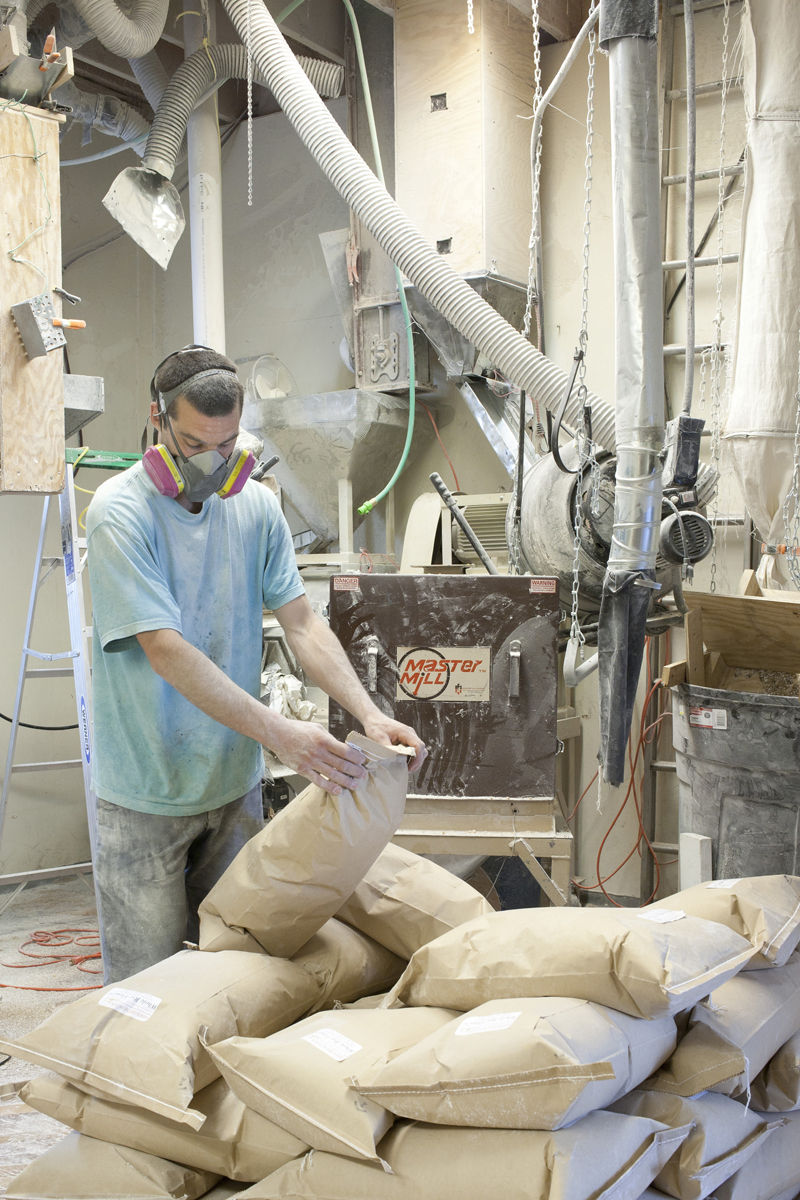
Greg Mol bags rye flour at Farmer Ground Flour
Located at the old Agway building in Trumansburg, the mill occupies a site where animal feed was milled in the past. In many ways, it is an ideal site for an enterprise that includes a lot of unloading grain from trucks and a lot of loading flour and other milled products back onto them.
Farmer Ground Flour has been very successful in meeting an emerging need for artisan-milled flours and meals in NYC. That is not, however, their only emphasis. They also sell flour and other milled products to the local market, through Regional Access, Greenstar Coop Natural Foods Market, and Garden Gate home delivery service. A recent edition of GreenLeaf[19], the newsletter of Greenstar Coop Natural Foods Market, showed the big-picture development of Farmer Ground Flour in historical perspective:
Farmer Ground’s success is part of a larger effort to restore grain growing to New York state. While now thought of as dairy country, upstate New York once grew so much grain that Rochester topped the nation’s flour production in the mid 1830s, giving it the nickname “Flour City.” (A later rise of nursery businesses changed that moniker to “Flower City.”) That flour was shipped to New York City and beyond via the Erie Canal.
Oechsner and Smith have both worked closely with Elizabeth Dyck, of the Organic Research and Information Sharing Network, which seeks to reintroduce wheat growing to New York state… [She] is working with farmers like Oechsner to identify those [varieties] that grow well in New York’s challenging climate, and, just as importantly, also taste great and bake well.
…Like other foods, “the flavor has been bred out of wheat,” [Oeschner] explained, in favor of yield and uniformity. “Growing the old wheat varieties is like growing an heirloom tomato.”
“Farmer Ground Flour is really making a difference for other farmers,” said Dyck. “They’re a great example of farmers banding together to put needed infrastructure into place, in this case a milling facility. They deserve enormous amounts of respect.”
No question, there is market interest, both regionally and locally, in the product of a local grain mill. But how does a small, “farmer-owned, grown, and ground” operation finance the necessary equipment purchases to keep up with the demand? Greg Mol, Erick Smith, and Thor Oeschner approached banks to seek financing for their equipment needs, but the amount of money that they sought to borrow was too small to fit the lending programs available. They have pursued working with individuals in the community to finance their equipment needs, but there is no organized program for doing so. The need for relatively small infusions of capital hampers their ability to expand and improve Farmer Ground Flour.
Will grain farming for human food expand in New York State only as quickly as the processing capacity is able to expand? Slow Money could be a means by which those interested in the re-development of grain farming in New York State could participate in the effort to develop the needed processing capacity. Greg, Erick, and Thor have already made connections with a few local investors to gain some access to expansion capital, and hope to do more of this in future. And the availability of their product has already spurred other business start-ups and more local investment opportunities. For instance, Wide Awake Bakery[20] operates a bread CSA using Farmer Ground Flour as an input.
Local opportunity number 3: Expanding Cayuga Pure Organics into rolled grains
Erick Smith is not only a partner in Farmer Ground Flour, he is also a principal of Cayuga Pure Organics[21]. Cayuga Pure Organics is the source of much of the “locally grown” beans and grains offered for sale in the Greenmarkets, co-ops, and restaurants of NYC. They also supply our local Tompkins County region with these products. Cayuga Pure Organics was also featured in a New York Times article this year, in the Magazine under “Field Report - Market Watch”[22]. This excerpt shows how Cayuga Pure Organics evolved to serve the niche market it now depends on, growing grains and beans for human consumption, to be sold in Tompkins County and NYC:
In 2003, Erick Smith and Dan Lathwell — men nearing 60 who’d farmed intermittently when not working at Cornell or teaching elsewhere — thought they’d hit upon a smart niche when they created Cayuga Pure Organics to grow pesticide-free feed for the region’s newly organic dairy farms. Two years later, the Ithaca food co-op and a natural-food distributor asked if they’d grow organic beans on their land in the town of Caroline. They were also connected with a local taqueria, and soon the two were struggling to keep up with the restaurant’s weekly order for 500 pounds of black and pinto beans. Then, in the fall of 2008, the farm inspector for New York’s Greenmarket tracked them down in her quest to find a grower to satisfy the demand for local beans and grains.
“We hemmed and hawed, thinking that going to New York City is a whole step up in the organizational process,” said Smith, an articulate man for whom overalls and a graying beard are a natural fit after years of teaching math education. It also required getting up to speed in marketing, which for farmers means both self-promotion and literally selling at markets.
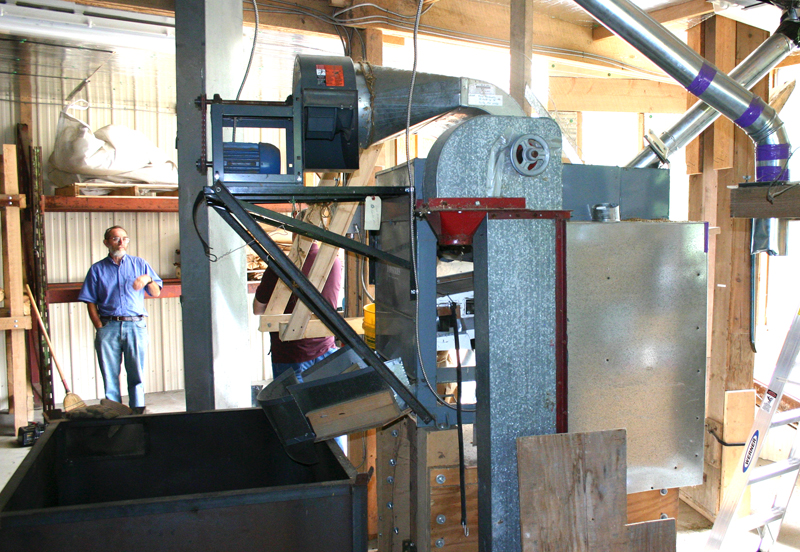
Owner Erick Smith with wheat cleaning equipment at Cayuga Pure Organics
Many of the processes for harvesting, shelling, and cleaning the beans and grains can be handled directly on-farm. Over time, Cayuga Pure Organics has become less dependent on other farmers for the use of processing equipment, streamlining the efficiency of the operation. However, specialized equipment for such tasks can be expensive, and it can be difficult to raise the capital needed to purchase it, house it, and integrate it into the operation. For some time, Cayuga Pure Organics has had plans to purchase equipment to be able to roll oats. Oats are a crop well-suited to our climate in Tompkins County, but they are almost always consumed by humans in the form of rolled oats, also known as oatmeal. Cayuga Pure Organics applied to the NYC Slow Money Group’s first Entrepreneurs Showcase to pitch the idea of investing in this business expansion. They were one of only ten businesses that will be featured in the first Showcase, giving them the opportunity to gain Slow Money investment for this business expansion.
Conclusion
The area between the growing consciousness on the part of consumers that they want to support a more localized food chain on the one hand and farmers who want to grow and provide local foods on the other is ripe with possibility to re-invent investment. While the shape of this emerging movement is not yet clear, the motivations of farmers, food processors, short-haul food transporters, and restaurant chefs are clearly aligned with those of investors with an interest in facilitating a more localized farm and food sector. The roles of regional investors, and the roles of local investors, will be established in part based on who steps forward to help shape the food web through investment and marketing. Perhaps, depending on developments, the Ithaca Hours local currency revival will also play a role. Establishing a farm and food sector in Tompkins County that is able to provide grains, beans, oils, meats, and dairy products to the metropolitan areas of the region as well as the local market seems a relocalizing strategy worthy of the investment of both thought and money.
Postscript from the Farmer: Erick Smith notes some additional benefits and hurdles
Erick Smith of Farmer Ground Flour and Cayuga Pure Organics read an early draft of this article and responded with the following note, which he has kindly given us permission to include here.
The basic products we produce are helping support others in the community. Farmer Ground Flour is one such startup. Another is Wide Awake Bakery in Mecklenburg… Ron Springer in Van Etten is using our grains to produce sprouted products including sprouted gain crackers, sprouted rolled grains, and sprouted breads. Also, Hans Butler, an Ithaca-based chef, is actively developing products from our beans and grains under the name: Cayuga Pure Organics, Chef Hans. He is currently producing the bean dips that are available at Greenstar and is in the process of developing other products. This year we are also growing mustard seed for Mary Graham, a local mustard producer. The point is that Cayuga Pure Organics and Oeschner Farms, as producers of basic organic commodities, provide the basis for other small-scale food processors to create their own products based on our locally-grown commodities.
A major struggle that both CPO and Farmer Ground Flour face is the lack of infrastructure to support what we are trying to do. 100 years ago, operations like ours were scattered across NY State and there was appropriate equipment, repair parts, local expertise, and market structures in place to support these operations. One of our technical and financial challenges is recreating this infrastructure in a modern world where few models are available.
Another major issue we both face is that, compared to conventional farms and conventional flour mills, we are very, very small-scale, yet from the perspective of many of the producers of local produce, we seem large. A major reason is that growing grains and beans and milling flour require a certain level of mechanization that forces certain economies of scale. So the tractors we use are small compared to what would be found on typical crop farms and the 40-year old combines we use for harvest are so small that the size machine we use is no longer even available new. To operate on a smaller scale would make our products prohibitively expensive. Yet, because we are so mechanized, we are very dependent on fossil fuel energy. Farmer Ground depends on electricity and the farms depend on diesel fuel. We know that this has to change and that we face a major challenge in creating that change. Greg is currently actively looking into the prospect of using water power to produce the electricity to run the mill. We currently are using about 10% bio-diesel and would like to use more, but the older diesel engines in our equipment can have problems with higher levels of bio-diesel. So, we know change is coming and may very well, at some point, be looking for ways for the community to support our efforts, both technically and financially. If the Slow-Food and Slow-Money communities are serious about supporting the needed changes for a local-foods economy, these are issues that we all need to be looking at together.
Further reading
Previous TCLocal articles on local aspects of agriculture, food systems, solid fuel (biomass) agriculture, and food processing have included the following:
2008.01.27: Fruits in a Post-Peak Tompkins County [http://tclocal.org/2008/01/fruits_in_a_postpeak_tompkins_1.html]
2008.12.09: Local and Urban Small Livestock and Poultry [http://tclocal.org/2008/12/local_and_urban_small_livestoc.html]
2009.02.25: Food Processing in Tompkins County [http://tclocal.org/2009/02/food_processing_in_tompkins_co.html]
2009.03.28: Examining the potential local foodshed of Tompkins County [http://tclocal.org/2009/03/examining_the_potential_local.html]
2009.06.16: Can New York State Feed Itself? [http://tclocal.org/2009/06/can_new_york_state_feed_itself.html]
2009.07.25: Visioning County Food Production, Part One: Introduction [http://tclocal.org/2009/07/visioning_county_food_producti.html]
2009.09.02: Visioning County Food Production, Part Two: General Problem Areas in Sustainable Agricultural Design [http://tclocal.org/2009/09/visioning_county_food_2.html]
2009.10.15: Burning Transitions [http://tclocal.org/2009/10/burning_transitions.html]
2010.01.20: Heating with Biomass in Tompkins County [http://tclocal.org/2010/01/heating_with_biomass_in_tompki.html]
2010.02.13: Visioning County Food Production, Part Three: Seeing County Food Production as an Integrated Whole [http://tclocal.org/2010/02/visioning_county_food_prod_3.html]
2010.04.26: Funding and Finagling the Transition to Biomass Heat and Power [http://tclocal.org/2010/04/funding_and_finagling_the_tran.html]
2010.05.31: Visioning County Food Production, Part Four: Urban Agriculture [http://tclocal.org/2010/05/visioning_county_food_prod_4.html]
2010.06.20: Visioning County Food Production, Part Five: Peri-urban Agriculture [http://tclocal.org/2010/06/visioning-county-food-prod-5.html]
2010.07.31: Visioning County Food Production, Part Six: Rural Agriculture [http://tclocal.org/2010/07/visioning_county_food_prod_6.htm]
2011.01.18: Health and Food Security [http://tclocal.org/2011/01/health_and_food_security.html]
2011.04.15: Chickens in the Energy Descent [http://tclocal.org/2011/04/chickens_in_the_energy_descent.html]
Notes
[2] http://www.slowmoney.org/book.html
[4] http://www.slowmoney.org/uploads/1/3/6/7/1367341/principles.pdf
[5] http://www.businessweek.com/smallbiz/running_small_business/archives/2009/12/big_ideas_for_2.html
[6] http://www.entrepreneur.com/article/217795
[7] http://www.utne.com/Politics/Utne-Reader-Visionaries-Woody-Tasch-Slow-Money-Alliance.aspx
[8] http://www.time.com/time/business/article/0,8599,1921889,00.html
[9] http://online.wsj.com/article/SB125305092106313571.html
[10] http://articles.latimes.com/2009/sep/22/business/fi-smallbiz22
[11] http://www.alternatives.org/cents.html
[12] http://localfirstithaca.org/
[13] http://www.regionalaccess.net/Home.html
[14] http://www.waterwayscouncil.org/study/public%20study.pdf
[16] http://www.groundswellcenter.org/
[17] http://farmergroundflour.squarespace.com/
[18] http://www.nytimes.com/2010/01/06/dining/06flour.html
[19] http://www.greenstar.coop/index.php?option=com_content&task=view&id=565&Itemid=219
[20] http://www.wideawakebakery.com/
[21] http://www.cporganics.com/live/
[22] http://www.nytimes.com/2010/10/17/magazine/17food-t-000.html
By Tom Shelley
Introduction
Birds and their eggs have been part of our food chain for tens of thousands of years. In hard times, birds and their eggs were survival foods. In the not too distant future, chickens will be a pillar of survival and resiliency as we proceed into what we believe to be a looming energy descent. Chickens are comparatively easy to raise and provide high quality meat and eggs all year round. Some writers prefer ducks,[1] and ducks are an important contributor to the small farm environment, but well-managed chickens are a better fit as an integrated component of a sustainable farming system.[2]
Raising chickens for eggs provides a highly versatile source of protein. Eggs can be stored for a reasonable period of time with relatively little energy input. They may be sold or traded for other goods. In her new book, The Resilient Gardener, Carol Deppe defines five crops you need to “survive and thrive—potatoes, corn, beans, squash and eggs.” This article will consider some of the parameters for raising chickens, explain how these parameters will be affected by the energy descent, explore some alternatives for current practices, and offer many questions still to be answered.
Which came first, the chicken or the egg?
In the energy descent, raising chickens first for eggs and secondarily for meat will be a preferred strategy, for three reasons. First, the nutrients in eggs are denser and more complete than the bird’s meat itself; second, eggs can be stored or preserved fairly easily for future use; and third, eggs have more versatility for food preparation than just the chicken meat itself. Mayonnaise, custards, etc., depend upon the chemistry of the egg to make a unique food product. Roosters, roughly fifty percent of hatchlings, are generally reserved for meat birds, as are hens that are no longer productive.
There are currently 113 breeds of chickens recognized by the American Poultry Association.[3] Many more varieties and strains of chickens are available, and the selection of the appropriate chickens can be a daunting task. Laying hens are selected for their egglaying productivity, length of their productive years, heartiness, body size, egg color, temperament, and other factors. I am familiar with Black Australorps, but Plymouth Rocks, Orpingtons, Rhode Island Reds and a number of other breeds are reliable egg producers. Some aids are available for novice chicken owners to help with breed selection.[4]
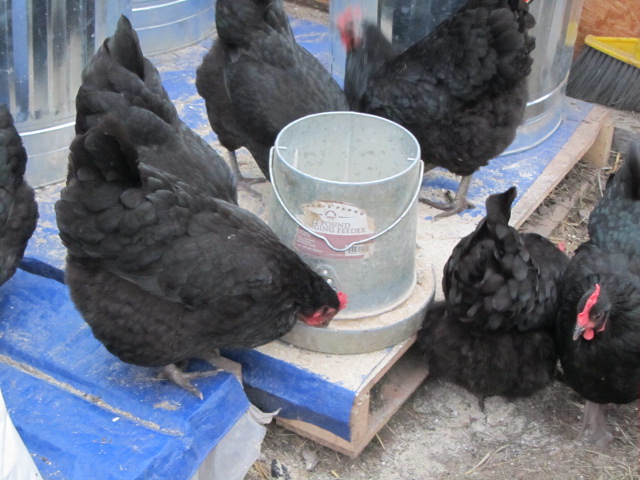
Figure 1. Black Australorps feeding
One distinct advantage of chickens (and many other fowls) is their ability to easily breed and brood eggs to make more laying hens. There are many devices that have been invented to incubate eggs to produce chicks. In the energy descent, especially during times of crisis, it may not be possible to incubate eggs with electrically powered equipment. Since it is fairly easy for chickens to produce and raise their own young, it is strongly advised that all small scale chicken raisers lean how to breed and brood their own chicks to ensure a sustainable supply of laying hens. Several good references for raising chickens from eggs have been published. One highly recommended book is Gail Damerow’s Storey’s Guide to Raising Chickens.[5]
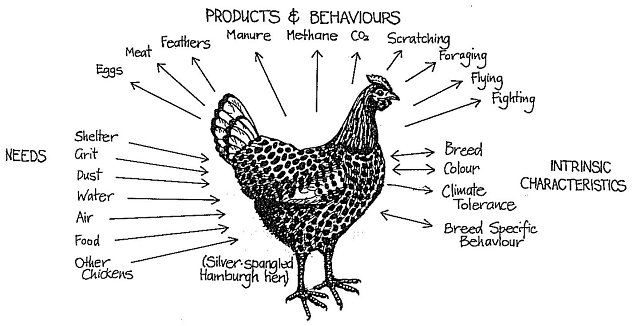
Figure 2. Selecting a breed (from [15])
Day-old chicks are widely available from many sources, local, regional, and national. They are going to be increasingly expensive in the future due to rising transportation costs and newer food security regulations. In a steep energy decline, the traditional regional and national sources may no longer be affordable or even available at all. We will need to depend upon home-brooding or smaller scale, local commercial brooding/incubation of chicks.
Housing options
Many beginning chicken owners have romantic notions of “free-range” chickens. Free-range chickens usually have at least a 50 percent loss rate due to predators. Also, the eggs of free-range chickens can be difficult to gather because they are often laid in hidden, inaccessible places, greatly reducing the useful yield of the flock. If you are dependent upon chickens and their eggs for a subsistence food base, “free-range” is not a good idea.
To maintain high levels of productivity and prevent predation, chickens must be watched over and, at a minimum, contained within a secure fence high enough to keep the chickens in the pen. An electrified fence powered by a small solar panel will prevent almost all small-animal predation. For an example of this type of fencing see [6]. These portable fencing systems, while not inexpensive, allow for frequent relocation of the fence to enable appropriate management of the areas being pastured. Netting the penned-in area may be needed to prevent predation from hawks. Chickens kept in fenced-in enclosures are said to be pasturing or “free-roaming,” but they are not free-ranging.
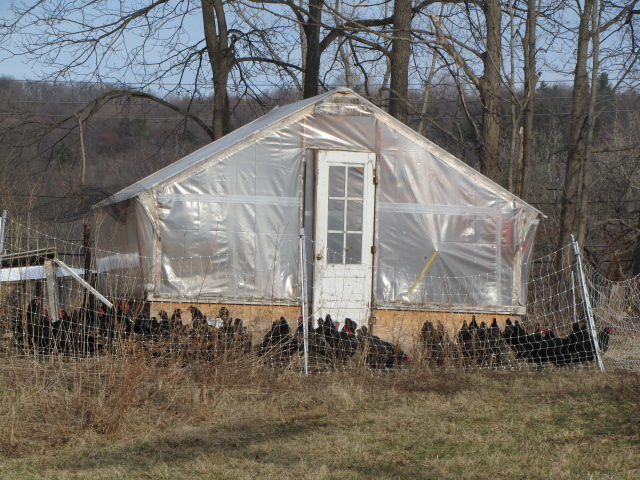
Figure 3. Chickens behind electro-net fencing
The construction and use of a secure chicken coop that is small-mammal proof is strongly recommended. Our chickens roost in their coop and are tightly closed in at night to prevent loss from predation and to provide shelter during bad weather, especially over the winter. Chicken coops can be made from a wide variety of materials, from hundreds of available designs. For examples, see [7].
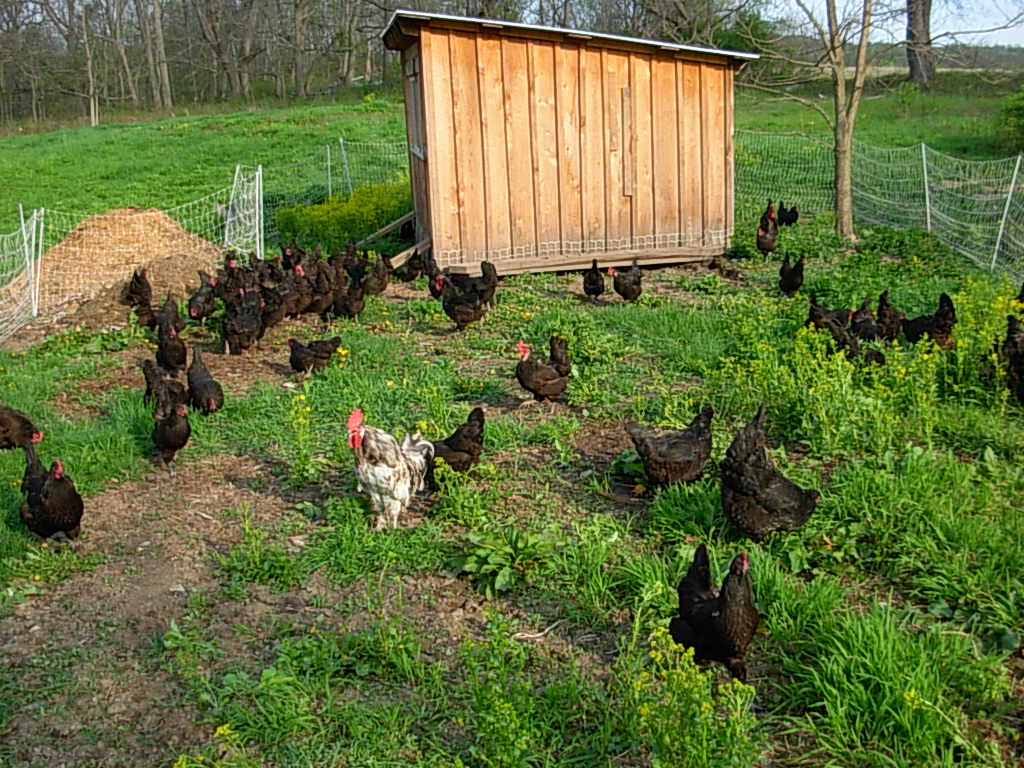
Figure 4. Chicken coop on skids
The use of chicken tractors is also very popular and greatly extends the functionality of having chickens while providing additional protection and security. A chicken tractor is a lightweight, moveable coop. Many designs are available, depending upon your use of the tractor and the number of chickens involved. Chicken Tractor, by Andy Lee and Pat Foreman,[8] gives extensive information on the construction and use of chicken tractors. Chicken tractors can be used to pasture chickens, with the tractor being moved to fresh grass as needed. If tightly constructed and installed, a chicken tractor will provide reasonable security against attacks by small predators. Our chicken tractors are a wood frame covered with chicken wire with a hinged piece of plastic sheet roofing material for a lid. The lid is normally hooked shut when the tractor is in use. Some people use small hoop houses for chicken tractors. You will see a wide variety of chicken tractors at [9].
The best use of the chicken tractor is to prepare an existing garden for planting. Six to ten chickens in one of our chicken tractors will eat everything organic down to the ground over a 4 x 8 foot area in 10 to 14 days, including all sorts of difficult-to-eradicate weeds and grasses. We then loosen up the area with a fork to remove the big roots of last years’ crops and weeds while mixing in the chicken manure and some additional compost. Other techniques are possible, such as working up a new garden plot or feeding specific home-grown crops to chickens.
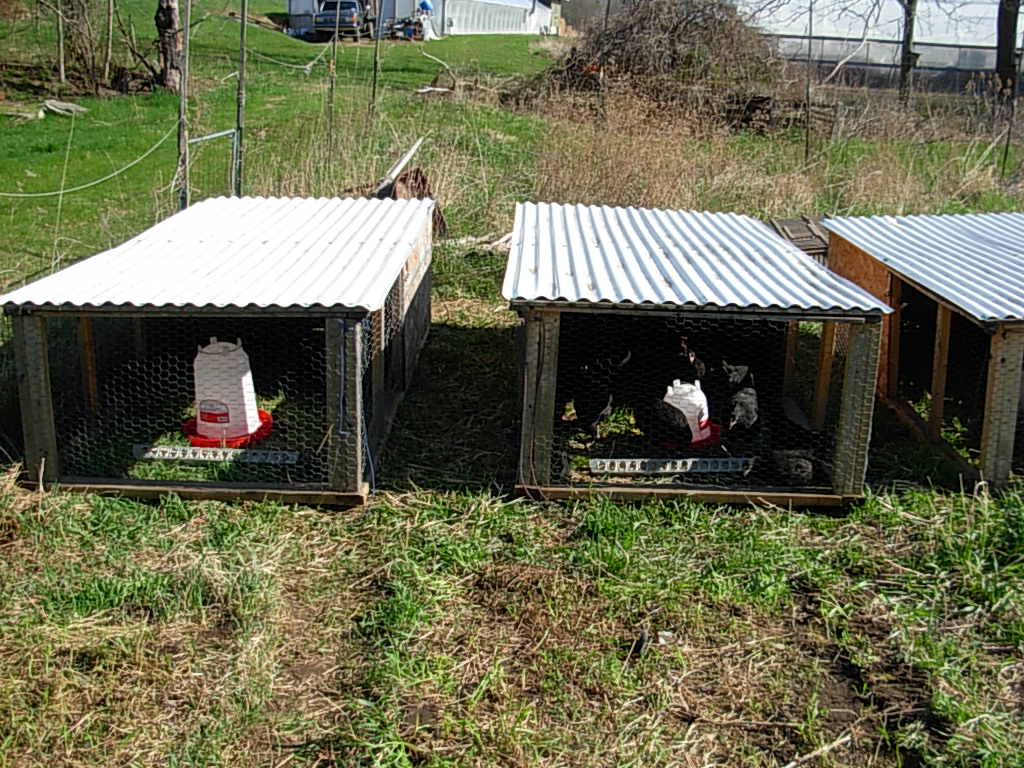
Figure 5. Chicken tractors in the garden
Food and Water
For many small-flock chicken owners, the cost of traditional grain- and soy-based feeds is 70 percent of the cost of the maintenance of their flock.[10] Commercial grain products used in chicken feeds consume vast amounts of fossil fuels in their production, processing, and distribution. Overall, agriculture contributes eight percent of the anthropogenic component of global warming gases. Even a modest rate of energy decline will have disproportional impacts on the cost of laying mash, pushing the price of chicken feed out of the range of feasibility for many small flock owners. This is already happening. A steep rate of decline would mean that nicely milled and amended layer mash in 40-pound bags may no longer be available at all.
Fortunately, for those who can develop a flexible and resilient approach to feeding chickens, many options to currently available commercial chicken feed are available. Chickens will eat almost anything, with some major exceptions (alliums and citrus in particular). If chickens are free-roaming and pastured and given a variety of supplementary foods, they will eat those foods that provide adequate nutrition. Many small flock owners feed mostly kitchen food scraps and some scratch feed (cracked corn or corn/wheat mix) and have healthy chickens and lots of great eggs. Owners of larger flocks cannot supply enough scraps to provide adequate nutrition, so they traditionally resort to commercially available feed mixes.
As the energy decline progresses, access to commercially available layer mash will be increasingly limited for the the small flock owner due to increased costs, limited access to some ingredients commonly used in commercial feed mixes, and other factors (the difficulty manufacturers may have in repairing or replacing equipment, for example). If land is available, many crops can be grown for chicken feed with low technology and few investments. Since chickens will eat everything from amaranth to zucchini,[11] there are many options, depending on the type of soil and the availability of water and nutrients (compost), seeds, labor inputs, etc. Carefully selected crops, most of which are human food crops as well, will allow for adequate nutrition for a flock of chickens over the seasons. Larger flocks are going to require large plots of land, with more grains and seeds to be grown and saved for the winter.[12]
Other local grain and feed options are readily available. For example, I have been purchasing “waste” grain products from Farmer Ground Flour in Trumansburg, New York. I mix supplements with the waste grain products and make a high-grade, organic layer mash. The carbon footprint of my homemade layer mash is significantly less than feed from other regional or national outlets. Other nearby grain mills have sold “seconds” or waste products to local farmers over the years for chickens and other farm animals. I anticipate that feed co-ops will develop to split up the rising costs of the components of feeds. Fish and crab meal, for example, are commonly used feed amendments. Being in the interior of the country, traditional sources of fish meal would be either very expensive or non-existent, depending upon the slope of the energy decline curve. Perhaps a local source of farmed fish for fish meal could be developed?
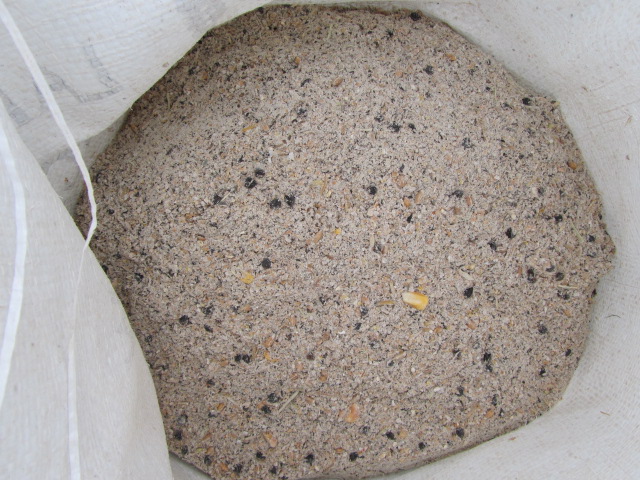
Figure 6. Locally made layer mash
Cooperative efforts to share resources for chicken feed would be very useful. Sharing bigger farming equipment, sharing saved seeds, and trading chicks to maintain diversity are examples. Chickens love milk, yogurt, and other dairy products. Apples, pumpkins, squash, and other fall veggies that store fairly well can be fed over the winter, providing diversity when pasture isn’t available. Waste vegetables from nearby farm stands can often be gleaned in the summer and fall, and they add value to the nutrient intake of your flock. Chickens love hay in the winter, and we have very local sources of organic alfalfa hay. Duckweed, which commonly grows on local ponds, is a highly nutritious chicken food (see the TCLocal article “Visioning County Food Production, Part 6” for more about duckweed in sustainable food production). Sprouted grains provide grass in the winter; I use oat grass, because oats are very inexpensive and germinate readily.
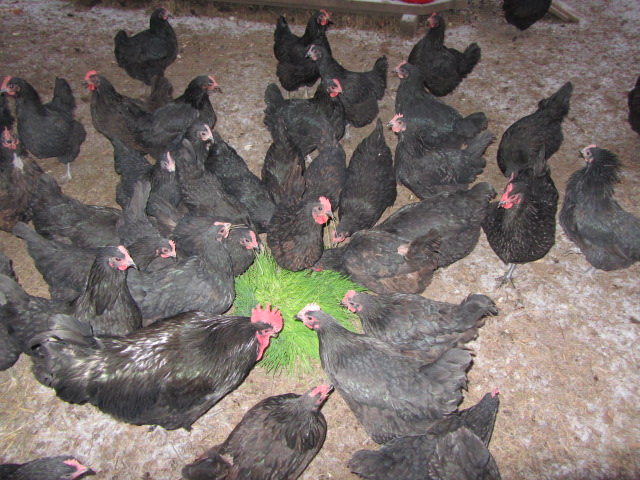
Figure 7. Chickens eating oat grass
Other options include feeding chickens active compost or certain insect larvae. Active compost has a high percentage of insects and other high-protein sources perfect for chickens. Some chicken farmers raise meal worms or black soldier fly larvae as chicken feed.[13] These techniques can significantly reduce the consumption and dependence upon grain-based feeds and their high fossil fuel inputs and large carbon footprint.
Chickens need a lot of water. Laying hens use up to two cups of water per day and even more in hot weather.[14] Water requirements are often higher in winter, when humidity is low and feeds and grasses are dry (hay, alfalfa cubes). The chickens’ water needs to be clean, potable water from a reliable source. Springs, wells, and urban water sources are all commonly used. In the early stages of energy decline, most of these sources will remain stable, although spare parts for pumps and wells may be hard to obtain at times. In a steep energy decline, energy sources and systems (delivery of public water supplies) will be disrupted or non-existent, parts will be impossible to obtain, and only secure natural sources (uncontaminated springs or wells) will allow for good quality water. Alternatives need to be developed. Clean rainwater catchment on a scale to water a modest flock is possible for most chicken owners.[15] The catchment and storage systems would need to be in place and functional when needed. Chickens can also drink from a clean stream or pond if one is available. Contamination from agricultural runoff, especially if you are raising organic chickens, and from animal wastes is of serious concern when using a stream or pond as a water source.
Other requirements for chickens are oyster shell and grit. Layer hens have a high calcium uptake, and the general recommendation, based on information from Lakeview Organic Grain, is 127 pounds of crushed oyster shell per ton of feed. The grit, needed to grind food internally, is most frequently sold as ground granite. Grit is free-fed; in a free-range or free-roaming situation most chickens will find all of the grit they need outside. Grit is most often fed in winter, when snow cover and frozen ground prevent normal foraging. Oyster shell will be more problematic, especially in a steep energy decline, and alternative materials and sources need to be found. Ground up egg shells provide one option, but this is a limited source.
Flock management
Many management issues will be affected by energy descent. Moving a coop from pasture to pasture is easy if you have an appropriately sized tractor and the fuel to run the tractor. If not, do you have a neighbor who owns a horse who will help you every two weeks or so? Some may elect to have their own horse; perhaps several nearby farms could share a horse and the expense of maintaining the horse. Building a coop with wheels would facilitate movement, perhaps only requiring a few strong people.
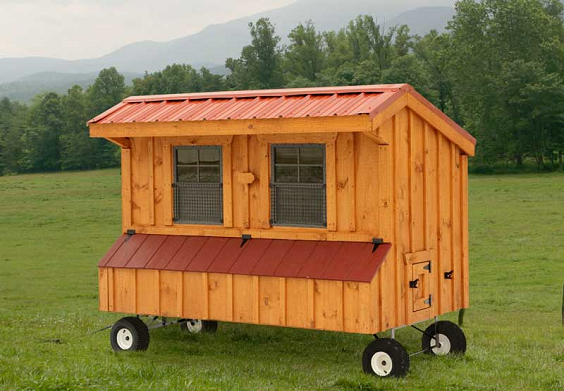
Figure 8. Coop on wheels
As the energy descent progresses and liquid fuels become more expensive, different business models will quickly evolve. We now deliver most of our eggs to our CSA customers. Perhaps there could be a central pickup point arranged for several customers in one area so as to save on fuel costs. Feed co-ops will develop to split up the rising costs of the components of feeds. Joint ownership of expensive equipment will enable a number of farms to thrive.
As eggs become an increasingly valuable component of our diets, food security issues become more important. There are well-established protocols for the handing of birds and eggs that reduce the possibility of contamination and disease transmission.[16] This is an area that is often poorly understood by small-flock owners.
Keeping chickens cool in summer and warm in winter is important. The use of solar heating and solar PV for other equipment will become increasingly important. If global warming increases at the rates projected, it may be necessary to change the breeds or varieties of chickens and other fowl to those that tolerate heat better than traditional breeds.
Attention to manure management will be especially important. Chicken manure is very rich in nitrogen and other nutrients. It may be composted or mixed directly into the soil. The appropriate rotation of fertilized pastured areas, gardens, and grain plots can maximize the inputs of chickens to the nutrient cycle. In a steep energy descent, most or all of our resources will come from the farm itself.
The management of breeding stock, the culling of poor producers, and other hands-on management issues will need to be addressed to maximize the long-term success of the flock. Health issues will may be more of an issue, especially in a steep energy descent. Our chicks come from Missouri, arriving with vaccinations for several diseases. Where would these vaccinations come from in the future? Very few vets know about chickens. Last year New York State defunded the state veterinarian position that has served the poultry industry in New York for several decades, so there is only thin support of flock health available going into the near future. How are we going to learn to be our own vets as far as our flock health is concerned? There are many challenges ahead.
Conclusion
Readers of this article may not live to see the hard times ahead, but their grandchildren certainly will. Chickens and other fowl will be an integral component of a resilient community as we enter an uncertain future.
References
[1] Deppe, Carol. The Resilient Gardener. Chelsea Green Publishing, 2010, p. 178.
[2] See the TCLocal series of articles on local food production by Karl North, beginning with “Visioning County Food Production—Part One: Introduction” (http://tclocal.org/2009/07/visioning_county_food_producti.html).
[3] See, for example, http://139.78.104.1/breeds/poultry/, from Oklahoma State University.
[4] See, for example, http://www.mypetchicken.com/chicken-breeds/which-breed-is-right-for-me.aspx.
[5] Damerow, Gail. Storey’s Guide to Raising Chickens. Storey Publishing, 1995. For additional general information see http://www.backyardchickens.com/lcenter.html and http://www.lionsgrip.com/pastured.html; Small-scale Poultry Keeping by Ray Feltwell (Faber and Faber, 1992); and the periodical Backyard Poultry (http://www.backyardpoultrymag.com).
[6] http://www.premier1supplies.com/c/poultry_supplies/electric_netting/
[7] http://www.freewoodworkingplan.com/index.php?cat=212. Sometimes the home page works better: http://freewoodworkingplan.com/.
[8] Good Earth Publications, 2006.
[9] http://home.centurytel.net/thecitychicken/tractors.html
[10] Storey’s Guide to Raising Chickens, p. 53.
[11] For example, http://steephollowfarm.wordpress.com/2009/06/18/chickens-like-a-lot-of-things/. See “Local Notes on Chicken Feed” (http://tclocal.org/docs/chicken-feed.pdf) for some ideas about local possibilities.
[12] See Logsdon, Gene, Small-Scale Grain Raising (Chelsea Green Publishing, 2009).
[13] See http://www.sialis.org/raisingmealworms.htm#timetable and http://blacksoldierflyblog.com/.
[14] Storey’s Guide to Raising Chickens, p. 60.
[15] See, for example, Mollison, Bill, Permaculture—A Designers’ Manual, 2nd ed. (Tagari Publications, 2004), pp. 165-170. A detailed overview of rainwater catchment techniques developed in third-world countries can be found in Gould, John and Erik Nissen-Petersen, Rainwater Catchment Systems for Domestic Supply (ITDG Publishing, 1999).
[16] http://www.eggsafety.org/producers/food-safety-regulations
By Bethany Schroeder
Introduction
To many people, health is largely a matter of perspective. In the main, we subscribe to a working definition that includes feeling physically good; able to act and react according to some semblance of a reasonable self image; remaining fit in a passable manner; and weighing in at something near the insurance industry’s norms.
Food security is another matter: some people describe food security as little more than being assured of the next meal, whereas others are unsatisfied with anything less than pantries full of canned and dried goods and well-stocked freezers. Members of disciplines as disparate as nutrition, planning and development, medicine, social justice law, and the armed services have considered the meaning and uses of the term with a view to overcoming the implied warning in its terminology.
Both health and food security are fraught with expectations at social, academic, and governmental/regulatory levels. Both are states of mind as well as physical conditions. Absent either, the human organism eventually dies. In short, health and food security are necessary to life—all life, and in the case of the present examination of the terms, most pointedly to human life. Health and food security are worth consideration because they are basic to life and because they have at all times in specific contexts existed in some imbalance. In general, when it comes to health and food security we expect much and plan all too little.
The author, in search of food security
Food security versus food insecurity
Depending on the audience, experts have defined food security in formal and informal ways. In 1996, participants at the World Food Summit identified the presence of food security as in effect “when all people at all times have access to sufficient, safe, nutritious food to maintain a healthy and active life.”[1] Participants also emphasized the combined requirements of being able to find and afford both nutritious food and food that meets an individual’s preferences.[2] According to the Bureau of Public Affairs, it is thought across the globe that, quite simply, people are food secure when they can find and pay for food. Under this rubric, families are food secure when the members neither experience hunger nor fear starvation.[3] Furthermore, people with ethnic traditions and socio-religious mandates require that food be culturally appropriate. Many will refuse foods—even when hungry, even when in the midst of a food shortage—that fail to meet their expectations.[1] At least one local source, the Community Food Security Coalition, maintains that “community food security is a condition in which all community residents obtain a safe, culturally acceptable, nutritionally adequate diet through a sustainable food system that maximizes community self-reliance and social justice.”[4]
Regarding the relationship between health status and food security, it may be sufficient to define good health as the ability to withstand the effects of exposure to illness and injury. The connection between nutritious food and health status is, from this perspective, fundamental, whether or not innate. Leaving aside the question of how to educate people to make healthy and nutritious choices, assuring access and affordability becomes a matter of public policy and the generous application of social support.
Also worth noting is the counter-intuitive notion of wide-spread hunger and food insecurity in the presence of abundance.[5] Inequalities in distribution combined with general and pervasive poverty and a lack of knowledge about food preferences and prohibitions can result in food insecurity so endemic that neither individuals nor communities can overcome barriers to supply and access adequate to mitigate the problem.
In the past couple of decades, the terms and circumstances of food insecurity have been the subjects of increasing scrutiny. Citing 1990 research findings, the USDA describes food insecurity as “. . . limited or uncertain availability of nutritionally adequate and safe foods or limited or uncertain ability to acquire acceptable foods in socially acceptable ways.”[5] What is more, the conditions associated with food insecurity are just those that we expect will result from declines in the availability of energy and the subsequent threats to the status of human health.
Hunger, food insecurity, and the effects on health
Until recently, the absence or presence of hunger was the primary measurement by which many experts assessed food security as it applies to an individual’s well-being. Without minimizing the significance of hunger, researchers recognized that hunger in a household might be an inconsistent problem and might apply primarily to one or more persons without being true of the entire household. Wanting to understand the role of hunger as it relates to food insecurity, researchers and policy makers began to think about food security or insecurity in the larger context of the community and the availability of food in general. Questions that routinely arose included the following:
- What are the circumstances of hunger in a household?
- Who, in a household, experiences hunger, and why?
- What are the effects of hunger in a household?
- What is required to relieve hunger, both temporarily and permanently?
Such inquiries found that hunger is typically the result of inadequate resources to obtain food but can exist when food choices are limited, too. Hunger often affects select adults who may ration food for more vulnerable members of the household. In the presence of food insecurity, hunger can affect everyone, especially the very young and the very old. Effects can include periodic hunger and the potential to develop food insecurity, if a lack of resources to acquire food or the unavailability of food is the cause of hunger. To achieve short- and long-term improvements in relieving routine or chronic hunger accompanied by food insecurity requires that planners, leaders, farmers and other food producers, just to name a few invested parties, develop a systemic understanding of the problem.
As a result of this and associated research, the USDA in particular altered its use of terms related to hunger and food insecurity, and has continued to look for refinements in ways of categorizing and addressing both phenomena. Germaine to this TCLocal article is the realization by USDA and others that the understanding of hunger deriving from food insecurity “. . . results in discomfort, illness, weakness, or pain that goes beyond the usual uneasy sensation [of hunger].”[5] Especially during the past two decades of discussion and investigation, policy makers and those responsible for conducting research and the instruction of the next generation of field and university researchers and educators have come to appreciate the connection between food insecurity and the conditions, manifestations, and ramifications of ill health. Among other things, the implication is that hunger, in addition to being a symptom of food insecurity, is also a part of the panoply of conditions that signal compromised health status.
Undernourishment and malnutrition are two conditions widely agreed to be the results of hunger and food insecurity. Among children, conditions that can coincide with the latter include weight loss, fatigue, stunting of growth, and frequent colds. Studies have shown that undernourished pregnant women are more likely to bear babies with low birth weight, and the babies are then more likely to experience developmental delays that can lead to learning problems.[6]
Iron deficiency anemia is also common among hungry and food insecure children on one end of the spectrum and older adults on the other. In children, the condition can cause delays in development and learning. Children with iron deficiency anemia are also more susceptible to the effects of lead poisoning. In people of every age group, iron deficiency anemia can cause fatigue, weakness, shortness of breath, and irregular heart rhythms, among other symptoms.[6]
Moreover, hunger and food insecurity worsen the effects of all diseases and can accelerate degenerative conditions, especially among the elderly. Hunger and food insecurity create psychological responses such as anxiety, hostility, and negative perceptions of self-worth.[6] In an energy- and resource-constrained world, diseases like malaria, HIV/AIDS, dengue fever, and other infectious conditions from distant places, which experts anticipate will migrate in reaction to changes in weather patterns, can be expected to become more prevalent. More frequent incidents of these and other opportunistic diseases are likely to be reported, resulting in the potential to overburden the ability of any medical or public health system that tries to address the problem(s).[7]
Local considerations in combating hunger and food insecurity
In an energy-constrained future, such as TCLocal envisions in the next 10 to 20 years[8], food insecurity and its consequences are expected to be increasingly common. The combined pressures of a larger population, climate change, reduction in the adjuvant energy required to grow food as well as the increased cost of such energy, and the potential for reduced or altered water resources could all create the environmental circumstances that lead to food insecurity. In fact, simply based on a growing population with the means to purchase choice foods, the demand for food could increase by as much as 50 percent by 2030. On the other hand, researchers speculate that increased demand and falling productivity could create widespread hunger and food insecurity, especially in the poorest communities of the world. All over the world, taking a preventive approach to food insecurity will require that we improve agricultural productivity and make access to markets easier.[9]
The outlook for our region is likely to be similar to that of the rest of the Northern Hemisphere, if not the world. The good news is that many of the residents of Tompkins County have developed an appreciation for the need to husband resources, as well as some of the skills to be effective at the practice. Locally, educators in well-established and informal venues alike have focused on the connection between promoting food security in combination with supporting good health, underscoring that each facilitates the other.
Assessing food security on a local level at this juncture with a view to predicting the potential for future changes will allow for planning and intervention. For example, according to 2009 statistics regarding the perception of hunger in Tompkins County, people across all income levels reported that the problem was widely evident. Twenty-three percent of respondents in the county’s COMPASS survey said that having enough money to buy food was a problem in their own households. The use of local food pantries increased 30 percent between 2003 and 2008. Food stamp use also increased during the same period, with 4,223 households reporting participation in this subsidized food program in 2008 versus 2,288 households participating in 2003. Between 2001 and 2007, increases in reduced-fee or free lunches were noted among school children, with a quarter or more of all students in Groton, Dryden, Ithaca, and Newfield receiving support in the purchase of their meals.[10] Thus even in Tompkins County, where the standard of living is widely thought to be above average, a notable number of households experience hunger and food insecurity.
Though more can be accomplished, much is being done to address the problems associated with declines in health and food security. The services of agencies like the Department of Social Services, Catholic Charities, TC Action, the Red Cross, FoodNet, and others directly address local problems and enjoy an overall reputation for effectiveness. At the same time, the notable array of local Community Supported Agriculture seasonal options, the variety of U-pick and share farms in our area, the small and large market gardens, and the many agencies and local programs that educate people about how to use and preserve food have increased the general awareness of the need to address food security in Tompkins County.
A short list of local access-oriented programs includes emergency food services through Loaves & Fishes and the Salvation Army; the United Way’s Food Pantry Garden in Brooktondale; the school district’s Fresh Food and Vegetable program, which serves elementary age children; and assistance to childcare providers, parents, and pregnant teens through the Child Development Council, just to name a few. The Human Services Coalition’s Information and Referral program and 2-1-1 Connect have also been helpful in directing people to much needed resources, including food resources.[10] Web-based support is available through the Community Cooperative Extension and the locally developed websites of Prepared Tompkins, IthaCan, and Harvestation. As is true in many communities across the U.S., in Tompkins County the internet has the capacity to connect people with resources by way of specific mail lists that promote local activities and community solutions to many problems, including hunger, food insecurity, and the consequences for health.
Increasing awareness of the existence of or potential for hunger among our neighbors and friends has spurred local efforts to find immediate relief. Although considered an unsanctioned method of food collection in some parts of the Western world, gleaning is not uncommon in communities across the U.S. In this region, grassroots efforts to serve and protect the poor among us have been responsible for large local gleaning projects, frequently announced on the mailing lists of Sustainable Tompkins and the Finger Lakes Permaculture Institute, among others.
Local food security is also promoted by community gardens, where area residents not only grow food for their tables but practice prevention and health promotion in the act of working outside. Many local groups, including TCLocal, the Level Green Institute, and Sustainable Tompkins, have called for the development of this readily available solution to the problem.
Local options for enhancing health and food security
At an evening meeting of farmers and others interested in issues related to local food production, one of the farmers responded to the question, “Can the farmers in Tompkins County feed the population here?” with, “No. We can probably provide just 20 percent of the needs of the local community.” Important in this anecdote is 1) the farmer’s frank assessment and 2) that the question arose just four years ago.
Others have asked whether New York State can feed itself[11]. Indeed, in a time of energy descent, when fewer resources are available to grow and transport food, the potential for growing food closer to home, as well as recruiting and supporting local growers, may be among the most important questions to ask. In addition to assessing how much food production is possible locally, planners, growers, and area residents should consider the ways in which each might contribute to the solution rather than merely being part of the problem.
For starters, every yard and container has the capacity to be a food garden of one kind or another. Today the activity might primarily focus on cultivating the skills to grow food, whereas future circumstances may require skills honed to fill the table and the larder. Spending time outside in the garden encourages bone density through the absorption of vitamins. It also helps to build muscles and to keep the body fit and healthy. While not everyone likes to work in the garden, most of us like to eat. Learning to think about food production as a civic responsibility has historical contexts all over the world, as much in Tompkins County as anywhere else.
Legislators at all levels of government could help more of us to be producers rather than only consumers of food. Suspending or discontinuing ordinances that restrict farming, gardening, and tree-crop production could encourage more participation in the food economy, most likely at the informal level. Whether considering food for sale, barter, or personal consumption, reducing the unnecessary barriers to food production that inhibit growers is the first step in ensuring that everyone has enough to eat. Rethinking area ordinances about the management of food and food systems will be necessary to enhancing health and food security in an energy-constrained world. Considerations of what constitutes agricultural land, who can hold it, and how it’s taxed should be topics of discussion at county, town, and city levels of local government.
In general, Tompkins County has an abundance of fertile, versatile land and adequate water supplies to promote the growth of every manner of food that can be produced in this climate. Increasingly significant in the study of agricultural techniques are nutritional outcomes, depending on the quality of soil and its augmentation. Despite many studies and much debate, the jury remains undecided about the relative value of organic versus conventional methods of soil management for the sake of healthy nutritional impacts.[12] Nonetheless, researchers do agree that organic methods produce less environmental stress. At the very least, the absence of additives, typically derived from natural gas, commends organic techniques to the small farmer or gardener in circumstances of energy descent. No matter which methods we use to grow food, we must thoughtfully manage the short- and long-term integrity of the soil if we want to help retain its best characteristics year after year.
So too must we be careful stewards of the region’s ponds, creeks, and lakes. At the local level, the protection of all water resources is a matter directly related to health and food security. The public health department oversees the potability of water, relying on standards set at state and federal levels. Common sense and a basic understanding of interdependencies are enough to show that poor management of our water will affect whether we can grow adequate food, not to mention whether water supplies are safe for our consumption and for consumption by livestock.
Animal husbandry includes the allocation of important food resources, but the practice is presently defined and permitted according to economic standards that we, under circumstances of reduced access to energy, cannot hope to sustain. Owning a cow or a flock of chickens, for example, may not be necessary to every family, yet the availability of milk and eggs locally sold (or shared) and produced might well come to be viewed as a necessary feature of community life.
At the same time, assuring that those who work to grow food, whether formally or informally, have access to hygienic resources makes good sense from the perspectives of safeguarding the talent and skill necessary to effective farming and gardening and to the quality of our food at its source. People need bathrooms and sinks or other hand washing options, especially options that don’t contribute more trash to already overburdened landfills or the use of supplies made from oil or natural gas. We could make facilities more widely available near gardens and farms, and we could manage them locally.
Discussions at NOFA conferences and other similar meetings are reportedly well attended, exhibiting the kind of regional knowledge and sensitivity to local issues that supports asking important questions about food issues and promotes success in approaches to planning that address those issues. In particular, food policy councils, frequently made up of interested professionals, community members, farmers, vendors, and legislators, have proven to be useful in some communities in helping to organize the selection, production, and distribution of food.[12] As noted earlier in this article, a loose coalition of food experts and community organizers in Tompkins County has lately convened to discuss the possibility of an area food council. Among others, issues explored included, first, the activities helpful to improving the local food system via a food policy council, and second, the necessary resources and commitment needed for success.
In this article, I have described just a few considerations related to health and food security. I hope that others will follow up my work with a deeper and more expert examination of the issues. In addition to adhering to the principles that guide TCLocal in its goal of understanding how residents might operate with fewer resources and more sustainable approaches to development, I recommend that we examine first principles of fair access, fair use, and fair expectations regarding health and food security. A healthy, integrated, and self-aware community must learn how to share resources, recognizing that the whole is only as strong as its weakest part.
References
[1] http://www.who.int/trade/glossary/story028/en/.
[2] Nutritional research has shown that social, religious, and personal food preferences play a significant role in maintaining appetite, ultimately influencing the quality of an individual’s diet.
[3] http://www.state.gov/s/globalfoodsecurity/129952.htm#.
[4] http://groundswell-ithaca.blogspot.com/2010/12/working-toward-food-security-in-ithaca.html.
[5] http://www.ers.usda.gov/Briefing/Food Security/measurement.htm.
[6] http://www.frac.org/html/hunger_in_the_us/health.html.
[7] Bissell, R., Bumbak, A., Levy, M., & Echebi, P. (2009). Long-term global threat assessment: challenging new roles for emergency managers. Journal of Emergency Management, Vol 7, No. 1, pp. 19-37.
[8] http://tclocal.org/2010/10/outlook_for_liquid_fuels.html.
[10] http://uwtc.org/compass-ii-20-social-issues-key-findings.
[11] http://tclocal.org/2009/06/can_new_york_state_feed_itself.html.
[12] http://www.foodsecurity.org/FPC/council.html. One of the best Websites I found while completing the background reading for this article, the site is rich in subjects that range from agronomy to wildcrafting, from vitamin deficiencies to nutritional variances among indigenous peoples.
by Jon Bosak
As our regular readers know, we here at TCLocal are engaged in a long-term effort to help develop local responses to energy descent—the condition of decreasingly available energy. The near-term manifestation of energy descent is high liquid fuel prices caused by a leveling and decline in global oil production, and it has been part of our job over the five years since we started TCLocal to keep an eye on the liquid fuel outlook and periodically advise the residents of Tompkins County (in particular, local policy makers) on what we’re finding.
In September, five of us TCLocal contributors had the honor of presenting a panel discussion on “Local Responses to Energy Descent” at the monthly meeting of Back to Democracy in Trumansburg. The audience heard from Katie Quinn-Jacobs on Preparedness; Karl North on Food Production; Bethany Schroeder on Health Care; and Tom Shelley on Energy. Articles by all of these authors can be found elsewhere on the TCLocal.org web site (see the list at the end of this article). It was my job to introduce these responses to energy descent with a quick summary of the outlook for liquid fuels. A version of that introductory presentation serves as our TCLocal article for the months of September and October.
The overview that follows was based on a fresh analysis of the current situation conducted over the summer by a team consisting of myself, Bethany Schroeder, Karl North, and Tom Shelley. Not every detail will be agreed upon by every TCLocal contributor or even by every member of the research team, but it does represent in a general way a shared view of the outlook for liquid fuels over the next decade. Illustrations drawn from the Web are credited where the source is known and are reproduced here under the Fair Use provisions of copyright law.
The Lesson of Deepwater Horizon
Predicting the price of oil is an extraordinarily difficult task even for petroleum experts, which we are not, and the effect of the economic downturn on the oil business has made reliable forecasting almost impossible for the last couple of years. But this summer, one thing, at least, became very clear: the easy oil is gone. That’s not a future development; it’s already here.
U.S. Coast Guard
No one pursues a course as risky, dangerous, and expensive as drilling four miles down into the Gulf of Mexico unless all the easier stuff is no longer available. It doesn’t take a degree in petroleum engineering to see this.
It is enlightening to understand some basic facts about oil extraction, though, so if you’d like to know more about that, click here. You’ll be returned back to this place when you’re done.
Here’s a recently published official view of the future from the U.S. Department of Energy’s Energy Information Agency (EIA).
The top line in this remarkable graph is world demand for liquid fuels. Over the long term it always increases steadily due to population growth, if nothing else.
The colored areas show the global sources of liquid fuels, taking into account all currently known projects. As the graph makes clear, existing sources of conventional oil are already in steep decline, and unconventional sources can’t keep up with that decline. The result is a growing gap between supply and demand beginning not long after 2012.
In the petroleum world, this has never happened before. Up until now, there has always been enough liquid fuel to meet demand, because it could be pumped out as fast as people had a use for it. A widening gap between supply and demand will eventually have an upward effect on prices beyond anything seen so far.
The label “Unidentified Projects” in the illustration acknowledges that no one really knows what sources can fill this widening gap between supply and demand. It is certain that no combination of currently foreseeable efforts can make up for the rate of decline in conventional oil production, and any new projects are certain to be much more expensive than those of the past.
Red Herrings and Dead Ends
At this point, most readers will be thinking of their favorite solution to the energy problem. But within the ten-year period that we’re discussing here, there is no solution. No current proposal will avert a near-term future of decreasingly less available liquid fuel.
This conclusion may come as a shock to anyone who’s put their faith in technological fixes. We seem to have so many promising solutions to choose from; you’d think the problem was just getting them implemented. There certainly is a lot we could be doing that we aren’t, but on examination it turns out that the proposed technological solutions to the coming oil crunch are at best wishful thinking and at worst border on the fraudulent.
A prime example of this latter category is the idea that we will replace current vehicles with ones fueled by hydrogen. The fact is that hydrogen is not a source of energy, it’s just a way of storing energy, like batteries. And if we had the extra energy to store, we could distribute it much more easily by building out the existing electric grid—and much more efficiently, too. As shown here, the pure electric approach delivers three times the power to the road from a given input of electricity than the hydrogen-based approach.
Bossel, Proceedings of the IEEE
Remember GM’s relentless promotion of hydrogen cars? The last serious publicity the company put into this was in 2006. It’s now obvious that this was all just a PR campaign designed to reassure consumers that GM was working toward a transition away from fossil fuels. That role is now being played by electric cars. This is an improvement, but unfortunately not a solution.
The proposal to solve the liquid fuels problem by transitioning to electricity is one of a large class of putative solutions that make some technical sense but just don’t comprehend the scale of the problem. It’s clear that widespread conversion to electric vehicles will require some kind of addition to our generating capacity, but few people appreciate the size of the change. The fact is that most people have no idea how much energy we’re consuming to move as many vehicles around as we do.
Let’s do a little back-of-the-envelope calculation here. According to the EIA, total U.S. petroleum consumption in 2007 was 20,680,000 barrels per day, and 70 percent of it went to transportation. A barrel of oil represents 1700 kWh of energy. Do the arithmetic and you’ll find that transportation in the U.S. uses about 9.0 billion MWh/year of energy from petroleum. By comparison, according to the EIA, total U.S. electrical output in 2007 was about 4.2 billion MWh. In other words, the amount of energy represented by the fuel we’re using in vehicles is more than twice as much as the total amount of energy represented by the electricity we’re producing each year. Speaking very roughly, therefore, a proposal to replace half of our vehicle fleet with electric versions amounts to a proposal to double the size of our entire electric generating and distribution system, which includes doubling the amount of fuel consumed (chiefly coal). It is safe to assume that we will not see this happening in the next ten years, if ever.
Proposals that rely on solar, wind, or nuclear to provide the missing electricity demonstrate a similar failure to understand the scale of the problem. The following diagram illustrates this point.
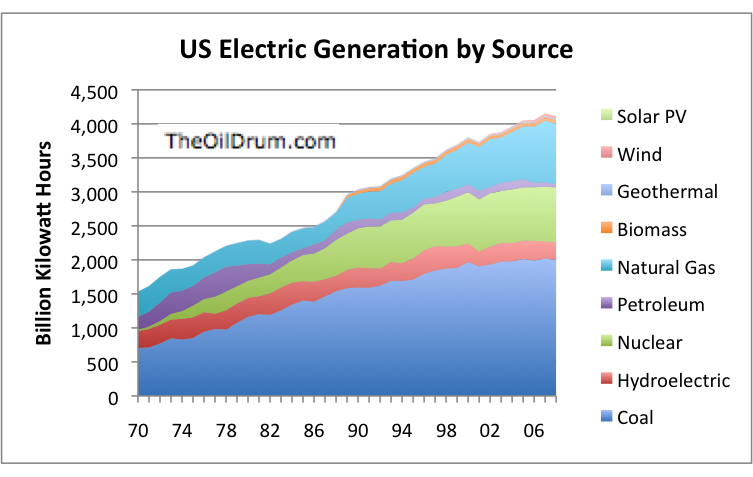
Count off the sources by working up from the bottom of the graph and you’ll begin to understand what a tiny proportion of our electrical generating capacity is due to wind, solar, and biomass; their contribution is barely visible. Electricity from nuclear is much greater, of course, but the cost and planning horizon of nuclear projects means that any sizable expansion of nuclear capacity would lie many years in the future. Aside from the inability of these sources provide liquid fuel, no believable expansion scenario envisions any combination of them being able to fill more than a fraction of the energy gap that’s opening up due to the decline of conventional oil.
A third class of solutions would actually solve the liquid fuel problem, but only for a little while, and at an enormous cost in other resources. Hydrofracking for natural gas in our local Marcellus shale is an example of this category of solutions: we get a temporary shot of fossil fuel at the cost of our farms and our drinking water, and at the end of the process we're left back where we started but with permanent damage to our environment.
Another technology in this category is oil from “tar sands” and “oil shales,” production of which uses phenomenally large amounts of water and is even more destructive to the environment than hydrofracking.
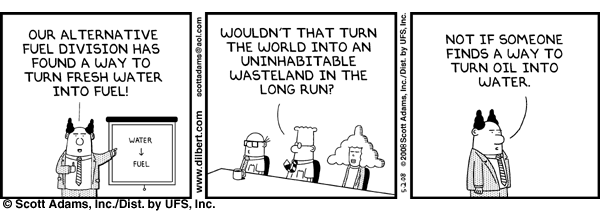
Tar sands are also representative of a class of good-looking production technologies that don’t yield significantly more energy than they use but simply substitute one source of energy for another, in this case, massive amounts of natural gas to heat the “tar” (bitumen). Another example of an energy “source” that doesn’t actually deliver significantly more energy than it consumes is liquid fuel from biomass, such as ethanol from corn.
To sum up, then: some of these alternatives—in particular, the development of solar and wind power—really are worth pursuing, but none of the current proposals can change the history of the next decade or so, either because they are not solutions at all or because it is physically impossible to increase production from alternative sources quickly enough to have a meaningful impact in that period of time. The only thing that could change the basic reality would be a massive, all-out effort to replace liquid fuels with substitutes from coal or natural gas.
Large-scale production of liquid fuels from coal has only been accomplished twice in history, once by the Nazi government in Germany and once by the apartheid regime in South Africa; the synthetic fuel is of excellent quality, but the technology is brutally expensive and therefore instituted only as a last resort. And of course large-scale coal-to-liquids would just delay the inflection point without really changing anything, because coal and natural gas are themselves finite resources that are closer to their own peaks than most people realize.
Coal-to-liquids shares one more flaw with most of the other proposed solutions: we’re out of time. A 2005 study commissioned by the U.S. Department of Energy concluded that widespread disruption to our economic system from peak oil could be averted by nothing less than a WW2-level national mobilization effort to implement coal-to-liquids starting at least a decade ahead of the peak—and we don’t have that kind of time left.
Timing the Gap
The inevitability of a coming liquid fuel price crisis caused by failure of oil production to meet increasing demand is much easier to establish than the precise timing of that crisis. But this year several independent studies have arrived from different directions at approximately the same conclusion.
In “The Status of Conventional World Oil Reserves,” published recently in the journal Energy Policy, researchers Owen, Interwildi, and King conducted an in-depth survey of all currently available information regarding oil production and petroleum reserves, with special attention to the reliability of reporting in the OPEC countries. Their conclusion:
Supply and demand is likely to diverge between 2010 and 2015, unless demand falls in parallel with supply constrained induced recession.
Note the “unless”; we’ll return to that shortly.
In the article “Forecasting World Crude Oil Production Using Multicyclic Hubbert Model,” published last April in Energy & Fuels 2010, a team from Kuwait University (Nashawi, Malallah, and Al-Bisharah) performed an in-depth mathematical analysis of the 47 leading oil-producing countries. While based on a methodology completely different from that used by Interwildi et al., their findings are strikingly similar:
World oil reserves are being depleted at an annual rate of 2.1%.... World production is estimated to peak in 2014....
A third independent study is notable for its source: the United States Joint Command (that is, the U.S. military establishment). Their official public assessment of the current situation, published last February in Joint Operating Environment 2010, is short on detail but very clear:
By 2012, surplus oil production capacity could entirely disappear, and as early as 2015, the shortfall in output could reach nearly 10 MBD.
Ten million barrels per day (MBD) is about 12 percent of current global oil production. A shortfall of that magnitude would have an effect on fuel prices that’s difficult to fully imagine.
The mainstream business press has until recently been notably dismissive of such estimates, regardless of the credibility of their sources (how can you dismiss the entire U.S. military?). But in September, Forbes, which bills itself as the “capitalist tool,” broke the wall of denial in an interview with respected oil analyst and oil industry veteran Charles Maxwell (nicknamed “the Dean of Oil Analysts”). Maxwell said:
A bind is clearly coming. We think that the peak in production will actually occur in the period 2015 to 2020. And if I had to pick a particular year, I might use 2017 or 2018. That would suggest that around 2015, we will hit a near-plateau of production around the world, and we will hold it for maybe four or five years. On the other side of that plateau, production will begin slowly moving down. By 2020, we should be headed in a downward direction for oil output in the world each year instead of an upward direction, as we are today.
As might be expected, the estimate in Forbes is the most conservative of the forecasts quoted here, but even it clearly sees a fundamental change in the liquid fuels supply before the end of the decade.
These are just the most recent in a series of warnings by eminently credible sources dating back to 2004. For some earlier quotes, click here.
Now let’s take another look at that first study. It says that supply and demand are likely to diverge between 2010 and 2015, unless demand falls in parallel with supply constrained induced recession. In other words, this forecast, like the rest, is based on the assumption that the economy stays healthy, because (as just happened) an economic downturn reduces the demand for liquid fuels. So we can sum up all four of these recent analyses in one conclusion:
IF the economy stays healthy, THEN supply shortages or very high prices will begin to develop before the end of this decade, probably some time between 2012 and 2015.
In forecasting the timing, therefore, the operative question is, How likely is it that the economy will stay healthy? And the answer is, Not very. This is because fuel prices and the economy have become deeply interdependent. Just as a bad economy causes fuel prices to fall (as we saw in 2008), so high fuel prices cause the economy to fall. An often cited threshold is $85 per barrel, above which the price of fuel has a damaging effect on the economy. Our current economic downturn was about bad credit and a real estate bubble, but some analysts suspect that the first card to be pulled out of the house of cards was the spike in oil prices that briefly drove crude to $145 a barrel.
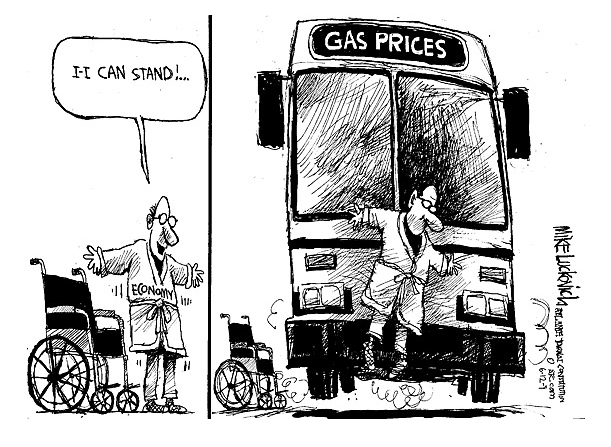
Instead of the steady decline shown in the EIA graph, we may see a period of boom-and-bust cycles where a rising economy causes a rise in fuel prices followed by an economic downturn and falling fuel prices. If this happens, the point at which global demand permanently exceeds global supply may, contrary to all the estimates quoted above, be pushed clear into the next decade. But this does not affect the basic finding that, as a society, we will soon use much less liquid fuel, for several reasons.
First, from here on out, both sides of the boom-and-bust cycle limit the amount of fuel we will be consuming on average. Either we will be employed but unable to afford the high fuel prices associated with a good economy, or we will have lower fuel prices in an economic downturn but be unable to buy any because we’re unemployed.
Second is the fact that the U.S. imports most of its oil. So for us, the question is not how much oil is being produced globally, but how much of it is available for import. And from this viewpoint, the picture looks very dark indeed. All the big oil exporting countries have internal development needs to meet at the same time that almost all of them are producing less oil every year. The combination of increasing internal consumption and decreasing oil production can very quickly send exports from a given country to zero.
A third factor that guarantees less fuel available to us in the future is China’s quiet acquisition of long-term contracts with major oil producers, which will take a lot of oil out of the open market we’ve been depending on to supply our needs.
Finally, the notion that the global economic cycle will be driven by our national vicissitudes is based on the assumption that the world economy depends on the U.S. economy. That’s been true till now, but the moment the Chinese realize that instead of lending us money to buy their products, they can lend themselves the money to buy their products, we fall out of the picture, and at that point we may well find ourselves with a decreasing ability to pay for fuel that is becoming increasingly expensive, with prices driven upward by an Asian economic expansion that has decided to go on without us.
A Dangerous Situation
The more we consider the dependence of our economy on cheap fuel, the more fragile it appears. Everything about the American economy is based on the assumption that growth is inevitable; indeed, compound interest itself—the bedrock of our financial system—is based on this concept insofar as it represents actual growth and not just inflation. Take that growth away, and the whole thing collapses, as we saw when real estate prices stopped increasing.
The unprecedented disappearance of spare liquid fuel production capacity makes the system highly vulnerable to interruptions in supply, as diagrammed here by TCLocal contributor Karl North; a problem with oil production (far left) can set in motion a set of feedback loops that brings down the entire economic system. From this perspective, our current situation is actually rather precarious.
While it’s devoutly to be hoped that we can get past the inflection point of oil production with our society more or less intact, no one should underestimate the downside potential of this development. Another recent objective analysis, this one carried out by the German Army (the Bundeswehr), summed up the consequences of declining oil production for their country this way:
Investment will decline and debt service will be challenged, leading to a crash in financial markets, accompanied by a loss of trust in currencies and a break-up of value and supply chains—because trade is no longer possible. This would in turn lead to the collapse of economies, mass unemployment, government defaults and infrastructure breakdowns, ultimately followed by famines and total system collapse.
There is no reason to believe that the potential damage we could be facing here in the U.S. would be any less than in Germany, which is one of the richest and most advanced countries in the world and one that has put far more effort into transitioning to alternative energy than we have.
The Outlook for This Decade
These considerations lead to the conclusion that the watchword for the coming decade is instability. We will probably cycle between economic hardship and high fuel prices for a while, and this cycle will militate against constructive responses. When the economy is bad, we won’t have the money to spend on sensible measures like alternative energy and mass transit, and when it starts to recover, we’ll tell ourselves that the problem was temporary and that we’ll soon be back to business as usual. It’s an old story: when the roof leaks, it’s raining too hard to fix it, and when it stops raining, a fix isn’t needed…until the whole thing comes down on our heads.
As murky as the future appears, however, some things are fairly easy to predict. Here is a list of things that will probably have occurred, or at least be starting to occur, by the end of this decade.
-
Liquid fuels and energy in general will be more expensive. This one’s easy. Even if we could keep expanding oil production (which no one who has looked into it believes), that oil will become increasingly more expensive to extract as we are forced to look farther out into the ocean for it.
-
Less fuel will be available to use. This is another easy call; either fuel will be too expensive, or we won’t be in a position to buy as much as we used to.
-
We will have begun to stay closer to home. This is already happening. Another way to put it is that life will become more local.
-
Supply chains will have begun to contract. This is another direct consequence of rising fuel prices. The distance that goods travel to market became noticeably shorter in just the few months during which we experienced the last price spike. Consequences include a shift back to more local production.
-
Food (as a percentage of income) will be increasingly expensive. Yet another direct consequence of the increasing price of fuel, which is used in enormous quantities both to produce food and to transport it over long distances. Farm land will increase in value, and farm employment will rise as manual labor begins to replace energy provided by liquid fuels.
-
We may begin to see occasional interruptions in some services (electricity, water, sewer, internet, etc.). This one is not as obvious as the preceding, as none of these services are directly impacted by the price of liquid fuels; but huge quantities of liquid fuel are consumed in maintaining all of these service infrastructures, and rising fuel prices will probably result in deferred maintenance and a possible consequent lack of reliability. I don’t think this is likely before the end of the decade, but it’s certainly a possibility, and one that should be planned for.
-
Rationing of fuel and perhaps even food is possible by the end of the decade. Rationing would demonstrate real sensitivity for the social justice aspects of the situation, so I don’t expect to see it happening any time soon, but it’s a possibility.
Some broader developments are simply continuations of current trends that will be accelerated by high fuel prices and their effect on the overall economy.
-
Our standard of living will continue to fall. U.S. household income in real dollars peaked in 1998-1999 and has been declining ever since. There’s no reason to believe that this trend will be reversed.
-
Fewer financial resources will be available to government. This is another development that’s already underway, and it means that most meaningful responses will have to come from individual efforts or self-organized community action.
-
Providing health care for all will be increasingly difficult. Responses include better health education, free clinics, citizen involvement in county public health advisory boards, and the assumption of greater responsibility for maintaining our own health.
-
Military conflict over resources will become increasingly likely. Which is, of course, why the U.S. Joint Command is so interested in our energy outlook!
Final Thoughts
Three observations come out of all this.
The first half of the decade (2010-2015) looks better than the second half (2016-2020). If you have any major projects in mind, this might be a good time to get going. In particular, this would be a good time to make infrastructure improvements, establish a garden, and move closer to work (or arrange to work closer to home).
The developments listed above as possible by 2020 are virtually certain by 2030. The descent doesn’t stop until we’ve achieved a state of equilibrium with a much lower level of resource exploitation. That transition can be easier or harder depending on how we approach it.
A lot of these developments can be prepared for. And that is the purpose of TCLocal: to begin to plan for the future looming on the near horizon. We hope that the foregoing gives the context for our effort and that the articles we’ve published here are helping us begin to confront and plan for the challenges facing us over the coming decade. The following list provides links to all the articles we’ve published so far.
Fruits in a Post-Peak Tompkins County
by Angelika St. Laurent (January 2008)
Roads and Bridges in a Post-peak Tompkins County
by Simon St. Laurent (March 2008)
Water Treatment, Water Power
by Jon Bosak (May 2008)
Post-Peak Land Use Part 1: Ecocities
by Josh Dolan (July 2008)
Post-Peak Land Use Part 2: The Country
by Josh Dolan (July 2008)
Preparedness Basics
by Katie Quinn-Jacobs (September 2008)
Health Care in an Energy-Constrained Environment, Part 1
by Bethany Schroeder (October 2008)
Local and Urban Small Livestock and Poultry
by Angelika St. Laurent (December 2008)
Wasting in the Energy Descent: An Outline for the Future
by Tom Shelley (January 2009)
Food Processing in Tompkins County
by Persephone Doliner (February 2009)
Examining the Potential Local Foodshed of Tompkins County
by Christian Peters (March 2009)
Can New York State Feed Itself?
by Jon Bosak (June 2009)
Visioning County Food Production, Part 1
by Karl North (July 2009)
Visioning County Food Production, Part 2
by Karl North (September 2009)
Burning Transitions: How Planned, Localized, Sustainable Non-food
Biomass Utilization Can Help Ease Energy Descent and Mitigate
Global Climate Change
by Krys Cail (October 2009)
Health Care in an Energy-Constrained Environment, Part 2: Options
for Re-evaluating Care Resources
by Bethany Schroeder (November 2009)
Heating with Biomass in Tompkins County
by Krys Cail and Tony Nekut (January 2010)
Visioning County Food Production, Part 3: Seeing County Food
Production as an Integrated Whole
by Karl North
(February 2010)
Funding and Finagling the Transition to Biomass Heat and
Power
by Krys Cail (April 2010)
Visioning County Food Production, Part 4: Urban
Agriculture
by Karl North (May 2010)
Visioning County Food Production, Part 5: Peri-urban
Agriculture
by Karl North (June 2010)
Visioning County Food Production, Part 6: Rural
Agriculture
by Karl North (July 2010)
